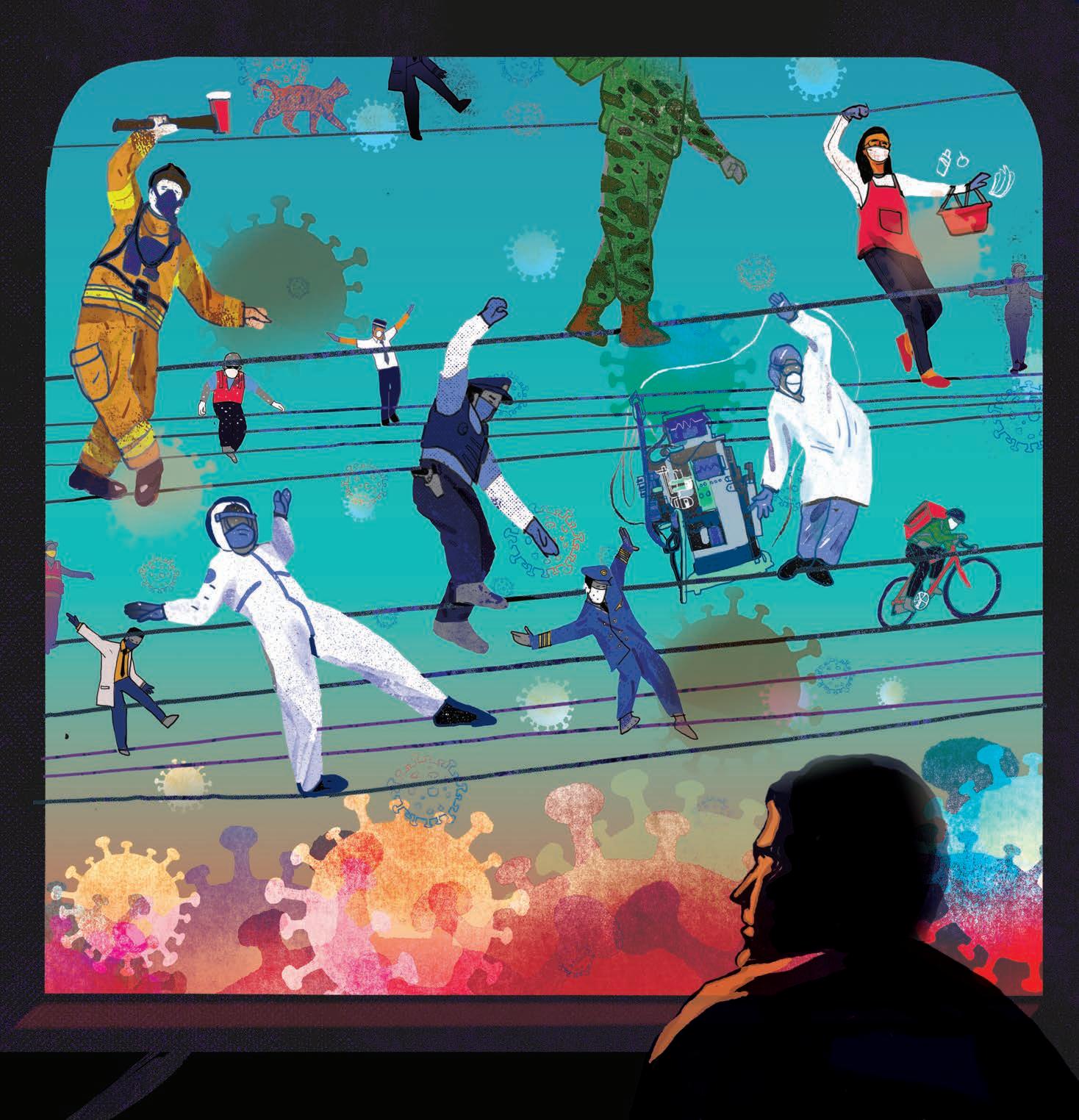

CHICAGO’S FREE WEEKLY SINCE 1971 | APRIL 9, 2020
CHICAGO READER | APRIL 9,
| VOLUME 49, NUMBER 27
CITY LIFE
03 Sightseeing The deaths of nearly a thousand sailors at Great Lakes Naval Training Station in 1918 hold lessons for the COVID-19 pandemic.





home and others man the front lines of coronavirus transmission, the census goes on.
10 Dukmasova | Housing A leaked video chat reveals the city’s landlords are concerned over staff “decimation” and the optics of “stepping” on tenants.
12 Reid | News The American Sign Language interpreter for the governor is in the spotlight, but he wants us to know more about the Chicago Hearing Society’s services.
THEATER
19 Dance Dancers figure out how to create in isolation.

FILM
22 Small Screen The digital television platform OTV is thriving.
23 Movies of note Never Rarely Sometimes Always is a slow-moving film, but these young women will stay with you long a er the film ends; There’s Something in the Water is crucial viewing for anyone who cares about the lasting ripple effects of environmental neglect.
ARTS & CULTURE
FOOD & DRINK
05 Feature Join the virtual quest for the perfect melon.
NEWS & POLITICS
07 Joravsky | Politics Somehow we’ve elected a Joe Exotic as president of the United States.
08 Count As some hunker down at
14 Community Why basement wet bars just won’t do when we’re sheltering in a collapsed place.

16 Visual Art How canceled BFA and MFA shows are persisting during the crisis.
18 Podcast A new bilingual show puts a microphone to the local Latinx community.
MUSIC & NIGHTLIFE
24 Galil | Feature The saga of Punkin’ Donuts: How a doughnutshop parking lot became a confluence of Chicago youth subcultures—and what killed it off.
30 Shows of note A pandemic can’t stop the fl ow of great music. Our critics review releases that you can enjoy at home.
34 The Secret History of Chicago Music The untold story

Mantegna’s teenage garage
Apocryphals
Gossip Wolf Mavis Staples drops a benefit single to help Chicago seniors survive the pandemic, Mukqs embarks on a weekly series of live-recorded experimental EPs, and more.

OPINION
Savage Love Dan Savage offers advice to someone who wants to send a pervy care package.
CLASSIFIEDS
A NOTE FROM THE CREATIVE LEAD
FIGURING OUT WHAT to put on the cover of each Reader issue is one of the most rewarding and at times most stressful aspects of my job. When a cover really comes together, it’s a beautiful thing: I rush into the o ce on Wednesday morning to see the newly printed copies, basking in the glow of the final product.
There’s been no office to rush into for the past month—the entire Reader editorial process, from pitches to proofs, happens remotely. Still, my life is among the least upended by the coronavirus—I still have an apartment to lounge around in, a paycheck to cover my bills, and a paper to design every week. For
this week’s cover, the publisher suggested that we pay tribute to the essential workers—the grocery store clerks, gas station attendants, doctors, pharmacists, postal workers, and others—whose lives have been so gravely impacted by the pandemic. In an e-mail to the illustrator, Nguyen Tran, I described these workers as “putting their lives on the line,” which Nguyen took as inspiration to depict these workers on a literal tightrope walk, the disease roiling beneath them.
I love this cover because it beautifully represents the precarity in which these workers now find themselves. Many call these workers “heroes,” and while their e orts are in large
part what separate us from an even more horrifying social collapse, I think the term obfuscates the fact that many of them put themselves in harm’s way every day simply because they have no other choice. That a cashier making $12 an hour could have no choice but risk their lives every day is indicative of our profound political failure to protect the most vulnerable in this country. We cannot go “back to normal” after this crisis has ended, because the seeds of its cause were embedded in “normal” from the beginning. Whatever comes out of this situation, I can only hope that it is more equal and more just than what preceded it. RACHEL HAWLEY
TO CONTACT ANY READER EMPLOYEE, E-MAIL: (FIRST INITIAL)(LAST NAME) @CHICAGOREADER.COM
PUBLISHER TRACY BAIM
IN CHIEF SUJAY KUMAR, KAREN HAWKINS CREATIVE LEAD RACHEL HAWLEY
EDITOR PHILIP MONTORO THEATER AND DANCE EDITOR KERRY REID CULTURE EDITOR BRIANNA WELLEN ASSOCIATE EDITOR JAMIE LUDWIG
SENIOR WRITERS MAYA DUKMASOVA, LEOR GALIL, DEANNA ISAACS, BEN JORAVSKY, MIKE SULA EDITORIAL ASSOCIATE S. NICOLE LANE GRAPHIC DESIGNER AMBER HUFF
LISTINGS COORDINATOR SALEM COLLO-JULIN CONTRIBUTORS ED BLAIR, NOAH BERLATSKY, LUCA CIMARUSTI, MARISSA DE LA CERDA, MARI COHEN, JOSH FLANDERS, SHERI FLANDERS, JACK HELBIG, IRENE HSAIO, CATALINA MARIA JOHNSON, MONICA KENDRICK, STEVE KRAKOW, NOËLLE D. LILLEY,JAMIE LUDWIG, MAX MALLER, ADAM MULLINS-KHATIB, J.R. NELSON, JEFF NICHOLS, MARISSA OBERLANDER, MATTHEW SIGUR, CATEY SULLIVAN
DIRECTOR OF DIGITAL JOHN DUNLEVY DEVELOPMENT ASSOCIATE COLETTE WILLARD SOCIAL MEDIA COORDINATOR JANAYA GREENE MEDIA PARTNERSHIPS COORDINATOR YAZMIN DOMINGUEZ
STAFF AND SPECIAL PROJECTS ASSISTANT TARYN ALLEN
SPECIAL EVENTS CONSULTANT KRISTEN KAZA
ADVERTISING
312-392-2970, ADS@CHICAGOREADER.COM CLASSIFIEDS: CLASSIFIED-ADS@CHICAGOREADER.COM
SALES DIRECTOR PATTI FLYNN
VICE PRESIDENT OF SALES AMY MATHENY CLIENT RELATIONSHIP MANAGER TED PIEKARZ SENIOR ACCOUNT REPRESENTATIVES
LENI MANAA-HOPPENWORTH, LISA SOLOMON ACCOUNT REPRESENTATIVES
GREG MCFALL, NANCY SANCHEZ
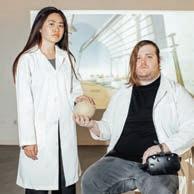
CLASSIFIED SALES MANAGER WILL ROGERS
NATIONAL ADVERTISING VOICE MEDIA GROUP 1-888-278-9866 VMGADVERTISING.COM
JOE LARKIN AND SUE BELAIR
DISTRIBUTION CONCERNS distributionissues@chicagoreader.com 312-392-2970

CHICAGO READER L3C
BOARD PRESIDENT DOROTHY R. LEAVELL
TREASURER EILEEN RHODES
SECRETARY JESSICA STITES
AT-LARGE SLADJANA VUCKOVIC
CONSULTANT CAROL E. BELL
READER (ISSN 1096-6919) IS PUBLISHED WEEKLY BY CHICAGO READER L3C 2930 S. MICHIGAN, SUITE 102 CHICAGO, IL 60616 312-392-2934, CHICAGOREADER.COM
COPYRIGHT © 2020 CHICAGO READER PERIODICAL POSTAGE PAID AT CHICAGO, IL

ALL RIGHTS RESERVED. CHICAGO READER,

2 CHICAGO READER - APRIL 9, 2020 ll
of Joe
band the
35 Early Warnings Rescheduled concerts and other updated listings 35
36
38 Jobs 38 Apartments & Spaces 38 Marketplace
EDITORS
MUSIC
READER, AND REVERSED R: REGISTERED TRADEMARKS ® THIS WEEK
2020
IN THIS ISSUE ON THE COVER: ILLUSTRATION BY NGUYEN TRAN. FOR MORE OF TRAN’S WORK, GO TO LEFTSTUDIO.COM.
The ghosts of Great Lakes
The deaths of nearly a thousand sailors at Great Lakes Naval Training Station in 1918 hold lessons for the COVID-19 pandemic.
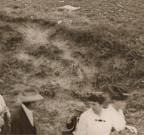


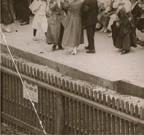
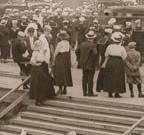

 By JEFF NICHOLS
By JEFF NICHOLS
In 1918 less than 40 miles north of Chicago, an insidious illness killed twice the number of naval personnel in two months than combat did during the entire First World War. The so-called Spanish influenza swept through Great Lakes Naval Training Station “like the Black Plague,” recalled Martin Birkham, a YMCA volunteer at the training station. The hard choices made at Great Lakes should haunt us today.
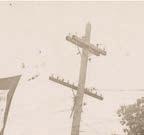
Dedicated as a boot camp for naval recruits from across the midwest, Great Lakes Naval Training Station opened in 1911. After the United States declared war against Germany in April 1917, the commandant of Great Lakes, Captain William A. Moffett, was left with only four officers on his staff. New recruits at Great Lakes, like those at other training camps, lived in gold rush conditions, sleeping in tents anchored in muddy fields.
A native South Carolinian, Moffett represented a character familiar to Chicago history—the charming out-of-towner turned master insider and big builder. Authorized to enroll officers as naval reservists, Moffett drew the managerial elites from the north shore and Chicago. A crew of 1,200 enlisted men hammered an average of one thousand pounds of nails a day to build their barracks.
From its original 187-acre campus, Great Lakes expanded to more than 775 buildings spread over 12,000 acres.
Moffett was especially gifted at public relations. Day-tripping dignitaries, sightseers, and families of recruits routinely visited the station for concerts, sporting events, air shows, and enormous displays of precision drilling. The press fawned over the station.
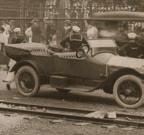
“It is not only that faces, throats and arms are tanned to the gleam of precious metal, and


The station’s openness became its weakness. COURTESY NATIONAL ARCHIVES-COLLEGE PARK
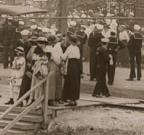




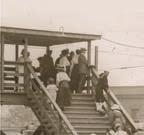

that the treasure of youth, divine youth at the zenith of its physical perfection, glistens through the close-fitting summer uniforms, from lithe sinew and resilient muscle, like an incandescent wire blasting through its globe of glass,” wrote the St. Louis Post-Dispatch.
The Great Lakes Naval Revue, which included budding comedian Benjamin Kubelsky (later known as Jack Benny), played the midwest theatrical circuit to popular acclaim. The undefeated football team, whose lineup included George Halas, won the Rose Bowl. Barnstorming across the country, John Philip Sousa and his Great Lakes Band Battalion raised tens of millions of dollars for war bonds and war charities, a very handsome return on the $40,000 appropriated for band instruments.
These efforts served not only the cause of naval recruitment, but also the mission of instilling discipline and defusing tension with the station’s wealthy neighbors. The station was within walking distance of Waukegan, on the same train line that served the north shore. In some of the wealthiest neighborhoods in the midwest, families opened their homes to sailors, who might have been tempted to visit taverns and brothels in Chicago. During their two-day leaves, the “clubs, homes, automobiles and young ladies are at our service,” Leo Bouton, a sailor apprentice, wrote a pen pal. Hundreds of civilians worked as unpaid volunteers within the station and at naval clubs in their communities.
The openness of the training station, which allowed it to thrive as a model city, would be its great weakness. Influenza was first reported on September 7, 1918, introduced to Great Lakes by sailors transferring from Boston. Naval health officers knew that the epidemic would eventually cross the Atlantic, but, as the Navy Surgeon General wrote the distressed health commissioner of Boston, “under war conditions it would have been futile to attempt to quarantine against its introduction into this country.”
For any other epidemic, Great Lakes probably would have been one of the safest places to be. The concern over contagious diseases had led the training station to consult an architect of tuberculosis sanitariums. The station had at its disposal a state-of-the-art hospital staffed with a thousand apprentices enrolled at its Hospital School. Unlike public health officials
in the civilian world, the Navy was both willing and able to discipline their charges for the smallest derivations in healthy living. One sailor apprentice, Royal Bauer, recorded in his diary how an officer found a recruit with a grimy neck. He ordered the company to strip and scrub the sailor with hard brushes, soap, and 50 pails of water. But this epidemic, which effortlessly crossed over quarantined dorms, was unusually lethal to young men and women. Ominously, many hospital corpsmen, even ones wearing gauze masks, became incapacitated while tending to their patients. The labs at Great Lakes worked futilely to isolate the “influenza germ” behind the epidemic.
The training station’s newspaper dubbed influenza “the unwelcome visitor.” Even as the hospital and sick bays filled with sailors, the first week of the epidemic did not inspire terror. “It begins with high fever. Most get real weak and collapse,” sailor apprentice Harney Stover wrote his parents. “I probably will get it. I don’t think I will be very sick.”
Reservists who contracted the flu simply went home to recover. After receiving mandatory nose sprays, hundreds of sailors left on weekend passes for the north shore. Stover, who went on leave after helping sick mates, believed the iodine nose spray protected him from infection. “The sailors who have been about Waukegan during the past few days have been sneezing and coughing and buying ‘dope’ for their noses and throats,” commented the Waukegan Daily Sun
Great Lakes Naval Training Station became the beachhead of the epidemic in Illinois. Like a number of medical experts at the time, the command at Great Lakes maintained that influenza was spread in indoor gatherings and poorly ventilated rooms, but not “in the open.”
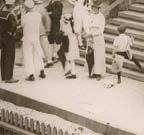

By the time Great Lakes rescinded liberty for enlisted men on September 19, roughly ten percent of the training station had reported ill with influenza.
In the press, the training station worked hard to present optimistic news while appealing to the community for badly needed material such as bedding. Contrary to his own clinical findings, the station’s chief medical officer, Lt. Owen J. Mink, informed reporters that 95-98 percent of his influenza cases were mild. Mink admitted that there were 4,500 total cases of influenza, with 1,000 serious cases and 100 deaths. With the math supplied, the Tribune concluded that the death rate was “comfortingly low in consideration of the wide sweep of the disease.”
APRIL 9, 2020 - CHICAGO READER 3 CITY LIFE
sightseeing
continued from 3


























The Chicago Evening Post reasoned that Great Lakes must have the epidemic under control, as it still welcomed visitors. “None would even think the station is quarantined,” Stover wrote to his parents. On September 21, Chicago lawyer Oscar Miller had dinner with an officer at Great Lakes. In his diary, he detailed lunch menus but made no mention of influenza, despite the fact that 931 sailors were added to the sick list that very day. Only at the peak of the epidemic did Great Lakes cancel highly popular public review of marching bands and precision drilling.



Although newspapers paid homage to individual sailors who died at Great Lakes, the harrowing climb in the number of deaths due to pneumonia and other influenza-related complications received scant attention. “The people on the outside don’t get the news and happenings as they really are, they don’t publish them as they figure it discourages and makes the relatives of the enlisted men here feel uneasy, as no doubt it does,” Leo Bouton, who had recovered from the flu, confided in a letter that slipped through the censor.
Though Lt. Mink warned that people in cities should remain at home and avoid crowded indoor facilities other than the workplace, the scope of the epidemic’s lethality was not readily apparent to those communities that had not yet witnessed its effects. “I do not feel much alarmed about the Spanish Influenza,” Evanston banker Rufus Dawes wrote to his brother. “It will take its toll on the old and the weak.” Privately, the commander of Great Lakes Hospital authorized leaves for convalescent cases who were “depressed to the point of loss of interest in all things,” a state in part attributed to the “contact of great numbers of desperately sick and dying mates.”
Overwhelmed with panicked relatives at its gates wanting to know about men in quarantine, the command at Great Lakes had reason to fear the true dimensions of the epidemic becoming known. Josie Brown, a recent graduate of nursing school, had read about the flu in the papers on her way to Great Lakes. The young naval nurse was placed in a ward of 42 seriously ill men, some without beds, some delusional with high fevers. Josie worked 18 hours a day. In several instances, medical staff “had to be ordered off duty as it was evident that they had overworked and would break down under the physical strain and mental distress that they were suffering,” the Department of the Navy later noted. Seven nurses died at Great
Lakes.

There simply was not enough trained medical staff to go around for sailors. Robert St. John, a 16-year-old Oak Parker who had lied about his age to join the Navy as a means to impress girls, found himself struggling for air for several days. “No one ever took our temperatures and I never even saw a doctor,” he recalled. A friend died next to him.
Katherine Bacigalupo received notice that her son had fallen ill at Great Lakes. After waiting six hours at the hospital along with her sister, she begged a passing chaplain for help. He arranged for a four-minute pass, a rare exception given only for men close to death. Surrounded by dying sailors, Katherine’s son was lying in a drill hall. There were bloodstains on his lips, flies crawling on his face. Returning to the hospital, she demanded to take her son to Waukegan. The commander of the hospital explained that he would die in transport and there were no doctors there that could help him. Katherine received word shortly after that her son had died.

“I started to keep a record of the number of deaths at which I was present,” one chaplain wrote, “but found it impossible to continue.”



















“The morgues were packed almost to the ceiling with bodies stacked one on top on another,” Josie Brown recalled. Even in her sleep she heard the noise of trucks backing up to the morgue. In her dreams, she pictured live sailors being trapped underneath the stacks of dead recruits.



Between September 12 and October 11, 1918, Great Lakes Naval Training Station recorded 9,623 cases of influenza, with 924 deaths. Great Lakes presented half-truths about the epidemic in large part to protect the war effort, which demanded full participation by healthy young men. Guided by a tragically incomplete understanding of how influenza was transmitted, Moffett and his staff chose not to reveal that Great Lakes Naval Training Station had been the site of heroic failure and lonely death.
If you are appalled by what happened at Great Lakes Naval Training Station, you should consider how history will judge us, not only for the lies told in service of a partisan political war, but also our own self-deceptions in the face of our “unwelcome visitor.” What has not changed over 102 years is that when hospitals are pushed beyond their capacity during a catastrophic pandemic, patients and medical staff die cruel deaths that can easily remain secrets. v


4 CHICAGO READER - APRIL 9, 2020 ll CITY LIFE
@backwards_river
Due to business closings and for safety purposes, the Chicago Reader is going biweekly with a print run to 600+ locations, including our box route. On the o weeks (April 9, 23, May 7) the Reader is just being distributed as a free PDF, with a small press run to ful ll subscriber and library mailings. We are also making a limited number of copies available for special short-term subscriptions, 12 weeks for $50, and every week’s issue will be mailed to your home. Just a few hundred copies will be sold of these very limited souvenir editions of the Reader: secure.actblue.com/donate/chicago-reader-print-12 Important Reader News Thank you, The Reader team Find the full curated PDF download of the Reader at by Wednesday each week. chicagoreader.com/issues
Join the virtual quest for the perfect melon


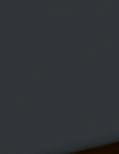


The search party will set off in an infinite field of fruit.





































 By MIKE SULA
By MIKE SULA
You’re standing in pure sunlight in a crystal pavilion levitating over an infinite green melon patch. You move into the structure and pedestals rise from a platform, each one supporting a perfectly spherical melon.





But is it really a perfect melon?
There’s only one way to know. You reach out and slap it: doink! It sounds like a deflated basketball hitting the floor. Probably not perfect. You reach for another, and this one resonates: sounding somehow at once dense and hollow, a melon of sweet substance. You decide that this could be the one, and with a squeeze of your hand, a honeyed, floral, fruity liquid squirts into your mouth.
It’s perfect.

Meanwhile, a soothing disembodied narrator congratulates you: “We made this,” she says. “Together.”










































Welcome to Perfect Melon , a “community-building” marketing campaign from the Perfect Melon beverage corporation, whose intention isn’t just to sell a soft drink, but “to bring people closer to nature.”

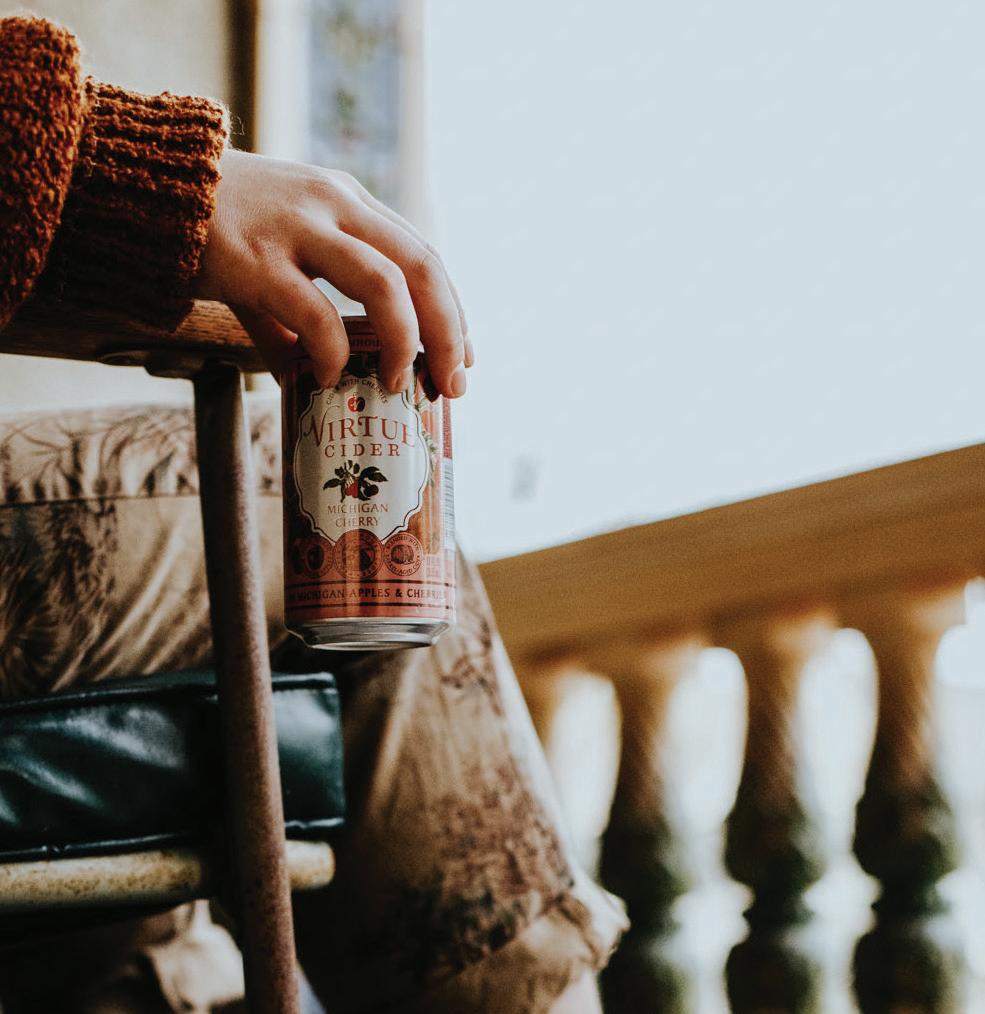
The fictional corporation and marketing campaign are the creation of artists Jas Brooks, Li Yao, and Gabby Luu (who also supplies the voice in your head). They aren’t overearnest pseudoscientific corporate drones, but they play them in Perfect Melon, a prototype virtual reality performance installation that has taken on added resonance in the new waking nightmare of mass self-isolation.
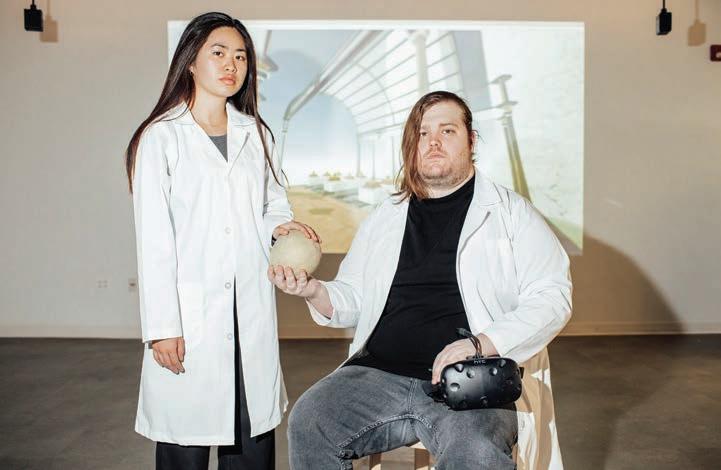
In the real world, there may not be a more physically intimate experience than melon selection. You eyeball the colors and shapes. You lift one and measure its heft. Hold it to your nose and sni . Critically, you give it a thump.
“But what does it mean for the melon to sound good?” asks Luu, a Los Angeles-based artist who recently earned a master’s in art history at the University of Chicago. “Everyone has a shifting idea of what that is.” That’s one of many absurdities that sprout from this virtual melon patch whose architecture was inspired by the Crystal Palace that was home to London’s Great Exhibition of 1851, a structure that was “a manifestation of human architectural power
APRIL 9, 2020 - CHICAGO READER 5 FOOD & DRINK
Gabby Luu and Jas Brooks
JEFF MARINI FOR CHICAGO READER
FOOD FEATURE
Search the Reader’s online database of thousands of Chicago-area restaurants at chicagoreader.com/food

continued from 5
[attempting] to perfect nature,” according to Yao, who earned his MFA in art and technology at the School of the Art Institute and is designing the virtual universe of the melon patch.
Brooks is the artist constructing the very real backpack that will contain a “taste display” that pumps randomized liquid flavor combinations into the mouths of players each time one approves of a melon’s sound and elects to taste.
“The basic idea is you enter a virtual melon patch that is infinite, which is absurd,” says Brooks. “You’re given a task—which makes no sense—where you’re supposed to find a perfect melon: what you believe a melon should taste like. So you’re put on this infinite quest in VR, basically picking up melons and interacting with them in ways that are deemed natural but mean nothing.”
The people of Perfect Melon got together in 2018 during an ad hoc gathering of artists, students, and researchers that met on Saturdays at the MCA. “We wanted to see if we could make a group of people that were interested in flavor as a medium,” says Brooks, who is working toward a PhD in computer science at the University of Chicago, focusing on “wearable devices
that modulate our sense of smell and taste.”
The group researched and did a lot of tasting— MSG, salt, citric acid, sugar, caffeine—“in an attempt to isolate di erent tastes,” says Luu, eventually graduating to a variety of Asian melon-flavored soft drinks such as Binggrae Melon, Melon Ramune, and Suika Watermelon Soda.
“We focused on the melon as an image because of the Japanese food culture of cultivating perfect foods as gifts,” says Luu, referring to the country’s appetite for obsessively nurtured and fetishized hand-massaged fruit.
For the last year and a half, much of the narrative, virtual, and mechanical work on Perfect Melon has taken place at the University of Chicago’s Media Arts, Data, and Design Center. That’s where Yao fitted me with a tetchy VR headset to get a look at an infinity of melons, and I took whiffs from the bottles of ethyl butyrate, ethyl 2-methylbutyrate, and ethyl formate that are the first compounds Brooks secured for the pump-straw mechanism.
“One of our goals is to be able to stream all of the information of what players choose as their perfect melon,” says Luu. “Then mix those and create an average flavor for the perfect melon that people can then taste.” The ultimate goal
was to test and tweak over the summer and go live in September with the three artists donning lab coats and guiding players through the game, staged on a carpet of artificial grass.
But they had a lot more work to do before they were ready to invite an audience to crowdsource the perfect melon. For one thing they still needed more synthetic flavors, which, as it turns out, aren’t simple to get ahold of.
Another challenge loomed: “We’re starting to develop a full sanitization protocol,” says Brooks. They were imagining interchangeable metal straws that could be swapped out each time a new player donned the backpack and headset, and sterilizing the used ones with ultrasonic baths and UV light.
All of this would require funding. Grant applications were in the works.
A month later, after the university shut down the campus, we all spoke on the phone. Luu was sheltering in place in LA but looking for work. Yao was applying for an online teaching gig in Shanghai after emerging from self-quarantine; a colleague’s wife was potentially exposed to COVID-19 but eventually tested negative.
The trio didn’t seem to think that the pandemic meant the end of the infinite quest for the
perfect melon. The lab where Brooks worked had been shut down, but they’d brought home a distillation unit and a VR headset and were continuing to work on the taste display. But, they say, “the reality is, people are not gonna be as open to interacting with this very strange, intimate interface.”
If anything, the pandemic underscored many of the themes Perfect Melon was meant to address: isolation, community, and “our thesis about how reality is constructed by corporations,” Yao says.
With Starbucks giving out free co ee to first responders, and Louis Vuitton pivoting from perfume to hand sanitizer, “it really hearkens back to corporate mobilization during wartime efforts,” says Brooks, something that ought not to be entirely trusted. “An opportunity for future profit.”
“In this moment it’s really highlighting the way corporations see themselves as community members,” says Luu. “It’s not a great situation to be in, but it’s unfolding before our eyes. These are things to continue thinking about.” v
@MikeSula
6 CHICAGO READER - APRIL 9, 2020 ll FOOD & DRINK
Chicago's Free Weekly Since 1971 We Couldn't Be Free Without You— Support Community Journalism EARLY WARNINGS Find a concert, buy a ticket, and sign up to get advance notice of Chicago’s essential music shows at chicagoreader.com/early.
President Tiger King
By BEN JORAVSKY
When I started watching Tiger King the hit Netfl ix series—I was like the rest of you, hooting and howling at the show’s weird and wacky characters.
I’m still laughing at them. I mean, the show is funny. And the characters are weird. No, they’re insane. That’s the word that fits. It’s a nuthouse of colorfully kooky characters who shamelessly pose for the camera, oblivious to how ridiculous they seem.
It’s like they think they’re TV stars but they don’t realize we’re really laughing at them. Like they’re not in on the joke—they don’t get it that we’re superior to them.
But having seen the fi nal episode I realize that directors Eric Goode and Rebecca Chaiklin were on to something greater. Tiger King
is a parable for politics in the age of Trump.
Don’t laugh too much at these characters, folks. They’re not really all that different from the people you’ve been voting for. Not much di erent than you and me.
OK, if you haven’t seen the show, be warned: spoiler alert!
Even if you haven’t seen it, you probably know—it’s a seven-part documentary about people who love big cats (lions, tigers, and man-made hybrids like ligers) just a little too much.
If the show has a protagonist, it’s Joe Exotic. In the Tiger King universe, he’s Donald Trump—a bu oonish charismatic caricature of himself. The Hillary Clinton of Tiger King is Carole Baskin, Joe’s nemesis, in all her oily,
insincere, and sanctimonious glory.
Of the two, I must confess I like Joe more than Carole. Though in the real world of politics, I voted for Hillary—and would do so again.
It’s just that Joe seems a little less frightening than Carole. Which is odd, as he’s the one serving a 22-year sentence for hiring a hit man to kill her. Not the other way around.
Like Trump and Hillary, Joe and Carole have their followers. Though here the roles are reversed. If Carole reminds me of Hillary, her followers behave like straight-up MAGA hatters.
Not that any of them literally wears the hat. Just that they’re awestruck devotees who gobble up any old bullshit Carole feeds them. And she feeds them a lot.
Remember how Trump bragged, “I could stand in the middle of Fifth Avenue and shoot somebody and I wouldn’t lose any votes”?
Well, there’s reason to suspect that Carole killed one of her husbands (she’s had three). And still her fans volunteer their time to her Big Cat Rescue park.
She’s selling them something they really want to buy—in this case, the notion that they’re saving the big cats they actually keep in cages.
Joe’s followers are a little more cynical, more pragmatic. Think of the Democratic operatives who worked for Michael Bloomberg’s ill-fated presidential campaign. I doubt they really believed in Bloomberg—but his money was too good to turn down.
OK, so Joe’s followers aren’t making anything resembling Bloomberg cash. He gave them little more than pocket change, a place to crash, and food—albeit old meat discarded by Walmart.
They took it because they had no choice— many had just gotten out of prison or rehab. They certainly had no illusion that Joe was anything other than a shameless, self-promoting con man.
Shamelessness, self-promotion, and con jobs are just some of the things Joe and Trump have in common. These two are so similar, it’s like they were separated at birth.
They both have bad hair. They’ve each been through wretched marriages. At one point in the series, Joe, who’s gay, is married to two men who are not. It’s a long story.
OK, so at least Trump’s no polygamist. But
he’s played around on every wife he’s ever had—Melania included.
And say this about Joe—no one’s ever accused him of rape. As far as I know. There are 23 women who have accused Trump of everything from sexual assault to rape—not that the MAGA-hat crowd seems to care.
Politically speaking, Trump and Joe are raging egomaniacs who have settled on a probusiness, anti-government, lower-taxes, guns-for-all ideology largely because it’s a pitch they know their audience wants to hear. Who knows what they really believe in.
Joe ran for o ce twice. In 2016, he ran for president as a Libertarian. John Oliver had a field day making fun of his campaign antics.
But then the media made fun of Trump when he launched his campaign. Back in 2015, the Huffington Post announced it was only going to cover his presidential campaign in the entertainment section.
For years, David Letterman and Howard Stern were Trump’s enablers, inviting him on their shows so he could build his brand in front of millions.
Letterman and Stern were laughing at Trump—just like Oliver laughed at Joe. And then, Trump was president—and the joke was on them.
In 2018, Joe ran for governor of Oklahoma. He finished third in a three-man race, winning 19 percent of the vote.
To be clear, that’s 19 percent of the vote in the Libertarian primary. So it’s not as impressive as it looks when the fi lmmakers fl ash it on the screen. All told, he got 664 votes.
But before you laugh at those 664 yahoos in Oklahoma, remember this: in 2018, a neo-Nazi named Art Jones won more than 57,000 votes running as a Republican for Congress in the Third District of Illinois, which runs from Bridgeport to the southwest suburbs.
You could argue that, in contrast, Oklahoma’s voters showed more restraint.
The point is—we’ve entered an age where the abnormal is the normal. Any lunatic can aspire to any o ce, including the highest in the land.
Is Joe more insane than Trump? Hard to say. Though last I heard, Joe had been put in isolation after another prisoner tested positive for COVID-19.
Laugh all you want at Joe Exotic, but at least he knows the pandemic is not a hoax. v

APRIL 9, 2020 - CHICAGO READER 7 NEWS & POLITICS
For starters, both Joe Exotic and Donald Trump have catastrophic hair. TIGER KING
@joravben POLITICS
Somehow we’ve elected a Joe Exotic as president of the United States.
How to count in a pandemic
As some hunker down at home and others man the front lines of coronavirus transmission, the census goes on.
By KIRAN MISRA
Census self-response opened on March 12.
The next day, “we were in the full throttles of the health pandemic,” Anita Banerji of Forefront, a civic organization that coordinates grantmakers and community nonprofits, recounts.
On the 13th, Illinois Governor J.B. Pritzker announced statewide school closures through the end of the month, casinos and churches alike shuttered, and the Circuit Court of Cook County declared a moratorium on evictions and foreclosures.
Self-response is the first phase of census survey completion, in which households mail back their own census forms or voluntarily complete the census by phone or e-mail. The census bureau then attempts to count all remaining households through a round of in-person outreach following the self-response deadline. During this period, there is a risk and fear that many may be miscounted or missed altogether.
Lili Scales, advocacy director at CHANGE
Illinois, had been coordinating a series of census ads with the Illinois Farm Bureau to air on radio when the city started to shut down. “But what is their reach going to be now?” Scales asks. “People aren’t, you know, listening to the radio on their way to work. There are census ads on Michigan and Monroe and State and Monroe, but no one’s out. How do you see that?”
At Pilsen’s Mujeres Latinas en Acción, plans for census outreach were well underway when the virus hit: weekly education efforts that regularly reached hundreds at the Mexican consulate, Saturday morning canvassing trips where promotoras (census outreach workers) and volunteers regularly knocked on over 700 doors in a single morning, and one-on-one conversations with community members. These have all been put on hold indefinitely.
“We are still receiving a positive response through phone banking, but the lack of direct contact and communication makes it challenging to truly connect,” explains Monica
Paulson, advocacy manager at Mujeres Latinas en Acción. “In the last week we’ve made over 1,400 calls.”
Rather than putting census e orts on hold as the city shuts down, community organizations are doubling down as some residents plan to spend the next few weeks socially distanced in their homes and many of the city’s most vulnerable man the front lines of coronavirus transmission as delivery drivers, warehouse workers, or grocery employees. For many, this moment adds a new sense of urgency to the census issue.
“There are a lot of organizations that are working double, triple time to make sure that we get an accurate count,” says Inhe Choi, executive director of the HANA Center. “We see in the news how, as a state, we’re not receiving even a percentage of materials that we’ve been asking for from the federal government for COVID. And so this is so, so important.” Because this count will not truly be over until the end of this calendar year, current relief e orts will not be impacted by the upcoming census count. But Choi is thinking ahead. “This information will a ect us in the next epidemic or pandemic, our disaster response in the next ten years. It just feels extra heightened now, more than it ever has been.”
According to the Illinois Department of Human Services, even a 1 percent undercount would result in the state losing $35 million in federal funding for critical public services like
roads, hospitals, schools, and fire stations.
Disaster response in the decades to come isn’t the only thing that could potentially be significantly impacted by a lower response rate on the 2020 census. So could our representation in Congress. Illinois is one of four states which has seen its population decline since the 2010 census and is one of ten states that is projected to lose at least one seat in congressional representation as a result of the 2020 census. “And if we don’t bring it, if we don’t get all of our historically undercounted populations counted in the next few months, there’s a very real fear that we could lose that second seat and the federal dollars we rely on,” says Banerji.
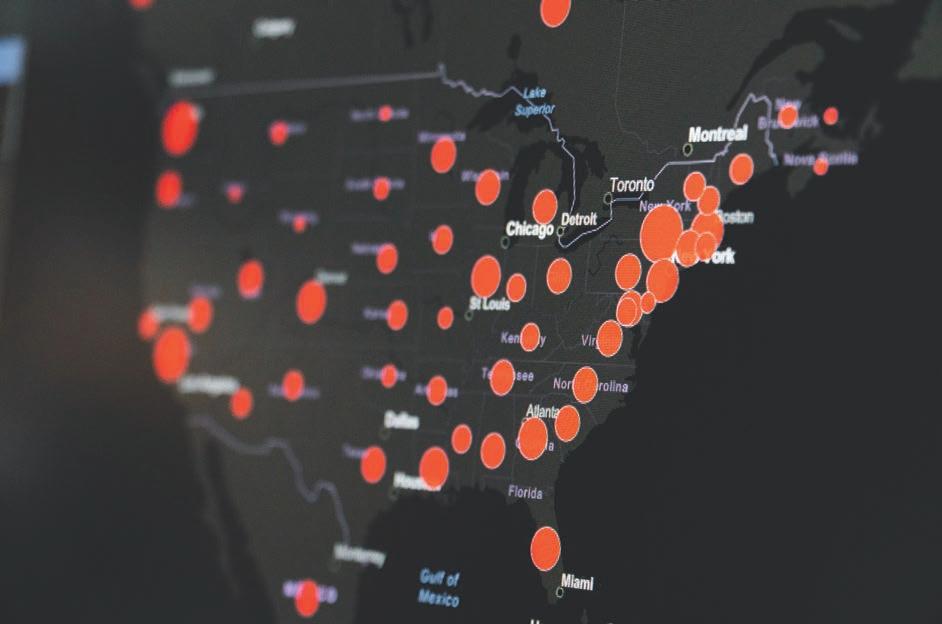
Illinois is currently ranked ninth in the country for census self-response, with more than 37.6 percent of our households counted. But Cook County has a lower rate of response than nearly all other counties in Illinois, rivaled only by a few tracts on the southern and western edges of the state. As of April 6, 44.8 percent of Cook County residents had sent in their self-responses by mail, phone, or online, as compared to the 66.1 percent fi nal self-response rate in Cook County in 2010.
In response to the spread of the coronavirus, the United States Census Bureau has extended the self-response period by 14 days, to August 14, and has modified and delayed many of its planned survey e orts, as well as suspended all field operations for now.
Organizations aren’t taking for granted that the census bureau’s measures will be enough to get out the count in and of themselves.
“We’re working to ensure there are flyers, palm cards, and materials at grocery stores, community centers, clinics, and other essential locations that are likely to remain open,” says Patrick Laughlin from the Illinois Department of Human Services. “And with so many residents staying at home to slow the spread of COVID-19, people are online more than ever. We are launching a robust marketing and messaging campaign on social media platforms like YouTube, Twitter, Facebook, Instagram, Snapchat, and running commercials on inhome streaming networks to reach hard-tocount populations at home.”
Others like Forefront and the Pilsen Neighbors Community Council are also choosing to distribute literature in lieu of face-to-face contact and are turning to virtual public forums like Facebook Live, digital town halls, and webinars. “There are a lot of people that are watching TV more now than they ever have before. So how do we get national ads? How do
8 CHICAGO READER - APRIL 9, 2020 ll
The fi rst phase of census survey completion began as the virus was declared a pandemic.
MARTIN SANCHEZ / UNSPLASH
CENSUS
we get local ads onto streaming sites? How do we do more videos that we can share with our family and friends via texting?” asks Banerji.

At Mujeres Latinas en Acción, census promotoras are starting at home, calling their friends and family to spread the word about the census; the organization’s direct service sta manning the organization’s hotline and providing telecounseling to community members are also encouraging callers to fi ll out the census.
But having these conversations can be hard when members of Chicago’s hard-to-count communities have already been thrust into instability as the virus spreads, with many non-census concerns on their mind. Korean Americans served by the HANA Center have been impacted by the coronavirus already, as many work cash-based jobs, are losing cleaning shifts, or are working overtime at grocers. “We can call to then just remind them that organizations like United Way and the Chicago Community Trust are providing us with relief funds for our communities, then remind them about the census. But it’s hard to push them in this moment, you know, when they are worried about day-to-day,” says Choi.
But she feels the HANA Center is positioned well to reach those who are least likely to be counted because of its dual role as a social service provider and community organizing nonprofit. This allowed them to utilize years of acquired organizing strategies, a robust infrastructure of organizers and a volunteer base, and multiple levels of leadership to quickly organize a phone bank when door-todoor canvassing became infeasible.
So far, the center has had success phone banking, where engagement has far surpassed the usual cold-call conversation rate of 6–7 percent, doubling and tripling to reach closer to 20–21 percent. “The conversation rate that we’ve been having over the phone has been on par or higher than what we’ve been having when we were engaging with people through the door,” says Yujin Maeng, civic engagement and data manager at the HANA Center. “And our phone banking conversations go longer, from my own experience talking to community members about the census. I definitely think part of it is that people are engaging specifically with those they have already identified as the trusted messenger.”
Phone banking volunteers have also increased, as callers may have more flexibility with their own time as employers turn to work-from-home arrangements. The fact that callers can canvass from the comfort of their

homes rather than having to travel to distant areas to knock on doors in the cold doesn’t hurt either. Many volunteers feel calling about the census helps them feel proactive in the face of ever-increasing uncertainty about the future and the inaccessibility of many other volunteer opportunities in times of social distancing.
The new reality could also unexpectedly benefit census response as younger people are home from school and college and can help family members for whom English is a second language or understanding of the census is low to fi ll out the survey.
But virtual communication can’t supplant every instance of in-person gathering. Many organizations had planned to bring news of the census to church services or use libraries as a way to promote online census completion to Chicago residents who do not have access to WiFi, computers, and the Internet in their homes. That won’t be possible anymore. As a result, neighborhoods in which households don’t have broadband access like West Englewood, Riverdale, Auburn Gresham, and South Shore could be uniquely at risk of an undercount this year.
Additionally, many organizations working with vulnerable populations, like those experiencing homelessness, are already working overtime to provide their constituents with basic services in response to the virus and have little time or manpower left over to devote to census outreach.
“I think the assumption is people are home and people don’t have anything to do, so it’s a good time to call them and it’s a good time for them to fill out the census. I think that is a tricky assumption because it relies on if they’re able to work from home, are they essential, nonessential workers?” explains Scales.
Even for those at home, it may not be possible to set the time aside to fi ll out the census when taking care of children who are home due to school cancellations, trying to keep food on the table while practicing social distancing, and adjusting to a new onslaught of webinars and conference calls throughout the day.
Banerji is hopeful that people of all backgrounds can come together to fill out the survey. “This is the one issue in Illinois that we rise and fall together as a state,” she says. “For many of us, it is hard to look past today. But we need to look to tomorrow.”
APRIL 9, 2020 - CHICAGO READER 9 NEWS & POLITICS
v @kiranamisra in partnership with to add your event to TIXREADER.COM, email mroeder@chicagoreader.com APR. 19 Cheers with Beers Cupcake Class @ District Brew YardsSUN APR. 16 Late Night 5 @ The Lincoln LodgeTHU APR. 17 Late Night 5 @ The Lincoln LodgeFRI APR. 20 Monday Night Munchies: A 420 Comedy Show @ North Bar MON APR. 29 Rich Vos @ North BarWED MAY 9 Head Talks with Shane Mauss & Sophia Rokhlin @ Laugh Factory SAT MAY 9 Marcella Arguello - Early Show @ North BarSAT MAY 9 Marcella Arguello - Late Show @ North BarSAT JUNE 6 Naperville Soulfest 2020 @ Naperville SettlementSAT JUNE 25 Mike & the Moonpies / Tim Gleason @ The Law Office Pub & Music HallTHU JULY 5 Esther Rose @ The Law Office Pub & Music HallSUN Chicago's Free Weekly Since 1971 We Couldn't Be Free Without You— Support Community Journalism chicagoreader.com/donate u THE
Landlords Zoom, tenants strike
A leaked video chat reveals the city’s landlords are concerned over staff “decimation” and the optics of “stepping” on tenants.
By MAYA DUKMASOVA
Among the thousands, perhaps millions, of Zoom video-chat meetings that transpired across the locked-down country on March 26, one was convened for Chicago landlords. Some 150 participants tuned in throughout the session, including corporate property managers, mom-and-pop operators, and even former 49th Ward alderman Joe Moore. Two local groups representing landlords, the South Side Community I nvestors Association and the Neighborhood Building Owners Alliance, called the meeting for south-side landlords in particular to discuss the impact of the novel coronavirus pandemic. In a recording of the meeting obtained by the Reader , investors, property managers, and representatives from groups such as the Chicago Association of Realtors, Community Investment Corpora-

tion, and Chicagoland Apartment Association shared their concerns and strategies to deal with rent losses.
“I would not prepare for this to be over in a week or two,” said Eiran Feldman of InSite Realty, a multifamily landlord with properties mostly in South Shore who moderated the meeting over the video-chat service. “Management companies and property owners are on the front line of what’s going on and we’re an essential service. So I think it’s very critical to educate ourselves on what are the dos and don’ts and make sure to keep our sta safe and also our families.”
Feldman also highlighted the potential effect of the virus on building management workers. “We want to make sure our staff doesn’t get wiped out,” he said. “You see how
sometimes this virus hits in clusters and if it hits one person in your staff and you’re not protected it could hit the rest of your sta and then you’re talking about decimation of your business. We all know that good help is hard to fi nd, so all of a sudden you lose a couple of people on your sta —it could really put you back in a very critical time.”
Another landlord on the call, Sandeep Sood of Nautilus Property Management, said he’d instituted safety protocols for workers at his buildings. “We scaled back nonemergency work orders. Instead we’re working on maintenance and health and safety repairs,” he said. “I split up my sta so people aren’t working together as much. I prohibited group lunches which they typically like to do.” Sood added that it’s been impossible to stock up on masks, gloves, and surface cleaners.
The landlords also discussed how to communicate with tenants in an empathetic manner, even as they faced potential rent losses. “Now it’s even more critical to make sure the tenants don’t feel that you’re just stepping on them,” Feldman said. “I can tell you we’re doing wellness calls and just going around and calling a batch of tenants every day to make sure everybody’s OK.”
He encouraged the others to do the same, as well as consider suggestions published by
landlording influencer Brandon Turner at biggerpockets.com. Turner’s five-point plan advises landlords to have a plan, empathize with tenants, explain that rent is still due, inform them about their options (such as fi ling unemployment claims or paying with a credit card), and if all else fails to institute an “emergency rent deferral program,” allowing tenants to pay whatever they can and agreeing to repay the rest in installments over several months. Turner cautioned, however, that tenants shouldn’t be told about the program as an option before the landlord is totally sure that they can’t come up with full rent.
As the fi rst of the month approached, and more than 130,000 Illinoisans filed unemployment claims, tenants across Chicago began to receive notices from landlords and property management companies that seemed to be following Turner’s suggestions. Some reminded tenants that their rents make buildings habitable: “Our building [sic] must continue to be fully functional and provide essential services for the residents. This requires a dependable stream of rent,” wrote Cagan Management in an e-mail to tenants.
Others, like TLC Management Company, reminded tenants that property management workers’ livelihoods depend on these rents:
“The people at your community are dedicated to serving you and your building,” the company wrote in an e-mail to tenants. “Any delay or non-paying of your rent will cause great hardship to them, which we all do not want.”
“It is tempting, in moments of panic, to adopt a ‘get mine’ fi rst strategy, and let others fend for themselves,” wrote Mac Properties in an e-mail as its tenants in Hyde Park reportedly contemplated a rent strike. “We have developed a procedure for residents unable to pay rent due to extreme situations such as job loss or business closure to contact us. We will work with each resident individually, according to personal circumstance.”
Some landlords offered suggestions for tenants for fi nding needed funds. “Please look into unemployment or parents or relatives to help make ends meet,” A. Saccone & Sons wrote to tenants in an e-mail. “We ask that you all explore all options available such as unemployment insurance, the hopefully-to-come federal payments as well as alternative employment in ‘Essential Business and Operation’. Some major companies have put out calls for employees. Amazon and Walmart
10 CHICAGO READER - APRIL 9, 2020 ll
NEWS & POLITICS
Among the people on the Zoom call: representatives of corporate landlords, momand-pop operators, Realtor lobbyists, and former alderman Joe Moore. ZOOM
HOUSING
are two examples,” Evanston-based Newgard Partners wrote in a letter to tenants.
The $2 trillion stimulus package passed by the federal government includes aid targeting property owners, such as interest-free mortgage payment forbearance (which won’t hurt borrowers’ credit histories) and foreclosure moratoriums. There are eviction protections for tenants, too, but all of these measures apply only to properties financed by federally backed loans or to federally subsidized housing. Direct cash assistance from the government could still take weeks to arrive.
Though no eviction court proceedings or enforcement will occur in Cook County through at least May 18, landlords can still fi le eviction cases. Even if cases are ultimately dismissed, these fi lings can hurt tenants’ future ability to rent and show up on their credit histories. For many renters, however, these risks seem
minor compared to homelessness.
In the waning days of March, signs calling on tenants not to pay their rent appeared on deserted streets and on social media. “Tenants keep your rent, Landlords keep your distance,” some declared, depicting a person with a face mask inscribed with the words “Rent Strike.” Online tool kits began to circulate to help people organize tenant councils in their buildings and formally request reductions or suspensions of rent charges. A virtual town hall convened by the Autonomous Tenants Union drew more than 6,000 views and four hours of testimonials from renters who’ve lost income due to government-mandated isolation.

The years-long campaign to lift the statewide ban on rent control has attracted renewed attention, too. More than 16,000 people have signed a petition demanding the
city enact a rent freeze and activists have called on Governor J.B. Pritzker to use his executive authority to repeal the 1997 Rent Control Preemption Act, reminding him that he voiced support for lifting this ban while campaigning in 2018.
“There’s currently in state law a moratorium on rent control so that’s not something that under an executive order I can overturn,” Pritzker said in his daily press conference on March 31. Lifting the ban would still require legislative action in both houses of the Illinois General Assembly, which is currently not in session. The governor did remind landlords that they could expect lawsuits for trying to evict health-care workers at this time. During her press conference on April 1, Chicago Mayor Lori Lightfoot asked landlords to show “grace” and forgive April rents “if at all possible.”
The tone of landlords’ messages, as well as the assumption that tenants can easily get other jobs or have relatives whom they can ask for help, has riled up many renters around the city.
“A lot of landlords are e-mailing us the same things,” said Kal Jazeera, a comedian and teaching artist who recently lost all the freelance gigs they rely on for income and is co-organizing a rent strike in Edgewater with filmmaker Jordan Rome, who’s now unemployed after being laid o from an Old Town restaurant. “Our landlords are acting like this is easy money, but I’ve been on unemployment before and it took like three weeks just for my application to be processed, let alone for me to get a check.” Jazeera added that currently the state is so overwhelmed with claims that the Illinois Department of Employment Security’s website keeps crashing and it’s nearly impossible to get through to the agency on the phone. Landlords’ expectations are “pretty unrealistic,” they said. “Like someone who’s clearly never had to apply for government assistance.”
Rome said she’s unable to pay rent for April and is willing to risk an eviction fi ling on her record because she has no other choice. “At this point I don’t have time to worry about that,” she said. “Despite any federal relief that may be coming or that the city is providing, it’s still not sustainable. People’s studio or one-bedroom is $800–$900, plus any bills, any food, all those expenses are going to put people in a really tough position.”
Jazeera lives in a four-fl at and has a landlord whose identity they didn’t want to disclose. After organizing with their neighbors
(some of whom have also lost their income) they sent a letter to their landlord “to say, here’s our situation: we ask that you waive April 1 rent, freeze all late fees, pledge not to file any evictions, and a guaranteed option to renew our lease.” The last demand was made to protect tenants from having to move during the pandemic, they explained.
The landlord’s response “was not good,” Jazeera said. “He went for the divide-and-conquer approach: everyone’s situation is di erent, everyone talk to me individually, but rent is still due.” Jazeera said the neighbors intend to continue negotiating with the landlord as a group.
There have been reports of smaller landlords offering rent breaks to their tenants and it’s not clear how many rent strikes are being attempted around Chicago. It will take a few days before court records about new eviction fi lings become available. Some of the landlords in the March 26 Zoom meeting were already anticipating organizing efforts like Rome and Jazeera’s.
“The advocates that are more on the fringe of the usual rent control discussions that we monitor on a daily basis as part of our SHAPE Illinois campaign are calling for rent strikes,” Tom Benedetto, a lobbyist for the Chicagoland Apartment Association, said during the meeting. Though he dismissed the potential popularity of this idea, he advised the group to “be on the lookout for that kind of messaging and send me an e-mail if you’re hearing anything from your tenants in particular about those rent strikes or rent abatements.”
As the meeting concluded, Kris Anderson of the Chicago Association of Realtors reminded the landlords that optics are more important than ever at this time. “We’re concerned about calls for rent strikes and rent abatement,” he said. “Depending on one or two bad apples or a Block Club article about one guy that’s hardhanded with his tenants, this might get traction. There’s discussions at the city level about things such as tenant protections and that includes giving people more than their standard 30 days to move out and maybe extending that to 60 or 90 days. That would include things like relocation fees. None of this is in writing, none of this is codified, none of this is introduced as of today, but when you talk to your fellow landlords tell them: you do not want to be the poster child for this legislation moving forward. Show compassion in these circumstances.” v
APRIL 9, 2020 - CHICAGO READER 11 NEWS & POLITICS
@mdoukmas
Flyers calling for a rent strike began appearing around Edgewater at the end of March. MAYA DUKMASOVA
Signer of the times
Michael Albert’s in the
spotlight, but he wants us to know more about Chicago Hearing Society’s services.
 By KERRY REID
By KERRY REID
Pandemic celebrity is a weird thing—anyone who isn’t a raging sociopath doesn’t relish the idea of becoming famous for doing their job in the midst of a global catastrophe. But for Michael Albert, the last couple of weeks have brought a tsunami of media attention. As the American Sign Language interpreter for Governor J.B. Pritzker and Mayor Lori Lightfoot’s press conferences on the COVID-19 crisis, Albert caught the eye of everyone from Tribune columnist Heidi Stevens to WGN Radio’s John Williams to WBBM Newsradio. (There is a video of him signing “coronavirus” on the WBBM website.) He also became a hot topic of conversation on social media, and I’m willing to bet that if Halloween actually happens this year, somebody will go as Albert.
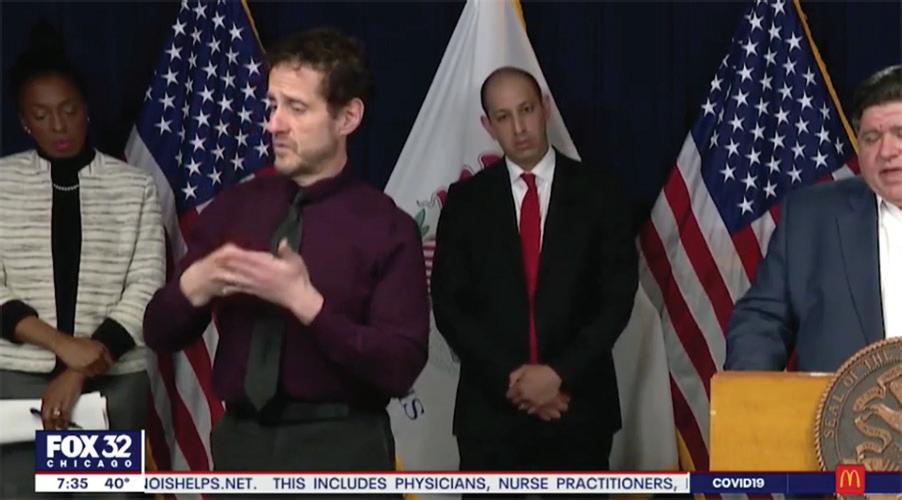
I know Albert socially—we have a mutual friend who hosts a fabulous Labor Day barbecue and a New Year’s Day open house every year. (Turns out, we also both did some acting with Andy Dick in our college days; me at Columbia College Chicago, Albert at the University of Illinois Urbana-Champaign, where he fi rst studied ASL.)
As he pointed out to Stevens, interpreters don’t often take the spotlight; an exception is




Lydia Callis, who interpreted for then-Mayor Michael Bloomberg when New York City was under siege from Hurricane Sandy in 2012, and subsequently became the subject of a Saturday Night Live sketch starring Cecily Strong as Callis. Marlee Matlin, the deaf actor who won an Oscar for her performance in 1986’s Children of a Lesser God , took exception to the sketch on Twitter. “Millions of deaf people use sign. Why poke fun/fake it? Poke fun at ME but not the language. Would they do that to Spanish or Chinese? FAIL,” she wrote.
And there are also, as Albert tells me, “interpreters who aren’t really interpreters who achieve notoriety because they’re doing so poorly.” Example: Thamsanqa Jantjie, the interpreter who signed while standing next to President Obama and other dignitaries at the 2013 funeral of former South African president Nelson Mandela. His work was dismissed by (among many others) Wilma Newhoudt-Druchen, the fi rst deaf woman to be elected to the South African parliament, as “rubbish.”
As he has been careful to point out in all the interviews he’s done, Albert reminds me that he is himself not deaf, and the attention paid
12 CHICAGO READER - APRIL 9, 2020 ll NEWS & POLITICS
NEWS
ANDERSONVILLE UPDATES SUPPORTING OUR BUSINESS COMMUNITY IN THE WEEKS TO COME andersonville.org/updates VINCENT RESTAURANT | ANDERSONVILLE, CHICAGO COMIDA! Packaged meals available for FREE for pick-up Suggested donation to benefit industry workers 1475 W. BALMORAL AVE. Visit vincentchicago.com or find Vincent Restaurant on Facebook for schedules, menus, and other details
to him “gets problematic. And the reason it gets problematic is because this language is not our language, the interpreter’s language. It is the language of the Deaf community.” (Albert notes that “people who are members of what we consider Deaf culture prefer it be spelled with a capital ‘D.’”)
Albert has worked as an ASL interpreter with the Chicago Hearing Society for over 20 years. CHS was founded in 1916, and according to its website, its original mission was “promotion of social intercourse among its members” along with providing “assistance for the deaf and hard of hearing in the matter of procuring and retaining employment,” and “promotion of an interest in lip-reading.”
Michelle Mendiola, manager of community outreach and advocacy for CHS, notes that the current mission for the organization is spread among three groups: the audiology services department; interpreter services, where Albert works; and her department, which encompasses everything from assistance with taxes to helping deaf and hard of hearing people who have been victims of domestic violence and identity theft. They also o er youth programs and assistance for parents of children with hearing loss.
The COVID-19 shutdown has a ected how CHS provides those services, but they are still assisting clients; for example, clients who use hearing aids can still drop them o for repair through the audiology department, and audiologists are still available through appointment. Mendiola adds, “Our COA sta transitioned to virtual communication [with clients] through e-mail, videophone, texting, FaceTime, Google Duo, as much as possible. If it requires, for example, [going to] court, we will meet the client in person.”
Providing interpreters for medical appointments is also one of the services CHS offers. Mendiola says, “We have one client who was impacted by COVID-19. They had not tested for whether they had it or not, because they were not high risk. But the client is very concerned, and we gave them all the information in American Sign Language and explained what they need to do to stay quarantined.”
Although Albert has not yet interpreted for any families facing decisions around COVID-19, he says that he has been present for “things like funerals and end-of-life dis-

cussions.” Those can take an emotional toll. “My father had died about a year before,” says Albert, recalling one such discussion. “I remember leaving that room and calling my brother and crying.”




As for the attention that interpreters get for their own perceived emotionality while working, Albert says, “It’s always our goal as an interpreter to match our speaker in a ect in addition to active interpretation of content.” For Lightfoot, Albert describes her style as “very matter of fact. What you see is what you get with her. So yeah, I think we try to embody something of the speaker in our interpretation to the extent that we can.
The information at these press conferences involves factual kinds of stuff for the most part, although Governor Pritzker has become emotional in his anger at the president and in his anger at the federal government’s lack of response.”


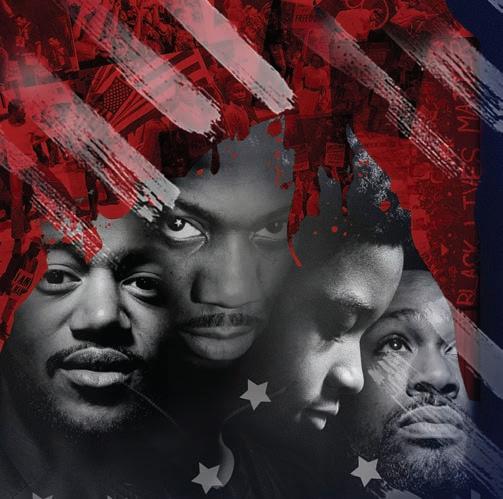
Albert also says, “I think the media, the visual media, has become much more aware than I’ve ever seen before through this crisis. The interpreters need to be in the frame the entire time. Usually what happens is the TV [camera] will pan out and show the interpreter, but then they’ll focus again on the speaker, they’ll come out again for a minute, and then go back in. And in this crisis, they’ve been staying on the interpreter the entire time.”
That commitment to full and e ective communication with the deaf and hard of hearing should always be present, but the current pandemic raises the stakes. Mendiola notes that it’s important for service providers to know what their clients who are deaf or hard of hearing require ahead of time, whether it’s an ASL interpreter or extra time to make sure that the client has received all the information they need.
“We do, for example, get a lot of complaints that [health-care facilities] don’t provide interpreters for COVID-19, and it’s kind of sticky,” says Mendiola. “We do have some interpreters who are willing to be on standby if needed. But it’s important that the hearing people—the doctors, the health-care providers, social providers—meet the deaf communication needs.” v
To request an interpreter or to inquire about other services available through CHS, call 773248-9121 or 773-904-0154 (videophone), or visit chicagohearingsociety.org.


APRIL 9, 2020 - CHICAGO READER 13
@kerryreid
Michael Albert at a press conference for Governor Pritzker. FOX 32
NEWS & POLITICS WATCH FROM HOME! REMOTE VIEWING PERFORMANCES NOW AVAILABLE LIMITED AVAILABILITY NOW – APRIL 19 773.281.8463 TIMELINETHEATRE.COM – Chicago Reader “STANDS AT THE UNICORN-RARE INTERSECTION OF MESMERIZING AND INDISPENSABLE ”
by JAMES IJAMES directed by WARDELL JULIUS CLARK
CHICAGO PREMIERE
ARTS
CULTURE
Sheltering in a collapsed place
By BILL SAVAGE
As Chicagoans grapple with the new reality of the COVID-19 pandemic and the radical restrictions which public health requirements have put on the places in which we live, work, and play, it makes sense to step back and ponder some aspects of what makes the situation such an emotional and psychological challenge.
Just in case you hadn’t noticed, we’re all more than a bit freaked out. Except for the
Fox-News-viewing “It’s just the flu!” true believers, we fear that the virus will sicken, or kill, us, our loved ones, our families, and friends. Government orders that everyone except essential workers stay home and shelter in place has transformed the interlocking mosaic of private, semipublic, and public places that define Chicago, from our homes to our restaurants to our lakefront parks.
Our sense of place, and where we fit into it

and how it works, has shattered.
This fragmentation might be especially true in regards to food and drink: hot dog stands, taquerias, cafes, diners, restaurants, and bars are all either closed or limited to to-go and delivery orders. The food might be the same, and the drink to go too; but it feels di erent (and it is di erent) to pay with proper social distance and eat your meal at home. Haunted by the social conviviality of just a few weeks
ago, places seem out of joint.
My mantra for analyzing place comes from Yi-Fu Tuan, a geographer/philosopher, who wrote: “What begins as undifferentiated space becomes place as we get to know it better and endow it with values.” Or, to reduce it to a shorthand equation, space plus values equals place. S + V = P.
Thanks to COVID-19, the values that define our places (perhaps especially places
14 CHICAGO READER - APRIL 9, 2020 ll
&
COMMUNITY
Or, why basement wet bars just won’t do.
like restaurants and bars), and distinctions between different sorts of places have been obliterated. Our accustomed habits of moving every day through places that have di erent sets of values (emotional, financial, and psychological) are done for the foreseeable future.
The other key thinker to bring in here is sociologist Ray Oldenburg. To oversimplify the argument of his classic The Great Good Place, we divide the urban world into three kinds of place, each of which (back to Tuan) emphasizes a di erent set of values.
Home is the First Place. It’s private, and where our relationships with other people are defined by family ties: even for the many people who live alone, our sense of a home is emotionally defined by parents and children, or larger extended families, or lovers. Home is the place we start our days, and where we (usually) end them. It’s where we keep all our stu . We shape our First Places to reflect who we are.
In the world of late capitalism, of course, we spend more time in our Second Place: work. In those mostly semipublic spaces, relationships between people exist primarily in economic terms. No matter how much you might love your job, it’s still someplace you have to go, to make the money our system demands of you (to pay for your First Place and all the stu in it). We shape our homes; our jobs shape us.
Right now, our stay-at-home/work-fromhome (unless you’re essential) reality obliterates this distinction between First and Second Places. The values of home (solitude, intimacy, relaxation, rest, connecting with loved ones) now must accommodate the contradictory values of work (groups, hierarchies, professional distance, tasks to be completed).
But even worse, our current crisis prevents us from accessing the vital Third Places that in so many ways make life in a big city worth living.
Third Places are where you go and form communities based not on familial or economic relationships, but on some common interest, usually with people you don’t work with and aren’t related to. Cafes, diners, restaurants, and bars are all places where we embrace a psychological and physical framework, a set of values, distinct from those at work or home. They are semipublic spaces,
ARTS
with low standards for entry (you usually do gotta spend some money, but not necessarily a lot). There are established communities (regulars) who are open to new people joining their group. Third Places provide literal and metaphysical sustenance, food for the body and nourishment for the socializing soul.
In COVID-19 Chicago, we are locked out of the Third Place.
This situation creates cognitive dissonance, as demonstrated by lots of the things people are doing to cope and sharing on social media. Setting up a cute little desk in your house or apartment that’s designated your Work Space just draws an imaginary line distinguishing a Second Place within the First Place.
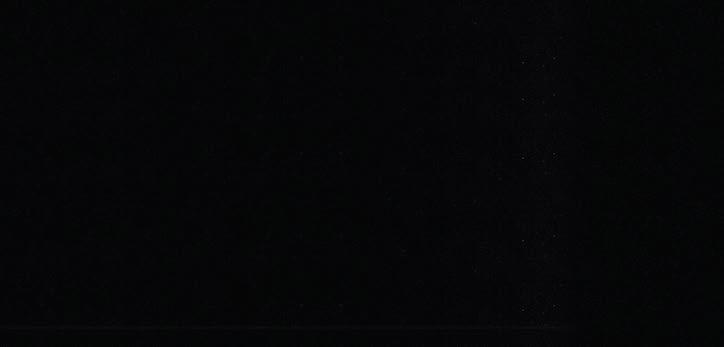
That distinction might function adequately, but it’s much tougher to recreate Third Places: we can Zoom a happy hour drink with friends, but it’s planned and fundamentally different. Any Zoom meeting is a singular conversation: one person talking, the rest listening or waiting to talk. Put six people at the end of a bar, and you might have three di erent one-on-one conversations running at once, or one four-person conversation, one guy doing the crossword, and a third just staring meditatively into the middle distance. Virtual bars necessarily lack many of the joys of actual Third Places: running into an old pal unexpectedly, or having some random person turn out to be pretty insightful about sports, theater, or politics. Virtual connections along established lines don’t allow for new connections to spontaneously grow.
In effect, our access to Third Places has been reduced to that saddest of First Place renovations, the basement wet bar. It might physically resemble a real tavern, with a polished bartop, a genuine brass footrail, solid barstools, coasters boosted from local bars, shiny restaurant-supply-house accoutrements and glassware, framed sports memorabilia, and even a neon or two.
But it’s still in your home and so private rather than public, part of your First Place rather than a Third Place. And during the COVID-19 Stay-Home-Save-Lives world, it’s your Second Place too.
Right now, Chicago feels like a shoddily constructed three-story concrete-and-brick building that has pancaked in an earthquake. We’re all confined to the basement, trying to function under the rubble as though we still had access to all three floors. v
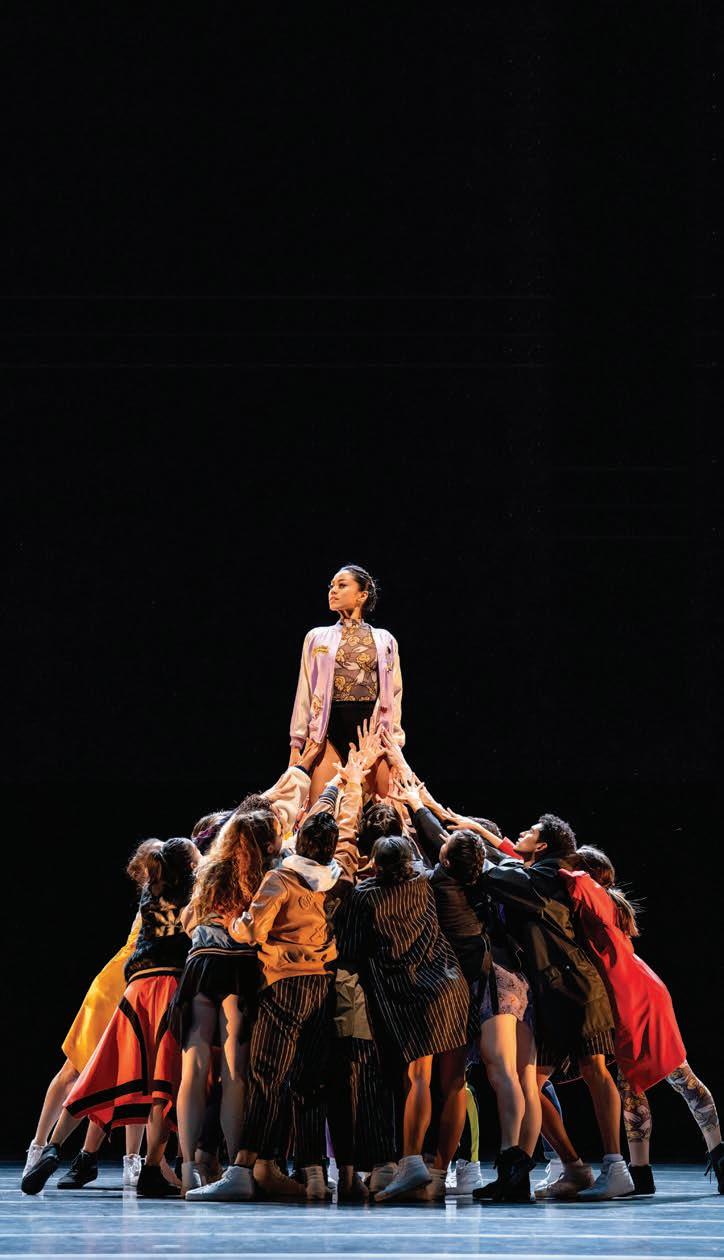
APRIL 9, 2020 - CHICAGO READER 15
& CULTURE
@RogersParkMan CORNELIA LI WE ARE ONE. ONE COMMUNITY, ONE CITY. For now, we embrace shelter-in-place. But we’ll dance together again soon. In our studios and far beyond. When the time is right. AND THE CITY HAS WON. Be well, The Joffrey Ballet Community
Joffrey Artist Jeraldine Mendoza
and
ensemble. Photo by Cheryl Mann.
ARTS
Social Distance Gallery highlights student artists
How canceled BFA
By S. NICOLE LANE
shows are persisting during the COVID crisis.
It’s been more than a week since the shelterin-place order. But even before the order was given, art galleries and museums had been connecting virtually with viewers for upwards of two weeks. Most went on hiatus and began canceling events in order to protect those tempted to gather in large crowds (and as we have learned, Chicagoans are very tempted). This unfortunately includes a large number of students who were planning to present their thesis work in exhibitions. Graduating during a pandemic probably wasn’t in their adult-life plan, and their employment, living situations, and well-being are at risk as they propel themselves into the new reality
that is COVID living.
Museums like the Art Institute of Chicago are offering interactive features for objects like this West African headdress for dance and this carousel horse. People are getting creative figuring out how to stay connected and, ultimately, how to entertain and serve the isolated country. Gallery Victor Armendariz has introduced a virtual program to bring artists to your inbox.
Benjamin Cook, a painter based in Covington, Kentucky, started @SocialDistanceGallery around three weeks ago as a response to the BFA and MFA thesis exhibitions being canceled around the globe. Cook is an adjunct
professor at the Art Academy of Cincinnati where all shows have been subsequently canceled. Other schools have either completely canceled or rescheduled, or have limited their access. Artists are depleted, having spent a year—or years—working toward a show that won’t come to fruition.
How does an online-only gallery like Cook’s work? With more than 16,000 followers, professors submit the work for their students via a website in the bio of the gallery’s Instagram account. Students can also decide to submit on behalf of their class. “Because I [have] such a high level of response, I am asking that schools submit their entire shows as a group rather
than each student reaching out independently,” Cook says.
Social Distance Gallery is a one-person project. “There has been a steady stream of submissions,” says Cook, “but I have it under control now.” It’s difficult for some artists to even know if their show will go on or not. “Some students’ shows are not scheduled for a few weeks. I expect things to pick up soon. There have been a number of people reach out and offer help if things get overwhelming.” And given Chicago’s shelter-in-place order, Cook may have his hands full soon.
Mary Gring, originally from South Bend, Indiana, is currently pursuing an interdisciplinary art and media MFA from Columbia College Chicago where her oeuvre in performance, video, projection, and sculpture focuses on health, illness, and self-care. She and her cohort of six other artists at Columbia make a wide range of work: paper, books, digital illustrations, design, performance, and rituals. They all entered graduate school together in September 2017. For now, the group is slated to still graduate in May. Their thesis exhibition was scheduled to be on display at Columbia College’s Glass Curtain Gallery in the last week of April. “Everything is uncertain right now, and I think my cohort is in disbelief; this is certainly not how we pictured our last semester of graduate school, an already stressful and draining few years,” Gring says. The cohort feels even more anxious about postgraduate plans as the pandemic has contributed to closures, layo s, and artists feeling lost. But Gring says that she understands the circumstances. “Though these delays and cancellations are inconvenient and disappointing, the only thing we can and should do is prioritize the health and safety of ourselves and our neighbors. If that means our thesis show and graduation are postponed or canceled, so be it.”
After a near-fatal car accident in 2016 left Gring in a wheelchair for four months—and has subsequently played a major role in her life contributing to chronic pain and fatigue— her creative practice reflects her experience with mental illness and her disability. Gring’s thesis project, “Disintegration/The Cure,” is a multimedia installation that looks at self-care through creative methods. She filmed herself taking a shower through an endoscope camera, which she encased within a bar of soap, in order to explore her compulsive behaviors. She
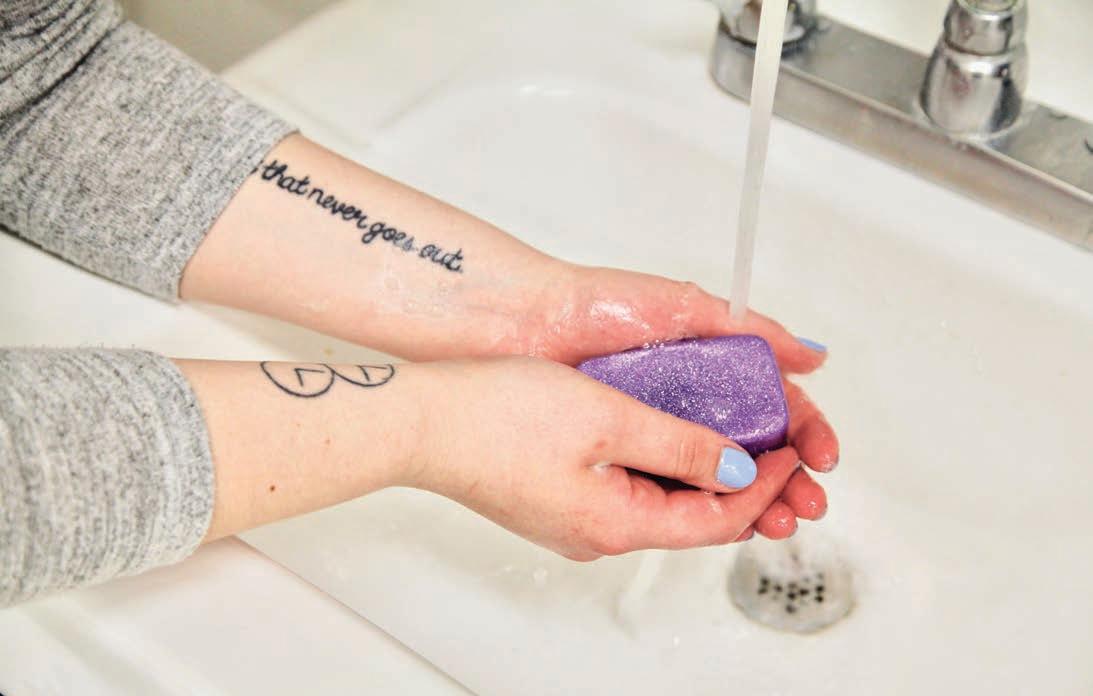
16 CHICAGO READER - APRIL 9, 2020 ll ARTS & CULTURE
VIS
and MFA
“Disintegration/The Cure” COURTESY
MARY GRING
utilized dye, mica, and glitter to create 2,000 bars of soap, which are displayed with the film and a scented sculptural installation. Gring says the piece “invites viewers to confront the intimate, honest realities of illness, coping, and physicality in a way that could seemingly swallow them whole. Who knew making 2,000 bars of soap would be so relevant?”
Gring’s professors and administrators at Columbia have been reaching out to students, reassuring them, and encouraging them in positive ways—an imperative part of society right now. Courses are still being discussed to be moved online but much of the planning has been di cult, especially in a school for art students, who take studio-based courses. Gring’s professors are learning how to cope, too. They are reaching out to artists all over the country through Facebook (specifically a group called Online Art & Design Studio Instruction in the Age of “Social Distancing”) and are learning how to work remotely.
Yvonne Martinez, a fiber and material studies student, was slated to graduate from SAIC with her MFA this spring. Martinez owns most of her equipment and has been able to work remotely in a makeshift studio in her room in Logan Square. Martinez has been taking her work to Twitch, where she is livestreaming herself with her physical fiber materials. For Martinez’s original idea for the MFA thesis show, she was going to present large knitted pieces with an accompanying performance during the opening. “I use a hacked knitting machine to generate large pieces of fabric with screenshots and images from my computer desktop on them,” she says. In self-isolation, she says, “I’m developing a web application where the audience of the performance would be able to submit text/imagery in real time to me and watch as I print the images out using my knitting machine. I would be streaming the whole thing on Twitch at the same time, so my online audience could participate as well.” Martinez’s interests lie in blending the digital experience with the physical world, which makes her practice in isolation continue with ease. “While most of this can and does exist online, the audience participation and translation into the physical world is important, and I don’t want that to be missing from my thesis show.”
For Martinez, it’s difficult to keep up with the onslaught of news from the school’s administration and students. Every day that passes may mark a new decision for the school. “I hope the conversation remains open and [as] compassionate as it has been. There’s


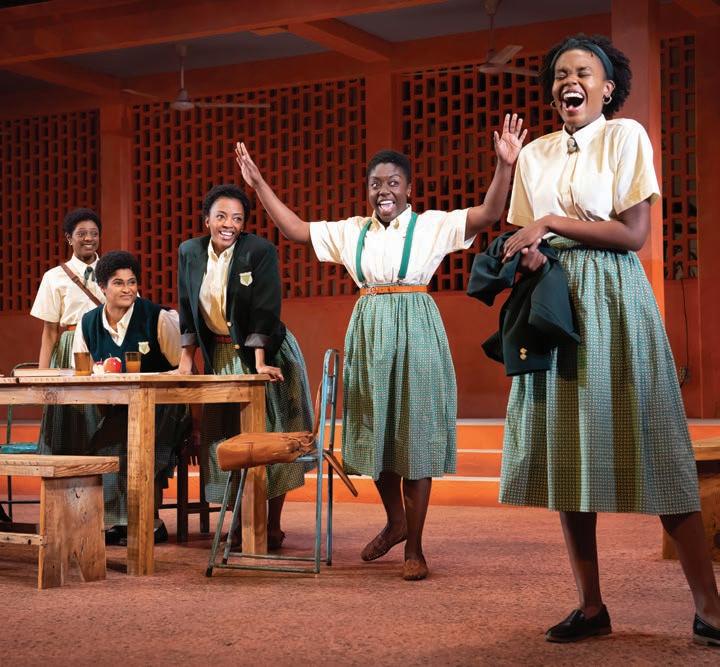
ARTS & CULTURE
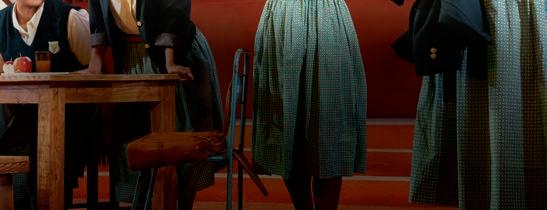


a feeling of solidarity which I am enjoying. I set up a Slack channel for the grad students to hang out and talk (about non-school related stu ) [sic] which has been nice too.”
Martinez’s program isn’t solely focused on the precariousness of their thesis show, however. Instead, the issue lies in critique week, where in-person studio visits with faculty are conducted to evaluate the students’ progress. “Most communication is done through e-mails, although I’ve spoken on the phone/ video chatted with some advisors/mentors and the professor that I am a TA for.”
Universities and colleges have been drastically disrupted, with thousands of students forced to evacuate campuses, and are at a loss for how to continue classes. Graduation, future plans, and housing have all become serious concerns alongside safety, health, and well-being.
Gring says her mental illness and physical disability already make life di cult and that the pandemic has affected her anxiety and pain. Nevertheless, she’s hopeful as she continues to make work at home during self-isolation. “If school has taught me anything, it’s that making art will never be more important than my own well-being. And that’s okay.”
“Everyone is going through a similar thing,” Cook says. “Self-isolation has been strange. The lack of information and clear messaging has made things a bit scary. We are in the early stages of this and the long-term e ects are yet to be seen. I am just taking things one day at a time. I am trying to stay informed, working on this project, and rewriting my syllabi to reflect a new, remote teaching schedule.” On the positive side, Cook’s family is healthy and he’s been able to spend more time with his partner and two dogs.
“If you feel like you can’t make work, it’s okay to rest,” advises Martinez. “Take a bath, do some yoga, go for a walk, call a friend/family member, eat some ice cream. We should take time to do things that make us feel good and not feel guilty about it.”
Right now many MFA and BFA students have their hands tied. They aren’t sure whether they will graduate or if their thesis shows will go on as planned. Like the rest of the world, it’s a game of wait and see. All plans will be uncertain for the foreseeable future, which means accounts like Social Distance Gallery will become more prevalent as artists continue to create in the comfort of their homes and look for virtual outlets. v
APRIL 9, 2020 - CHICAGO READER 17
@snicolelane
NOW ONLINE! SCHOOL GIRLS; OR, THE AFRICAN MEAN GIRLS PLAY By Jocelyn Bioh, Directed by Lili-Anne Brown Major Corporate Sponsor Corporate Sponsor Partners GoodmanTheatre.org/StreamSchoolGirls Through April 26 only Stream this “nasty-teen comedy, wonderfully refreshed and deepened” (The New York Times) from the comfort of your home! Chicago's Free Weekly Since 1971 We Couldn't Be Free Without You— Support Community Journalism chicagoreader.com/donate u THE
Breaking the stereotypical Latino storyline



















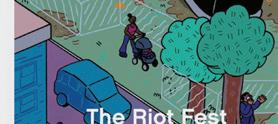

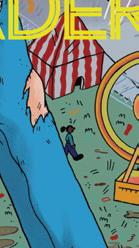
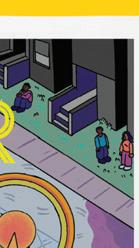
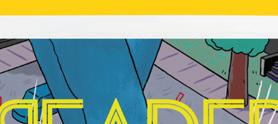










A new bilingual podcast puts a microphone to the local Latinx community.
ARIEL PARRELLA-AURELI



Everyone has a podcast. Even your dog has a podcast. But when it comes to diversity, it’s no surprise that white people dominate the platform. According to 2018 data from Edison Research, 59 percent of U.S. podcast listeners were white—only 12 percent were Black and 11 percent were Latinx. While podcasting continues to rapidly grow, its diversity and accessibility are slowly catching up.







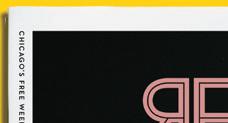
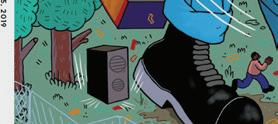
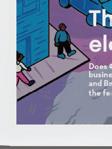

Aspiring Latinx , a new Chicago bilingual podcast officially debuting May 1 (its intro episode dropped last week), aims to combat those low numbers and give the local Latinx community a seat at the podcast table. Meant to “break the stereotypical storyline,” Aspiring Latinx tells the stories of everyday Latinx Chicagoans from different perspectives, industries, and identities to build community, empower one another, and accurately represent the community in the media.









“The goal is to have a platform that brings together the Latinx community because I feel like there’s such a disconnect with Latinx in terms of generations,” says Emily Santos, cofounder and cohost of the podcast.

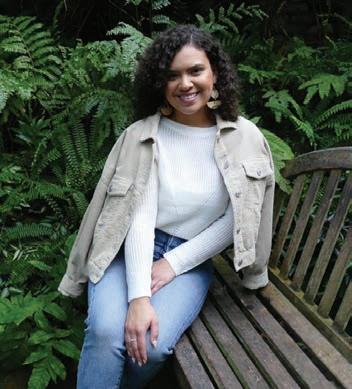
Santos wants to make sure the podcast is inclusive for people who do not identify simply as Latino or Latina, an identity which she says is confusing within the community itself due to a lack of understanding. “Latinx” is seen



as more of an umbrella term but is also one of debate among Latinos; the show tackles this di cult conversation to educate Latinos and non-Latinos alike. She wants to highlight the ethnic diversity and represent how language plays a role in identity—or how it doesn’t.



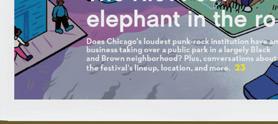
“[Being Latinx] doesn’t mean that you need to be fluent. It doesn’t mean that you need to be born in your country,” she says. “There’s so many di erent meanings and takes to what being a Latino is. And so that’s where we wanted to go and just have real conversations about what it actually is to be a person in this time.”

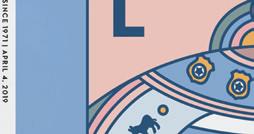




The six episodes bounce between English, Spanish, and Spanglish, depending on the language that is most comfortable for their interviewees and the topics. Guests like community and political organizers, health workers, and artists discuss race, ethnicity, colorism, identity in the workplace, and the importance of being a role model to younger generations.




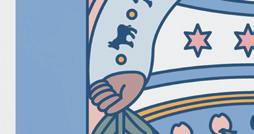
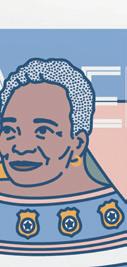


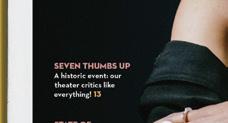
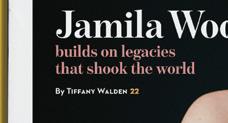
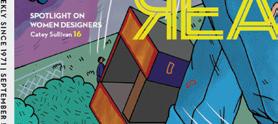
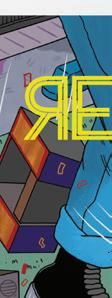



Aspiring Latinx was born after a disappointing internship experience that squashed creative expectations for Santos and her cofounder and cohost Jocelyn Moreno—one where they were treated poorly because of their ethnicity. “We were more of a second thought, and there more for administration and cleaning duties versus me being the social media person and Jocelyn being a graphic designer,” says Santos, who now works in mar-
keting and social media after graduating from Columbia College in 2018.










Moreno, who also graduated from Columbia with a degree in graphic design in 2018, says the experience was frustrating, but it pushed the two millennials to brainstorm ways to get their project o the ground on their own terms. It has allowed her to continue designing when she’s not working as a community health worker at Mujeres Latinas en Acción, a nonprofit serving Latinas.
Originally a magazine called Aspiring Latinas , Moreno says, the project was transformed into a podcast—with the name change—because it seemed like a more inclusive, fun, and dynamic platform to engage its subjects and audience. Editorial content still lives online, the founders say, where they post pictures, quotes, and transcriptions of their podcast episodes for those who cannot speak both languages.
“If we were to have the name how it was, we would be taking away that part of every person to tell their own identity and you never want to strip that away from anyone,” Moreno says. “Let someone say who they are before you even say it for them because as Latinos, we are constantly told who we are.”


Santos and Moreno are both first-generation college graduates, a big deal for them and their families. But without aspiring role models in their community, both founders say it wasn’t until college that they found their confidence and passions. For Santos, that is the underlying inspiration for Aspiring Latinx. “I really do believe if you don’t see any of that representation, it’s really hard to envision what you can be,” she says.
Reflecting on the yearlong hard work, the founders say they are in it for the long haul. They plan to expand the podcast through other avenues and assured me there will be a season two. For now, they are happy to revel in season one and hope to bring diversity and change to the Latinx community by reaching people who might not usually listen to podcasts.
“It’s not gonna happen one day to another, but I think just bringing in as many people who are usually not part of projects like this will get people to start listening,” Moreno says. “We want to create a platform where we have this connection with people and we invite people to always connect with us. If there’s anything they want to hear, or if they want us to put certain people on, we really want this project to be as close to home as possible.” v

18 CHICAGO READER - APRIL 9, 2020 ll ARTS & CULTURE PODCAST
Emily Santos and Jocelyn Moreno COURTESY THE ARTISTS
@ArielParrella Providing arts coverage in Chicago since 1971. www.chicagoreader.com
Dancing alone together
Chicago dancers figure out how to create in isolation.
By IRENE HSIAO
Dances are made in time and space, a minute or an hour in a dancer’s life never to be seen again. Dances do not last—they have to be made new each time and evaporate as they are appearing. Today, small freedoms—moving, gathering, and connecting— have been restricted to limit the movement of a virus that, whether we want to admit it or not, is showing us just how connected we are.
The same situation is playing out with dancers worldwide: projects, galas, gigs, shows, and even seasons abruptly wiped from the calendars. It is not surprising that an art form defined by movement has sprung to action. Dancers are dancing in their kitchens
and living rooms. Dancers are dancing with cats and children running through the room. Dancers are teaching classes to hundreds, even thousands of distant viewers, over online platforms. Dancers are migrants, and the dance community is small. Now it is smaller and bigger than ever.
Dance was once an art that had to be done face-to-face, in your face, feet on the ground where will and gravity placed them. Now, in a virtual world where time, space, and place don’t matter, what remains is energy, and that energy can travel faster than ever before. Dancers dance.
DANCING ONLINE
Terence Marling
Among those teaching online today is Chicago native Terence Marling, who trained at Ruth Page Center for the Arts and performed at Pittsburgh Ballet Theatre and Nationaltheater Mannheim in Germany before returning to dance with Hubbard Street Dance Chicago, where he has also worked as rehearsal director and director for Hubbard Street 2. Last fall, Marling launched Common Conservatory at the Menomonee Club for Boys and Girls, which he describes as “a dojo for dance, for young dancers seeking their way in the professional world.”
“I have been in a dance studio every day for 34 years,” says Marling, “actually longer—I used to watch my mom [dancer Clare Carmichael, who founded Chicago Ballet Arts] in class from the age of two.” Today Marling continues the tradition from his living room, where he streams a ballet warm-up over Instagram Live (@common.conservatory) six days a week at 11 AM. “I thought, ‘You know what, I’ve got to do a barre every day, and everyone’s got to do a barre!’ So I decided to put it out there, because what’s stopping us from doing at least that much?”
Uncertain of what teaching to a screen would feel like or who would participate, Marling launched his experiment on March 16. To his surprise, over 60 dancers tuned in the first day. “I thought, OK, if there are going to be 60 people here, and they’re doing some tendus, this actually feels important.” The numbers shot up as the week progressed, far more than would fit into a studio—60 to 90 to 150 to 200—dancers not only from Chicago but from around the world seeking regular practice.
“As dancers, we need movement,” Marling says. “It’s not something we do because we want to—we have to. Especially at this time, when anxiety is so high, it’s important to move your body every day. One of the only ways we can emotionally support each other is by developing these places to meet and holding ourselves accountable by being there, by trying every day. I’m astounded by the number of people who have made it their daily ritual.”
“We have to get through this, until we get to the time we can gather again, and I can open Common back up. I really can’t wait for that day.”
THEATER
Pe Modelski
A veteran dancer since her first contract job in the Royal Ballet’s Sleeping Beauty at the age of six, Pe Modelski moved seamlessly from Fiddler on the Roof on Broadway to teaching six or seven days a week at STEPS on Broadway. “I’ve been teaching for over 45 years,” she says of a career that has allowed her to impart a technique designed to prevent injury and build somatic awareness to generations of professional dancers, choreographers, and directors. Now 74, Modelski, who has taught in Chicago for the past 12 years, is another pioneer in online dance instruction.
“People who had trained with me said, ‘I want to hear your voice. I need your class.’ When somebody asks me for help, I never say no,” she says. But the technology posed a challenge to Modelski, who relies on eye contact and touch to connect with her students.
“I did an awful lot of learning in three days. I watched about twelve hours of instructional videos. Finally, two dancers I’ve known for 40-something years got online and walked me through until I was able. I used to do that with them, so it was wonderful to make a 40-year Möbius loop like that.”
Of her experience teaching over Facebook Live, she says, “I was talking to an empty room for an hour—I’m either an actress or a madwoman! But being able to connect with so many people and receive their feedback was wonderful.”
“This version of the world is temporary,” she continues. “It requires an enormous amount of inconvenient maturity from many people, including me. When we are again in a position when we can gather together, the same thing will happen that happened two days after 9/11: the studio is going to be packed. But for now, take a deep breath, have a good lunch, learn a new platform.”
Nick Pupillo
“People need to dance,” says Nick Pupillo, founder and director of Visceral Dance Center and Visceral Dance Chicago. “This is not just something we do. It’s part of our lives. It’s more than just a practice—it’s our passion.”
Visceral Dance Center is usually open yearround, including most holidays, and o ers 95 youth, adult, and professional classes weekly, as well as workshops and master classes. Pupillo’s normal work week is about 55 hours in seven days, teaching, coaching, choreographing, and managing the company, youth

APRIL 9, 2020 - CHICAGO READER 19
Peff Modelski COURTESY OF THE ARTIST
DANCE
company, and school. The hubbub came to a screeching halt on March 16, when Visceral closed its doors for COVID-19.
“How does the world just stop? I have dancers who need to get paid, faculty who need to get paid. How can we keep going when we don’t have any money coming in?” he wonders. Though initially skeptical about teaching online (“I don’t want to teach to a screen! I need the energy of the class and the people around me”), Pupillo has experimented with livestreaming from the studio over Facebook, Instagram, and Zoom.
“I thought it might make people feel better just seeing the space,” he says. “And seeing people of so many different levels and ages made me feel like I was part of their lives like I usually am when I teach. Visceral is a community. But there were also friends who have probably never seen a dance class before watching. This might be a way to expose the arts to a new community, which I had never thought about before.”
“I’m paying my sta right now, paying my dancers, paying the teachers—but I don’t know how long I can do that. If we keep going for three weeks with no revenue coming in, I don’t know. But what I think a ects me most
is, who has money coming in right now? So many people are out of work—all these dancers—every artist—can’t get paid right now.”
Angela Tam
Although Chicago o cially went under lockdown on March 21, some studios and companies have been feeling the pinch longer—perhaps none more so than Yin He Dance, a Chinatown-based company and studio in Chicago that performs classical and contemporary Chinese dance. “COVID-19 has been a ecting us since January,” says cofounder and director Angela Tam. “We have been operating in deficit since the beginning of the year due to lower attendance rates, especially among our youngest students.”
Noting lower attendance at Lunar New Year performances at venues such as Navy Pier, where the company performs annually, Tam says, “I think the situation was scarier for many in Chinatown because many know people in China and/or follow online media about how the virus progressed in China. Many New Year–themed banquets where we perform were also canceled.” Since the shutdown, the company has been rehearsing once a week over Facebook Messenger.
Tam takes a calm view of the future. “I know
the situation will pass,” she says. “When Yin He first started in 2016, we had two classes of two students each for the first few months, and we regularly performed for fewer than ten people, which was not much better than what we’re going through now. It’s all uphill from here.”
coping creatively
Cristal Sabbagh
“Our current government is not a place I can find truth or comfort. There are so many lies being told and so much corruption. I need to try to lean on my friends and see what we can do as an o ering,” says multidisciplinary artist Cristal Sabbagh, who teaches art at Stevenson High School in Lincolnshire. With friends scattered as far as Japan, Sabbagh has been exploring dance in an online community of improvisers weekly. Organized under the hashtag #promptresponsegroup, the friends use single-word prompts to generate dances—recently including “wonder,” “center,” “resonate,” “ground,” and “water.”
“I try to keep it positive and use simple symbols to spread love,” she says. “My faith is with artists: they are problem solvers and creative thinkers trying to make connections, making the most out of something horrendous.”
Jane Jerardi
Caught midprocess, Jane Jerardi faces uncertainty about future performances. “My mentors at the SAIC would say, ‘You make in the time constraints that you have.’ For now, we’re continuing [virtually] to keep a normalcy, joy, and stability to our week, with the sense that [the lockdown] is another thing that is going to inform the project. A lot of our choice making is limited, so how do we make this new constraint part of what we’re making? It could be impossible, especially if one of us gets sick.” The title of Jerardi’s yearlong project, on the theme of desire, is eerily prescient: Delicate Hold.
In addition to her independent work, Jerardi works as faculty and technical coordinator at the Dance Center of Columbia College, where she produces video documentation of the Presenting Series as well as student and faculty performances.
“The Dance Center has an archive that dates from the 1980s to the present,” says Jerardi. “We’ve had to postpone our shows, but we were thinking audiences in Chicago might

need some respite.” Through May, the Dance Center has therefore made its recordings of complete performances available to the public. “The Dance Center is unusual in its range of programming. My hope is that people will see this work, a lot of which is not available otherwise, and realize these companies also need some support.”
Reflect (a sidebar)
“We are doing rehearsals via Skype, and a friend in Sri Lanka was able to join for the sessions. But overall, I feel very bombarded with all the social media online classes. I felt the pressure to jump and present something online right away—but I didn’t teach a regular class before, so why now? I need some time to absorb and process and look into myself before jumping in.” —Kinnari Vora, cofounder of Ishti Dance
dancing alone
“Dance is not the body that creates the movement. Dance is the movement,” asserts Christopher Knowlton, a choreographer and biomechanics researcher who manages the motion analysis laboratory at Rush University. “With motion capture, you’re abstracting the motion from the body that created it, and that opens up so many possibilities. The body carries so many signifiers and so many social cues of identity, but to be able to pick apart the markers of identity that are in the movement, not the physical form of the person, is so interesting to me. Puppetry gives us insight into that: we can move a piece of trash and have a totally emotional response to that. Dance doesn’t necessitate a body. Using motion capture and digital media avatars and augmented reality is a way to strip away some of that for me. Can we look at the movement and not look at the bodies doing the movement?”
For the past several months, Knowlton has been developing an augmented reality platform that o ers a di erent view on dancing. Viewed through a smart mobile device, like Snapchat filters and Pokémon Go, the program displays a virtual layer over what the camera sees. “The performance is virtual, and your access to the performance is through the device,” Knowlton explains. “Technology can be a prosthetic to allow audience members to become more active viewers.”
The performance he envisions, under the working title Extended Play , takes place on the rotating surface of a vinyl record. Knowl-
20 CHICAGO READER - APRIL 9, 2020 ll THEATER
Nejla Yatkin ENKI ANDREWS
continued from page 19
THEATER
ton is developing code that would allow a smart device to recognize record labels and display a dancing avatar on the record, “like a traditional music box with a ballerina sculpture that spins or a zoetrope. And once you get into digital media, anything goes. You don’t have to obey the laws of physics. You can create a whole scene, it doesn’t have to be one avatar, it can be a whole cast. There’s a lot of creative freedom.” Viewers could personalize their experiences by watching from di erent angles and would have the opportunity to see the same performance repeated di erently— and they could do it all at home: “You don’t have to show up at the theater at a certain time. You don’t have to sit in the audience. I like this idea of sitting with a record and listening to an album. It’s intentional and not performative, not like showing up to a theater with friends and being seen but experiencing it for yourself. I like that sense of isolation and intimacy.”
The process has also been isolated. “Right now, the movement originates in my body,” explains Knowlton. “It’s something I measure and record, and right now, it’s being put into an avatar that’s a mini-me. I don’t know many dancers or media artists who are doing this, so I haven’t had many colleagues. I haven’t been at the point when I can invite another dancer in my process yet—it’s just been me in the studio teaching how to do things myself.”


Dance around the world
For two years, choreographer Nejla Yatkin traveled to 20 cities around the world creating site-specific dances in public spaces with local dancers. Dancing Around the World, an award-winning short film in collaboration
with Enki Andrews, documents this work, and Yatkin has recently been rereleasing segments over social media.
“I did this project to show that we are these separate countries but in essence we are a global human network,” says Yatkin. “When we have met our basic needs, we all like community, we like to exchange with others, we like to collaborate. I didn’t go to showcase each country’s dance but to give improvisation prompts and to see how people move together. In many places it was similar—there are di erences in energy, but most of us have the same two arms, five fingers, two legs. How far can you go with that? By showing that, I was hoping people would come together, and countries would feel more connected to each other.
“With the 2016 election, the country went the other way. Instead of connecting with the global community, we separated ourselves more and more. Now our problems are bigger than our country. Climate change needs to be tackled globally or else we’re not going to survive as a human tribe. This virus is a global issue. We have to collaborate.”
The prompts Yatkin used to connect with her dancers were abstract: “lines, curves, meeting each other, the spaces in between people, how we connect, and how we go apart. Where does your self start and where does the other begin? Geometry is so universal, using those forms in movement also leads to more universality than my telling them how to move or what to do.” The results of Yatkin’s project showed her that “we can work together around the world. Hopefully we’ll get back to that place.” v
@IreneCHsiao
APRIL 9, 2020 - CHICAGO READER 21
OTV thrives online
By BRIANNA WELLEN
Elijah McKinnon sees the future of television as revolutionary, fearless, and divine. As the executive director of the inclusive online platform Open Television (OTV), they’ve had exclusive insight into the groundbreaking work of Chicago filmmakers. And after spending the past six months traveling to places like Berlin and Johannesburg to produce OTV’s first international projects, McKinnon is ready to prove that they’re correct about where the medium can go.
“I came back feeling not only inspired by our resilience but our commitment to building long-lasting platforms for people of all identities to plug into,” McKinnon says. “I’m very excited about our e orts to intentionally manifest a global cohort of creatives, storytellers, and filmmakers that are ready to infiltrate media with content that has the power to change the world.”
The platform is well known for launching webseries like Brown Girls, Just Call Me Rip-
ley, and The T, and for its fifth cycle, OTV is focusing on producing more pilots, short films, and experimental works, including projects from outside Chicago for the first time. In the past OTV has premiered each season and then continued to screen o erings with a series of live events at the Museum of Contemporary Art, featuring pilot screenings, live performances, and a chance to connect with other creatives. This year, all #OTVtonight gatherings will be digital, starting with the premiere on April 7 and continuing with several livestreams in May. While other networks and arts organizations are struggling with the pivot to online, it’s an art OTV has been perfecting for years.
“We’re in a special position of being a nimble, native-digital organization with little overhead so we’ve been able to keep working and serving our community,” says OTV founder Aymar Jean Christian. “Streaming, both on demand and live, has increased 50–70 percent on most platforms in the past two weeks, and the whole team is excited to o er something no one else is o ering: artistic, specific, and groundbreaking original narratives for Black, Brown, queer, femme-identified, and other people for whom new content is relatively scarce.”
Along with its established online presence, OTV is using this time to elevate local artists and healers on Instagram, giving them a place to share self-care tips and what they’re working on in isolation. Creating more opportunities for interactions is key—Christian plans on experimenting with the #OTVtonight livestreams to include games and other mean-
ingful ways of connecting with the audience and creatives.

The initial programming premiering on April 7 includes work from Detroit, Johannesburg, and Berlin, ranging from stories about Black trans women navigating life ( Femme Queen Chronicles ) to the lessons we can learn from an octopus ( Seven of Tentacles ). Throughout the year OTV will also be releasing plenty of locally made series as well, including Karan Sunil’s coming-of-age dramedy, CodeSwitched; Sohib Boundaoui’s drama about the FBI’s surveillance of Bridgeview, Arabica; and Good Enough, McKinnon’s story about a Black queer family, which was commissioned by a group of researchers to incentivize young people to take PrEP to prevent HIV. All the series fall into the unique category of high-quality, thought-provoking, underrepresented storytelling on which OTV was built.
Even though their live events needed to be restructured, both Christian and McKinnon are taking sheltering in place in stride. “To be honest, I am thriving!” McKinnon says. “I’m a Black, queer, nonbinary baddie so any opportunity to cultivate stillness and space to breathe easy is a true gift that I value immensely.” And they have guidance for other artists trying to navigate the unknown waters of isolation. “The media landscape can be an incredibly noisy place, especially during times of crisis, so I believe it is imperative that creatives are mindful of their contribution to that frequency. My advice to creatives shifting their e orts online is to be mindful of accessibility, create opportunities for moments of wonder, operate from a place of clarity, and don’t lose sight of your end goal.” v
@BriannaWellen
22 CHICAGO READER - APRIL 9, 2020 ll FILM
Elijah McKinnon and Aymar Jean Christian JUSTIN BARBIN
SMALL SCREEN
The digital television platform introduces its fi h cycle of programming without missing a beat.
ssss EXCELLENT sss GOOD ss AVERAGE s POOR • WORTHLESS We Couldn't Be Free Without You— Support Community Journalism chicagoreader.com/donate Chicago's Free Weekly Since 1971
NOW STREAMING
R Never Rarely Sometimes Always





Nowhere in the world is safe for a teenage girl. It’s a lesson viewers learn quickly—and one our protagonist already knows—in Eliza Hittman’s all-too-realistic Never Rarely Sometimes Always. Faced with an unexpected pregnancy and an unsupportive family, Pennsylvania teenager Autumn (Sidney Flanigan) and her cousin (Talia Ryder) travel across state lines for an abortion. Whether it’s a boss at the local grocery store, a man on the subway, a seemingly nice passenger, or her own father, the men in Autumn’s life are a nuisance at best and a danger at worst. While the subject matter is powerful on its own, Flanigan and Ryder’s performances take the film to the next level, portraying a relationship where words are rarely needed. One particularly heartbreaking scene reveals the film’s title when Autumn responds to a questionnaire from a Planned Parenthood nurse about her relationship history, a wave of emotions silently cracking through her careful composure with each probing question. Never Rarely Sometimes Always is a slow-moving film, but these young women will stay with the viewer long a er the film ends. —NOËLLE D. LILLEY PG-13, 101 min. Streaming on VOD

R There’s Something in the Water
If you were recently radicalized about the imminent threat of climate change, it’s likely due to the popularization of activist Greta Thunberg. But this surge in exposure and action, while vital, o en leaves out the indigenous and Black and Brown activists
who have been on the front lines of the movement for centuries. There’s Something in the Water acknowledges this history, specifically in the Canadian province of Nova Scotia, where these marginalized communities have faced the brunt of environmental racism, unsafe drinking water, and a government that continues to fail them. By highlighting the perseverance of those in the tireless fight for basic human rights and putting a face to the ramifications of corporate greed, filmmakers Ellen Page and Ian Daniel establish themselves as some of the most important and empathetic documentarians working right now. There’s Something in the Water is crucial viewing for anyone who cares about the lasting ripple effects of environmental neglect. —CODY CORRALL 73 min. Netflix
ALSO STREAMING

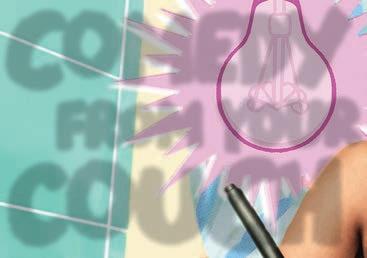
Bacurau
A er the death of the village matriarch, sinister forces plauge the town seemingly trying to pick off the residents one by one. Streaming as part of Music Box Theatre’s Virtual Cinema, musicboxtheatre.com
Saint Frances
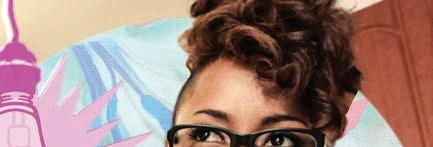

Kelly O’Sullivan writes and stars in this dramedy about a 30-something who forms an unlikely friendship with the six-year-old she nannies. Streaming as part of Music Box Theatre’s Virtual Cinema, musicboxtheatre.com

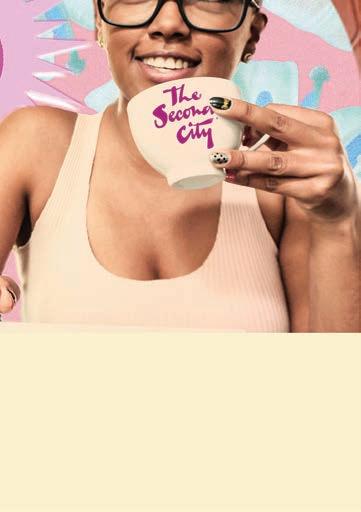
The Wild Goose Lake
This neo-noir mystery from Diao Yinan (Black Coal, Thin Ice) follows a small-time mob leader who is on the run a er killing a cop. In Mandarin with English subtitles. Streaming 4/10-4/16 as part of Film Center From Your Sofa, siskelfilmcenter.com v
APRIL 9, 2020 - CHICAGO READER 23 FILM
COmedy from Your cOUCh Connect, Laugh, Create with People Around the World Through Virtual Classes! IMPROV • STAND-UP • WRITING • & MORE! SECONDCITYONLINE.COM • 312-337-3992 Never Rarely Sometimes Always
BY LEOR GALIL
In 1987, Ben Hollis and John Davies pitched Chicago PBS station WTTW on a program that would capture the city’s obscure corners, unusual characters, and fringe phenomena. To show the station what they had in mind, they’d shot a “guerilla demo” at a spot Hollis already knew: the Dunkin’ Donuts on the corner of Belmont and Clark in Lakeview. He’d often driven past it late at night and seen groups of young people hanging out in the parking lot, and he figured it’d be worth investigating. What were they doing there? Why that

spot, not somewhere else? And what was the appeal?
Around midnight on a Saturday in August, Davies and Hollis brought their gear to the Dunkin’ Donuts. They’d decided to call their show Wild Chicago, and Hollis dressed like an intrepid wilderness explorer: he wore a pith helmet and a short-sleeved khaki shirt, with binoculars around his neck. While Davies ran the camera, Hollis pointed a dinky microphone at just about any bystander who would talk.
“I’m Ben Hollis with Wild Chicago , a make-

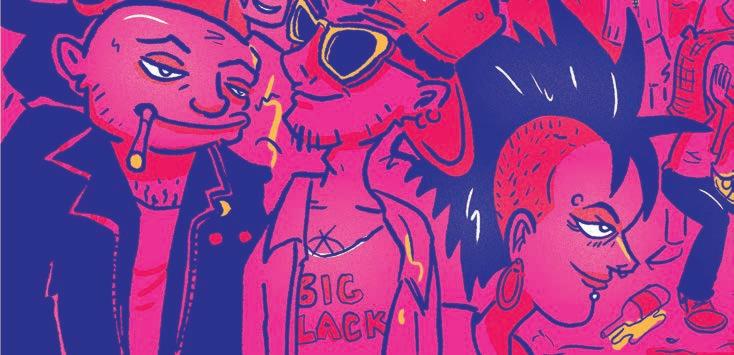
believe TV show,” he explained to a middleaged Black cop inside the doughnut shop. “Just trying to figure out if you’ve got any good ideas about what brings these kids together out here. Why do they come here?”
“For a good time,” the cop responded. Hollis and Davies’s footage from that night includes a couple teenagers freestyle skateboarding, crowds of enthusiastic kids dressed all in black and smiling for the camera, and a Dunkin’ employee who said some of the teens were “straight-up sugar fiends.” The two of
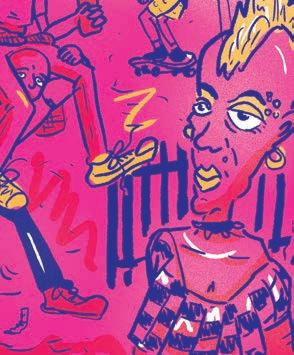

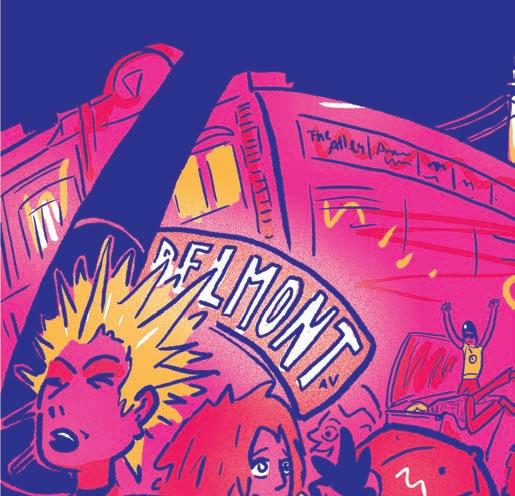
them brought the tape to WTTW senior vice president Pat Denny, who was in charge of production for the station’s regular programs. “He said, ‘Yeah, there’s magic here,’” Hollis says. “‘Let’s make a real pilot.’”
Wild Chicago debuted in January 1989, its weekly episodes each half an hour long. Once it was no longer make-believe, Hollis wanted to do a proper shoot at the Dunkin’ Donuts that had gotten the show off the ground. “Something that alive, organic, and chaotic is rare—it did stand out,” he says. In August 1990, when he
24 CHICAGO READER - APRIL 9, 2020 ll
How a doughnut-shop parking lot became a confluence of Chicago youth subcultures— and what killed it off
arrived with a station cameraman, Hollis immediately saw that the crowd in the parking lot had ballooned in size since his previous visit. “It was on the cusp of dangerous,” he says. “It was an excited crowd, and everybody was jumping around. It was so chaotic. Everybody wanted to stick their face in the camera and say something.”
Both times Hollis visited the Dunkin’ Donuts on camera, he called it “Punk Rock Park.” “I maybe saw a guy with a Mohawk or something and just figured, ‘Oh, it must be punk rock-y,’” he says. But the young people who hung out there had another name for it: Punkin’ Donuts.
Ididn’t move to Chicago till 2009, more than a decade after Punkin’ Donuts had ceased to be a subcultural epicenter, but I’ve been curious about it for as long as I’ve known it existed. In the years after Wild Chicago aired its “Punk Rock Park” episode, the spot’s notoriety seeped into the mainstream. By the early 2000s, Fodor’s and Frommer’s had both mentioned Punkin’ Donuts in several editions of their annual Chicago guides, though by that point few punks still gathered there—the latter suggested, somewhat glibly, that it had earned the name due to “rebellious kids on tour from their homes in the ’burbs.” I’ve sometimes seen Punkin’ Donuts invoked as a sort of synecdoche for the culture of Lakeview in the 1980s and early ’90s, when the neighborhood was seedier and more rambunctious—for instance, that’s how it came up in a Sun-Times review of the new punk musical Verböten.
Even in 2015, when local real estate company BlitzLake Partners advanced plans to build condos and a Target store at Belmont and Clark, DNAinfo repeatedly referred to the endangered doughnut shop as “Punkin’ Donuts.” Despite how long it’d been since kids had flocked to its parking lot, the name had stuck.
I’ve always wanted to know more about the relationship between Punkin’ Donuts and Chicago’s alternative subcultures. In big scene retrospectives, it comes up rarely, and then usually as a curiosity. Punkin’ Donuts didn’t help incubate a scene with a distinctive sound, a recognizable fashion sense, or a cast of characters well-known to outsiders, unlike some of the city’s clubs and record shops. Nobody owned it or organized the gatherings there. The closest thing it had to authority figures were the Dunkin’ Donuts employees, who mostly tolerated the teens loitering outside—even the ones who never came in to buy anything.
Its nickname notwithstanding, Punkin’ Donuts wasn’t just a place for punks. While you could reliably find kids in leather jackets, punk T-shirts, and Mohawks there, the shop also
attracted lots of other folks from outside the mainstream: house-music fanatics, antiracist skinheads, trans women, skaters, drag queens, industrial-music fans, goths, runaways. In the 1980s, the intersection of Clark and Belmont was one of the busiest in Lakeview, an easy walk from a constellation of music venues and clubs as well as from Boystown’s booming Halsted Street scene. The Dunkin’ Donuts operated 24/7 in those days, and because it admitted people under 21 (unlike most bars and clubs), anyone could hang out there, without regard to whether more conventional nightlife attractions were even open.
“Punkin’ Donuts was kind of a landmark more than anything else,” says punk lifer Marc Ruvolo. “You would get to that area and you’d be, like, ‘Oh, we’re gonna walk by Punkin’ Donuts and see who’s there.’”
Ruvolo formed local punk band No Empathy in 1983 and fronted it till it split up in 1997—a span that overlaps significantly with the heyday of Punkin’ Donuts. In 1989, he cofounded the crucial Johann’s Face Records label, which in the ’90s would release music by the Smoking Popes and Alkaline Trio. In the 80s, Ruvolo says, most local punk shows were small—they might draw a hundred fans if they were lucky. Punks didn’t have many places to congregate in large numbers. “Punkin’ Donuts, I would say, became a beacon,” Ruvolo says. “A place where you could go and find like-minded people. And really, in Chicago, it was di cult. It was di cult in the midwest.”
Punkin’ Donuts became a phenomenon because of the places it was near, and though those places have left a more traceable imprint on Chicago’s culture, the scene at Punkin’ Donuts supported them. At its peak in the late 1980s, Punkin’ Donuts developed an almost symbiotic relationship with two Lakeview destinations: juice bar Medusa’s, a hub for punk, house, and industrial music, and punk emporium the Alley.
Chicago promoter Dave “Medusa” Shelton threw his first party in 1979 at storied dance club the Warehouse, and he booked Warehouse regular Frankie Knuckles to DJ. “Frankie and I were best friends,” Shelton says. The following year, Knuckles started spinning at parties Shelton threw at 161 West, a club named after its address on Harrison Street. Shelton is a white man, but in those early days he threw parties for primarily queer Black crowds.
While he was building up his name in the scene in the early 1980s, Shelton happened to walk past a former Independent Order of Vikings lodge at Sheffield and School. “This guy had put a handwritten note on the door, ‘For rent,’ and I walked in there and I rented
it,” he says. “That was it.” Shelton turned three stories of the building into Medusa’s, which opened in October 1983.
Veteran DJ Val Scheinpflug went to Medusa’s its opening weekend and quickly became a member—she says her membership card, which got her in at a discount, is number 20. “I felt so at home,” Scheinpflug says. “I instantly loved everything about it. The decor, the darkness of it, the music, the size of the dance floor, the fact that that’s what it’s about—the moment you walked through the two double doors, there was nothing else to do there but dance. It was just a giant dance floor.”
In 1983, juice bars weren’t required to close when bars did, because they couldn’t sell alcohol. This freed Shelton to create the after-hours club of his dreams. “We would open at midnight and go to 10 AM,” he says. That schedule drew wee-hours crowds from across the metropolitan area, who converged on Medusa’s when other clubs closed. “All the partiers in Cicero, all the partiers in the ’burbs, all the partiers on Rush Street—they wanted to still hang out, so they would come to us after hours,” Shelton explains. Sean Du y, who’d founded production company Last Rites in ’83 and started booking punk bands at Exit the following year, used to travel two miles north to Shelton’s club after Exit packed it in for the night—and in 1987 he started bringing live music to Medusa’s too. Medusa’s didn’t just cater to dancers. Shelton invited local artists to build installations, and a team of video jockeys experimented with visuals on the venue’s third floor. As Chicago scene historian Jacob Arnold wrote in a 2013 retrospective for Resident Advisor, the primary DJs during the early years of Medusa’s, Mark Stephens and Neo regular Bud Sweet, introduced the club’s patrons (and each other) to an eclectic variety of dance styles. Their sets featured house, industrial, new wave, Hi-NRG, funk, electro, and more, which helped draw a diverse crowd open to all sorts of subcultures. “Medusa’s was the first place where everyone could be themselves,” Shelton says. “It wasn’t all about jocks and cheerleaders—freaks ruled the roost there.”
In 1984, Medusa’s began bringing in live music, hosting many of the same industrial acts that were the bread and butter of scene cornerstone Wax Trax! Records—including Belgian EBM pioneers Front 242, making their U.S. debut. Red Hot Chili Peppers played Medusa’s in November of that year, and Ruvolo recalls seeing local art collective Family Plan open the show, performing experimental music behind a chicken-wire fence. “They were up there and they were chopping the heads off of live chickens and letting them run around behind the chicken wire,” he says. “Standing beside me was Anthony Kiedis—he was shirtless, he had
a leather jacket on, and the leather jacket had porcelain teacups in the shoulder straps, which made it all the more surreal. He looks at me and he goes, ‘What the fuck is going on?’”
Admission was usually restricted to people 18 and up, but at the behest of promoter Jonas Lowrance, Shelton launched teen dance nights in 1986; kids under 18 could get the Medusa’s experience, initially on Saturdays from 7 to 10 PM. Punkin’ Donuts regular Fred Ingram was 15 when he first went to Medusa’s in the mid-80s. “The fact that I was able to get into a nightclub was really exciting,” he says. “It didn’t matter who you are, or what you are, or what you wanted to be—it was allowed, accepted, and actually encouraged.”
Scheinpflug had been a Medusa’s regular from the start, and after she began to spin records herself in the mid-80s as DJ PsychoBitch, she played a couple of the club’s teen nights. “Some of my DJ peers would give me a hard time: ‘Oh, you’re working for the kiddies,’” she says. “What they failed to realize is, that’s our future. Those kids, when they turned 21, believe me, they looked for me and came where I was playing. That was my future, and that’s what kept me going—that had a lot to do with why I’m still DJing now.”
The teen dance nights also helped Medusa’s stay afloat after a City Council ordinance in 1987 forced juice bars to follow regular bar hours. Alderman Bernie Hansen, who from 1983 till 2002 oversaw the 44th Ward (where Medusa’s was located), cosponsored the proposal. According to a 1986 Tribune story, Hansen had introduced the proposal because juice bars attracted boisterous crowds that upset residents; among those who addressed the City Council in opposition were Scheinpflug and Wax Trax! cofounder Jim Nash.
In October 1986, Tribune reporters Barbara Mahany and Steve Johnson visited Medusa’s to document its burgeoning teen dance scene. At curfew, which their story says was at 10:30 PM that night, they followed a crowd of teens outside and took a five-minute walk southeast— and at its destination, they wrote, “The exodus turns the asphalt lot beneath an orange-andpink Dunkin’ Donuts sign into a playground of punk.”
Before Punkin’ Donuts, punks gathered about a mile away, in a sliver of a park owned by Aetna Bank at the intersection of Halsted, Fullerton, and Lincoln. The Wax Trax! record store, just northwest at 2449 N. Lincoln, was a big draw, so the few Chicago punks around in the early 80s reliably ended up at the Aetna park. “That was infamous for punks to meet,” says Gustav Roman, a founding member of 1980s hardcore band Lost Cause. “That’s where people met who were di erent—you’d
APRIL 9, 2020 - CHICAGO READER 25
FRANK OKAY
see goth people, older rockers, and all sorts of other walks of life. That was somewhere that you can hang out and not get chased by the cops.”
Sean Du y’s girlfriend at the time worked at Wax Trax!, so he was around to see the punks gathering in the Aetna park—and he noticed when they eventually moved on to Punkin’ Donuts. “They used to drink all the time and left trash, and that was their downfall,” he says. “A block away you had houses that were worth a ton of money—nowadays they’re worth millions of dollars—and those people carried influence with the alderman and the cops. I think when they finally shut that down, I want to say a lot of those people started gravitating towards Belmont and Clark.”
Punkin’ Donuts didn’t just attract folks from the Aetna park and Medusa’s. Many regulars spilled out of other nearby venues: Tuts, a small rock club at 959 W. Belmont, had hosted an upand-coming Bruce Springsteen, and in 1987 it was replaced by the Avalon. Queer cabaret-inspired “video bar” Berlin opened in 1983 across the street from Tuts at 954 W. Belmont. Less than a mile north, you could see punk shows in the early 80s at Cubby Bear and Metro, some of them booked by Du y. Punkin’ Donuts pulled in characters from all those places, creating what Roman calls “a weird mix of family and fun.”
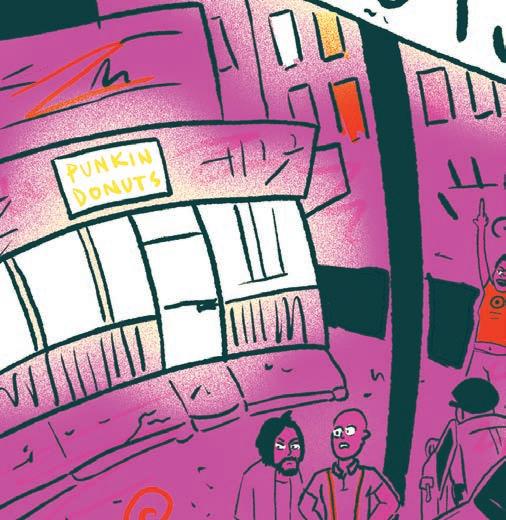
Teenagers dominated the Punkin’ Donuts parking lot because they had so few other places they could go at night besides Medusa’s teen parties and the occasional all-ages show. Plus many of them couldn’t have a orded to go club-hopping even if it’d been an option. “I had an o -again, on-again relationship with money in my teenage years—that was one of the driving forces of the decision-making as to what might happen on any given night,” says Joliet tattoo artist Adam Leavitt, who hung out at Punkin’ Donuts regularly in the late 80s. “There were nights where collectively we’d get enough money together between six or seven people to get a case or two of beer and walk straight up Belmont Avenue to the lake, and sit at the lake and drink until three in the morning.”

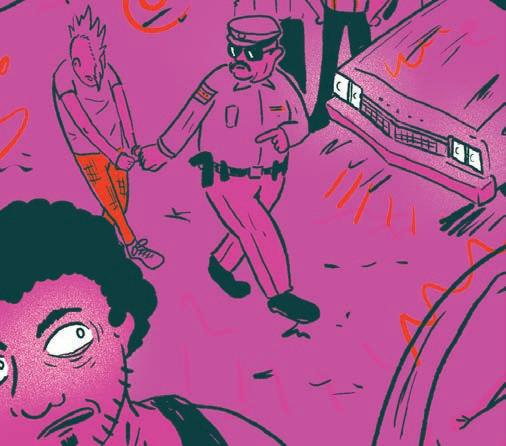

Leavitt says he didn’t have a steady group at Punkin’ Donuts, but he spent a lot of time there with a few friends, including Fred Ingram and Adrian Padron. He’d known Padron (who he’s pretty sure introduced him to Punkin’ Donuts) since they were little, and his old buddy certainly looked the part. “I was really into punk rock at the time—I had a green Mohawk, piercings, wore a lot of leather,” Padron says. “People used to call me Astroturf when my ’hawk was shorter, ’cause it was dyed fluorescent green.”
Punkin’ Donuts was a haven for Riverdale native Scary Larry, who’s fronted psychobilly band the Gravetones since 1997. In the mid-80s, when he discovered Punkin’ Donuts, he had a bright red Mohawk, and he’d already found the south suburbs inhospitable to his efforts to start a punk scene. “I would walk down the street, on my block, and people would grab their kids and bring them in the house,” he says. He remembers townies chasing him in a pickup truck, screaming homophobic slurs. For Larry, Punkin’ Donuts was home.
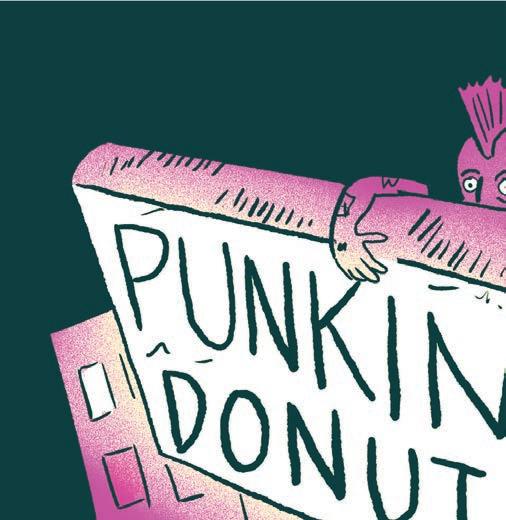
The sheer size of the young crowd at Punkin’ Donuts made it important even to older punks who didn’t share a need for that social space.
“Some nights we’d go by there to flyer on weekends,” Du y says. “I was thinking, ‘Shit, if I can get all these kids to come to my shows’—there must’ve been 100, 150 people—‘I would really do well.’” Some of the teens did show up for Du y’s gigs, and a few even ended up behind the scenes—he’d hire them to work security or load in gear.
Medusa’s video jockey Leroy Fields befriended some young regulars who also frequented Punkin’ Donuts. “I’d go there and they’d be hanging out, and I’d sit there and talk to them,” Fields says. “I got to know them pretty well— they all seemed to be pretty interesting young people. I enjoyed talking to them, listening to them, and seeing what was on their minds and what was going on with the youth of the day.” He got to know Ingram well enough that he’d sometimes ask him to bring back coffee and doughnuts during the break between the club’s teen night and its adult hours.
Fields had good reason to care what punk kids thought. He’d established connections with record label promotions people, who provided him with giveaways for Medusa’s young attendees (music, concert tickets) and new videos to play for them. He’d gauge their tastes with new material, figuring out what they liked so he could better cater to them or challenge them. “We would play a lot of bands that kids liked—PiL, Siouxsie & the Banshees, the Cure, New Order,” he says. “Pixies, which is a band I made them like.”
Teens looking for somewhere to go before or after Medusa’s would spread out across the area between the club and Punkin’ Donuts. The elevated CTA tracks a half block east of Medusa’s, from School south to Belmont, provided some cover for underage drinking, though hanging out there wasn’t as safe as sticking to the parking lot. “It put you in an actionable position because that was trespassing on CTA property, and a train would come through occasionally,” Leavitt says. “That was a spot that frequently—especially right behind Medusa’s, the skinheads would meet and drink. That was a point at which they had four different
26 CHICAGO READER - APRIL 9, 2020 ll
continued from 25
FRANK
OKAY
avenues of escape, if the cops were to come up.”












Police weren’t much of a deterrent, according to Dwayne Thomas, a Black antiracist skinhead who hung out in the Belmont corridor. “Friday night, at Dunkin’ Donuts, that was the landmark,” he says. “People would be skating around, or we’d go get 40s and stand in that parking lot and drink until we got kicked out of there or the cops came and said, ‘You guys gotta go.’” No matter how many times they got cleared out, Dwayne and the Punkin’ crowd always came back. “We didn’t care,” he says.

Scary Larry sometimes stayed out so late around Belmont and Clark that he’d just find an unoccupied building to sleep in, somewhere in the neighborhood. “Around that time, a lot of those houses were being redone, a lot of those three-flats—so sometimes we’d go to one of those places and hang out there,” he says. “I crashed out in a few of them back in the day.”
Punkin’ Donuts attracted homeless teenagers too. In the late 1980s, Padron ran away from home and lived on the street for a year. “I spent most of my time around there,” he says. “There was a broken-down van a little bit west of She eld and Belmont that kids would rotate sleeping in, so I knew a lot of people around there just from living in that area.”

Ingram describes the group at Punkin’ Donuts as a family. He grew up with a single mom who struggled to make ends meet, and his friends at Clark and Belmont helped him navigate his teenage years. “I fit right in,” he says. “We looked out for each other. If you were hungry, you were fed. If you needed a place to crash, it was provided. If you needed protection, so to speak, from outsiders that were giving you a hard time, you could find it there. It was a place where we were able to learn certain values that otherwise might not have presented themselves in such a way that we had support, social support, around us.”

The family would change in 1986 with the arrival of the Alley.









Mark Thomas and the Alley go hand in hand, but he didn’t found it. The original owner opened it in 1974 as a head shop in Woodfield Mall and bought lots of merchandise from Thomas, who then earned a living making jewelry and tchotchkes. When the Alley couldn’t afford to pay Thomas for his goods, he took half ownership of the store. In 1976, he opened up a second location on Broadway and Surf, about half a mile from what would become Punkin’ Donuts. At the time the Boystown area was still known as New Town, and it played host to a blossoming counterculture that had migrated north from Old Town. “We had six or eight remarkable years there,” Thomas says. Back then the Alley sold poppers, but as authorities stepped up crackdowns on the rec-
reational use of alkyl nitrites, Thomas shifted his inventory away from typical head-shop fare toward punk clothing lines and merchandise— he wanted to avoid anything that even looked like drug paraphernalia. A Michigan-based screen printer who’d been selling T-shirts to the Alley dissolved his business, liquidating a punk store he owned—and Thomas saw an opportunity. “He was selling Boy of London, Black Rose, and all these di erent brands that I knew nothing about,” Thomas says. “So I bought the store, and that gave me all the sources. I started bringing all the merchandise into the Alley.”
Thomas’s shift toward punk occurred as AIDS ravaged Chicago’s LGBTQ+ community, which a ected the Alley too. “Gross sales had fallen 40 or 50 percent in six months,” he says. In 1986, after closing the Woodfield Mall location, Thomas was forced to vacate the Alley’s Broadway store. He’d had his eye on the Clark and Belmont intersection, and the teens who hung out at Punkin’ Donuts were a big part of the draw. The space he found was a garage that opened onto a cobblestone alley, rumored to be a favorite spot for addicts looking to shoot up. In some ways, though, the location was perfect—it was o 858 W. Belmont, near Punkin’ Donuts. “My gross sales quadrupled overnight,” Thomas says. In the Alley’s first year in an actual alley, it made close to $1 million.
Thomas worked with Punkin’ Donuts teens to drum up business. “I would hire three or four of the wildest kids with the biggest purple, pink, yellow, green Mohawks,” he says. “I would say, ‘Hey, want to make ten bucks tonight? Stand right there at the head of the alley and hand out flyers.’”
Ingram became an employee at the Belmont location within a couple years of its opening. “Working at the Alley at the time, it was a good way to get chicks,” he says. “It’s like, ‘That guy works at the Alley.’ ‘Oh really? Oh wow.’ It was a big deal to other people.” At Medusa’s teen parties, Alley shopping bags became as ubiquitous as bags from the Wax Trax! store. Fields remembers teens at the club asking him to keep an eye on them while they danced.
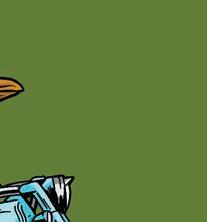
Thomas began to cultivate the nickname “the Mayor of Belmont.” He’d hang out at the Punkin’ Donuts parking lot in the hearse he’d bought to haul merchandise for his shop. He took it upon himself to monitor the crowds in an e ort to ensure that his potential clientele stayed out of trouble. “I was a 350-pound monster of a man, and if I walked up to you, grabbed you by the scru of your neck, and said, ‘You gotta go,’ ‘You’re going to jail,’ or ‘I’m gonna beat your ass,’ you did what I told you to do,” he says. “I kept the lid on the corner of Belmont and Clark.”
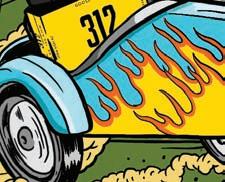


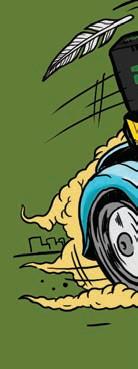
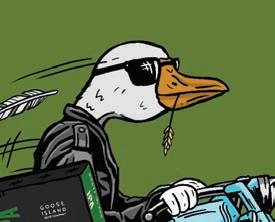
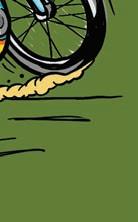

Alderman Hansen noticed, and asked Thomas to keep an eye on the neighborhood
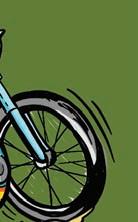
APRIL 9, 2020 - CHICAGO READER 27
https://www.gofundme.com/f/chop-shop-virtual-beats-amp-eats BIT.LY/GOOSEDELIVERS
around the intersection. Thomas says they would meet early in the morning a few times per week to talk shop; Hansen would ask his aide, future congressman Mike Quigley, to get Thomas coffee and a bagel from Punkin’ Donuts.
In 1988, Thomas began planting offshoot shops in empty storefronts nearby. Architectural Revolution, a furniture and decor shop for folks with tastes that ran toward punk and goth, opened at 3226 N. Clark; a lingerie and sex-toy store called Taboo Tabou opened at 854 W. Belmont. During its 90s peak, Thomas’s Lakeview empire included six shops, counting the flagship Alley location. He also formalized his role as neighborhood caretaker in 1992, when he cofounded the Central Lakeview Merchants Association.
By the mid-90s, the Alley was a symbol of Lakeview’s counterculture, though by then the grunge boom had mainstreamed punk to the point where it was only barely counterculture. As the neighborhood gentrified, so did punk.
When Punkin’ Donuts was at its peak in the mid- to late 1980s, Lakeview had a rough reputation. “It was still kind of hairy,” says Dwayne Thomas, a Cabrini-Green native. “People were like, ‘Ooh, that area is kind of crazy.’ It was, like, gangbangers, drug dealers, hookers, transgender people. It was a huge melting pot.” In the punk crowd around Belmont and Clark, antiracist skinheads rolled deep. “That was our area—we felt normal in that area,” Dwayne says. “People in my neighborhood didn’t dress like that and didn’t listen to that type of music. I saw people who dressed and believed in the same things I believed in—they had the same type of convictions. We fought the same kind of causes.”
Medusa’s employed skinheads to work security, and skins hung out at Punkin’ Donuts. Dwayne briefly worked at Halsted Street boutique 99th Floor, one of two area shops licensed to sell the skinheads’ footwear of choice, Dr. Martens boots (the Alley was the
other). He remembers 99th Floor owner Mick Levine as having the better selection. “He had all kinds of Docs—he had every style,” Dwayne says. “He would get the rare Docs that people were looking for. Flag Docs and checkerboard Docs—skins, punk rockers, everyone came to that place to buy their Doc Martens, so you met people and networked.”
The original 1960s skinhead subculture in the UK had welcomed Blacks and whites, but organized racist skinheads had existed since the late ’70s—and by the mid-1980s, they’d infiltrated punk scenes in many U.S. cities. In Chicago, a young neo-Nazi named Clark Martell began pushing his racist cause in 1984. His collective, Chicago Area Skinheads (CASH), sometimes called themselves Romantic Violence, which was also the name of a mail-order business they used to disseminate music and paraphernalia—it was the first U.S. distributor for notorious UK white nationalist band Skrewdriver, and became a valuable recruiting tool. By 1985, Martell’s exploits had made it into the Chicago scene report in Maximum RocknRoll : “The only hope we have to keep our scene together is to isolate the members and supporters (especially Clark Martell) of Romantic Violence and reject every piece and line of racist, sexist, and violent trash they try to push our way.”
In 1987, Martell and five CASH cronies made national news for brutally assaulting a woman who’d left the group. The Southern Poverty Law Center credits Martell with propagating U.S. racist skinhead culture in the 1980s. Before CASH, the SPLC estimated the number of racist skinheads at 200; by 1989, that number had exploded to 3,000.

The antipathy between racist and antiracist skinheads often expressed itself in physical violence, though as Dwayne tells it, CASH skins were usually the ones to start the fights. “They knew the faces of the kids who were really active, and they would drive around and look for those kids, and they would jump these kids,” he says. “Me being who I was, and the things I did, I would always be willing to go out and help—if
somebody jumps you, that shit’s not going. So we would go and hunt those guys down. They hunted us down? We went right back and hunted them down.”
These skinhead clashes spilled over into Punkin’ Donuts at least once. Dwayne ran into two female racist skinheads with a pit bull, which he says made a move for him—and because he was walking with a cane, having torn his left ACL, he couldn’t run. “I was like, ‘This dog is gonna bite the hell out of me,’” Dwayne says. “I whacked this dog and knocked the dog out.” According to a 1989 Reader story about skinheads by Bill Wyman, the confrontation touched o a brawl that nearly killed a friend of the racist skins. (Author and Columbia College professor Don De Grazia references it in his 1998 coming-of-age novel, American Skin.) By the late 80s, Dwayne had achieved minor local fame as an antiracist skinhead. When Oprah Winfrey brought white-power skins on her show in 1988, he was there to rail against them.
In fall 1988, a southern skinhead named Scott Gravatt stopped by 99th Floor looking for a place to crash, and Dwayne initially obliged. Then he and his friends learned more about Gravatt, who was also known as “Whitey Powers.” That night, they attacked him: they stuffed his Nazi armband in his mouth, hog-tied him, and dropped him in front of the Holocaust memorial in Skokie. Dwayne and his friends were arrested in Lincolnwood.
“That was the kind of thing you faced if you came around to the neighborhood and you were a Nazi, that was the danger you ran,” Dwayne says. “We would be out in the street, and you were not going home—you were gonna go to jail or go to the hospital, we just didn’t care.”
Christian Picciolini, one of Martell’s recruits, renounced his neo-Nazi beliefs in 1996 and has since dedicated himself to combating extremism—he’s cofounder of the nonprofit Life After Hate. But in the late 80s, he says, when he was still with CASH, he had to visit Lakeview clandestinely if he wanted to shop at the Alley or 99th Floor. He knew what areas to avoid:

“Punkin’ Donuts was a place we knew to go only if we wanted a fight.”
The crowds at Punkin’ Donuts were almost always peaceful, though, whether the people coming and going were in the neighborhood to shop or just to hang out. “It was such a touchstone for so many people of my generation, and even the following generation,” De Grazia says. “How many kids from Chicago, the midwest, and beyond hung out at or passed through that lot during certain phases of their lives? Tens of thousands? Hundreds of thousands?”
Punkin’ Donuts could also open up young people to unforeseen new experiences. DJ Duane Powell first traveled to the area from Roseland to go to Medusa’s, but he got hooked on the whole neighborhood—including Punkin’ Donuts. “I had never really been in a situation that was outside my community, my people, my race,” Powell says. “Then I’m up here, it was culture shock and it was education for me.”
For people like punk drummer Brian Czarnik, who first stopped by Punkin’ Donuts in 1989, the place provided an entree to the scene at large. “That year, the word ‘punk rock’ to me was still a little scary,” he says. “But I’m sure we walked in there and everything was fine. Then the next few years, whenever we went to the Alley and that, we’d always swing in there.” He’d frequently stop in the Dunkin’ Donuts to buy doughnuts as a cheap lunch—saving the rest of his money for band merch. Czarnik says he’d sometimes still feel like an outsider, but in the 90s his bands Oblivion and the Bollweevils put out music through Johann’s Face and other local punk labels, including Underdog and Harmless.
Harmless Records founder Scott Thomson remembers a night when a pair of cops picked him up after a Medusa’s show for violating curfew with a handful of other teens—he was 15, and it was probably 1989 or ’90, since he’s 45 now. The cops had previously cleared some kids out of the Punkin’ Donuts parking lot, and they chastised Thomson and the others for
28 CHICAGO READER - APRIL 9, 2020 ll
continued from 27
loitering too late. But then the o cers couldn’t find the curfew slips they needed, so they drove back to Punkin’ Donuts so the teens could call their parents and the cops could call somebody who had slips.
“They called in another unit,” Thomson says. “And then they called in another unit. At this point, we’re starting to attract a crowd, so suddenly the parking lot at Dunkin’ Donuts had three cop cars in it and these little kids standing around. They finally called in a watch commander. We got the guy in a white uniform, and he’s like, ‘What are you guys doing?’ They finally give us the curfew slips. Our parents finally take us home, and they’re livid at the cops for wasting everybody’s time.”
Turns out Punkin’ Donuts could be a place for the police to get together too.
People continued to hang out at Punkin’ Donuts well into the 1990s, and Scary Larry says he kept going there till 2000. The scene had changed, though. Medusa’s closed in June 1992. Later that year, Shelton began running a transplanted version of Medusa’s at the Congress Theater (Ingram tended bar there). The punk scene mostly moved to Wicker Park and Ukrainian Village, and then to Logan Square in 1994 after the Fireside Bowl began hosting all-ages shows.
Also in 1994, Green Day broke into the mainstream, exposing punk to new crops of young people who flocked to the Alley. Punkin’ Donuts was no longer an accidental crossroads for several subcultures—it had become a more monolithic expression of the mainstreaming of “alternative” culture. Many of the people who’d been regulars in the 1980s had grown out of wanting to hang out in the parking lot of a doughnut shop.
Mark Thomas continued expanding what he called his Alternative Shopping District, and in the early 90s he bought a second-floor Chinese restaurant near Punkin’ Donuts that gave him rights to part of its parking lot. “He bought that block and shut us down,” Dwayne says. “He’s going, ‘You guys can’t be here, blah blah, I don’t want you hanging out in my parking lot.’ We’re going, ‘Fuck you.’ We would always argue with him, but he owned the parking lot, so what could we do but not be on his property. Every time we’d hang out, he would basically call the cops or have us arrested.”
In the mid-90s, Thomas hired Dwayne for odd jobs. Among his tasks was to watch the Punkin’ Donuts lot for trucks from Lincoln Towing, whose drivers notoriously cased the place. (As part of his long public fight with the infamous towing company, Mike Royko wrote a 1988 Tribune column that focused on an inci-
dent at the Clark and Belmont Dunkin’ Donuts.) Dwayne’s job was to keep Alley customers from getting towed by making sure they didn’t use the wrong part of the lot. “He paid me 15 dollars an hour to stand in the parking lot,” he says.
In 1995, Thomas had a six-foot fence put up around the lot to deter loitering. “Mark Thomas was very notorious in not wanting the very people who made him who he was in the area anymore,” Dwayne says. “Which didn’t make any sense to me.”




Thomas knows that his success helped kickstart the gentrification that transformed Lakeview, and ironically the subsequent rise of chain stores in the area hurt his businesses. In 2014, he consolidated his offshoot stores into the Alley’s main shop, then located at 3228 N. Clark. He opposed opening the neighborhood to Target or other big boxes, and he brought the fight to 44th Ward incumbent Tom Tunney, challenging him in a protracted campaign that ended with Thomas losing the aldermanic election in February 2015. “I was upset at the direction Tom Tunney was taking Lakeview in,” Thomas says.
In 2013, BlitzLake Partners had purchased the land under Punkin’ Donuts (including Thomas’s part of the parking lot) for $5.5 million. After Reader contributor John Greenfield


heard in early 2015 that the Dunkin’ Donuts would soon be demolished, he organized a small farewell that February. Thomas attended.
In a DNAinfo story about the shop’s demolition in August of that year, Thomas said, “Belmont gave me the greatest life in the world.”
In January 2016, the Alley shuttered its shop at 3228 N. Clark. It’s reopened twice since then: once in August 2017 at 3221 N. Clark, where it lasted a little more than 14 months, and then again at 843 W. Belmont last year.
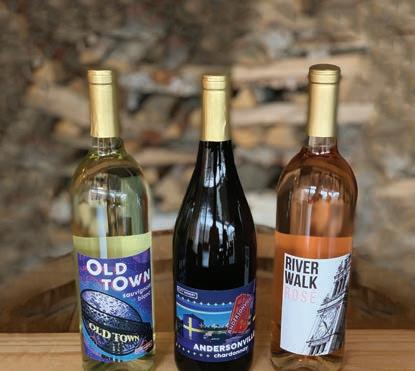
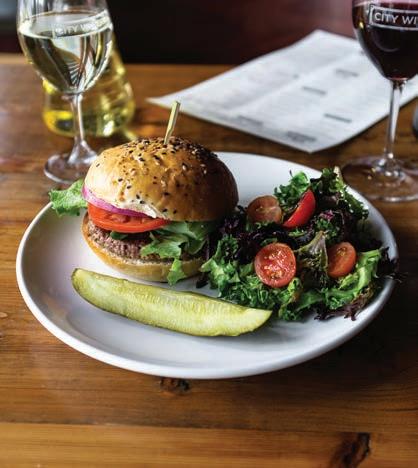
Also in January 2016, Chicago indie-rock band Scotland Yard Gospel Choir released a single called “Clark & Belmont.” Front man Elia Einhorn sings, “When we were young punks / Sittin’ out front of the Dunkin’ Donuts / Taking shit from the grown-ups / We never thought we’d be their age someday / We thought that it was our time and that our time was here to stay.”

The Target that now occupies the site opened the following summer.




















Shelton now runs Medusa’s as a teen club in Elgin, its home since 1997. Ingram and Padron live nearby, and they still talk about Punkin’ Donuts. “There will never be any place like it anywhere,” Padron says. “I never found another.” v
@imLeor


APRIL 9, 2020 - CHICAGO READER 29
w Support City Winery & Take Care of Yourself During this Difficult Time Visit www.citywinery.com/chicago for more information. thank you for your support! Help our employees with a donation, big or small Check out our carryout menu Let Us Feed You Produced in Chicago Available for pickup or delivery to your home Enjoy Our World-Class Wines Relief Fund
ROSCOE MITCHELL WITH OSTRAVSKÁ BANDA AND OTHERS, DISTANT RADIO TRANSMISSION
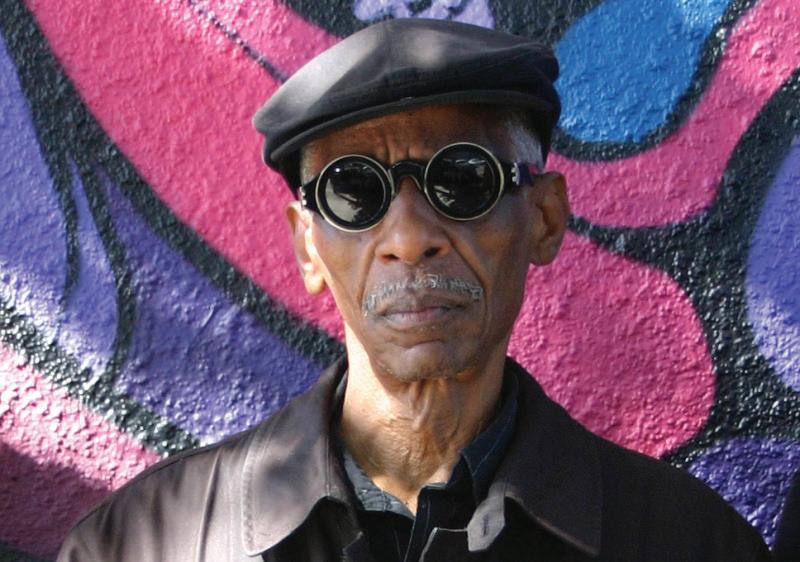
Hive widehive.com/roscoe-mitchelldistant-radio-transmission
Anna Calvi, Hunted Domino annacalvi.com
When British guitarist and vocalist Anna Calvi released her self-titled debut album in 2011, it felt like she’d emerged as a fully formed icon. Drawing from rock, punk, opera, and flamenco guitar, Calvi combined talent, eclecticism, and swagger in a way that had less in common with indie songwriters of her generation than with the likes of Annie Lennox, Prince, and Nick Cave. A er putting out her third full-length, 2018’s Hunter , she wrote music for season five of Peaky Blinders , and insofar as that job asked her to delve into the mind of crime boss Tommy Shelby, it might’ve inspired her to look at her recent work with fresh eyes. On the new Hunted, Calvi has stripped down seven songs from Hunter , with help from guests such as Julia Holter and Courtney Barnett. Though some of the material on Hunter was fairly minimalist to begin with—on “Away,” Calvi’s voice floats over guitar strumming and a hushed backdrop of shimmering strings—on the new versions she does away with all window dressing to zero in on stark, raw emotion.
WHEN THE ART ENSEMBLE OF CHICAGO reinvented itself as an orchestra for its 50th-anniversary recording, last year’s We Are on the Edge , the idea didn’t come out of thin air. It refl ected a use of the classical methods and sounds that the ensemble’s lone surviving founder, woodwind and percussion player Roscoe Mitchell, has been pursuing in his own work since the 1980s. The new album Distant Radio Transmission consists of four completely notated works, three of which are derived from Mitchell’s improvisational practice. “Distant Radio Transmission” began life as a free improvisation by Mitchell, keyboardist Craig Taborn, and percussionist Kikanju Baku, and was subsequently transcribed and rearranged
for orchestra. As performed by 31-piece Czech ensemble Ostravská Banda (joined by Mitchell’s trio), the piece has been expanded from a series of telegraphic exchanges of sonic information into a progression of rich textures charged by interjections from Mitchell’s stabbing sopranino saxophone and the absurdist syllable salad of vocalist Thomas Buckner. Mitchell doesn’t play on the rest of the record. “Nonaah Trio” and “Cutouts for Woodwind Quintet” transform material Mitchell first developed in the 1970s and 1980s into sharp-angled, cubist chamber music, while “8.8.88” is a dizzyingly complex work for Disklavier, a sort of computer-operated player piano. —BILL MEYER
On the updated “Eden,” a tale of hiding away with a lover during a rainstorm, Charlotte Gainsbourg’s whispers commingle with Calvi’s angelic croons to conjure an atmosphere even dreamier and more intimate than that of the original. But not every song is so rose-colored or escapist. Anchored by a driving guitar riff, the Hunter version of “Wish” feels powerful and determined, but the Hunted version (which features Idles vocalist Joe Talbot) pushes past the original’s bright, warm surfaces to something unhinged—it even gets a little maniacal when Calvi unleashes an operatic wail. That fierce mood continues through Hunted closer “Indies or Paradise” (the song appears midway through Hunter ), where she mixes banshee cries with hushed incantations and trades the original’s chic grooves for blistering guitar rhythms. Making a great record is hard enough, but making one in two distinct and equally enjoyable versions is a humbling accomplishment.
—JAMIE LUDWIG
Dool, Summerland Prophecy Productions dool-nl.bandcamp.com/album/summerland
30 CHICAGO READER - APRIL 9, 2020 ll
Wide
PICK OF THE WEEK Roscoe Mitchell reconciles improvisational sources and orchestral means Recommended and notable releases and critics’ insights for the week of April 9 MUSIC COURTESY WIDE HIVE RECORDS b ALL AGES F ELASTIC ARTS Donate to Elastic or become a member today Friend: Any donation (plus a free button!) Backer: $35-$99, or $6.25/month, button, invitations to member events. Subscriber: $100-$249, or $12.50/month, button, invitations to special events, 20% discount on most events, and Elastic T-Shirt. Supporter: $250-$499, or $25/month, button, shirt, two for one admission, and limited edition newsletter. Advocate: $500-$999, or $50/month, button, shirt, limited edition newsletter, plus free admission to most events. Philanthropist: $1,000+ or $100/month, all member benefits plus free admission to most events for you and a guest. Fostering local independent music Ⅱ art Ⅱ performance since 2002 Donate to Elastic
Helmed by charismatic vocalist and guitarist Ryanne van Dorst, Dool combine pop hooks with heady lyrics and complex songwriting that draws from the underbelly of metal, psych, doom, occult rock, and more. Formed in Rotterdam in 2015 by members of Dutch rock outfi ts Elle Bandita, the Devil’s Blood, and Gold, the band (whose name translates to “Wandering”) have yet to tour the States, but they made waves in the heavy-music world with their 2017 debut, Here Now, There Then. On their brandnew second album, Summerland (Prophecy Productions), Dool lean into the arena-friendly side of their sound without compromising their aesthetic. The album’s name nods to a pagan concept of the a erlife—an idyllic place the soul can visit between incarnations or settle in a er reaching a final ascension—and songs such as the title track and album closer “Dust & Shadow” are enhanced by otherworldly, majestic atmospheres. But Dool aren’t concerned solely with what happens a er we leave this plane, but also with the road traveled and personal evolution along the way. To that end, they’re more earthbound on tracks such as “Ode to the Future,” anchored by a rich strummed guitar rhythm reminiscent of Patti Smith classic “Dancing Barefoot.”
Van Dorst’s vivid lyrics often address themes of self-questioning and strife, and when they’re interwoven into rock epics such as “The Well’s Run Dry” (which features a spoken-word passage from Bölzer front man Okoi Jones), no challenge seems insurmountable. It’s easy to imagine radio-ready album single “Wolf Moon” and rock rager “Be Your Sins” (with a fiery Hammond organ solo by Swedish metal keyboardist Per Wiberg) as gateway drugs for mainstream rock and metal listeners who are primed to discover more esoteric sounds. Dool deliver on that front as well: “God Particle” features a Middle Eastern- inspired intro, a dynamic flow, and an intensity enriched by the album’s backing vocalist, former Devil’s Blood and current Molasses front woman Farida Lemouchi.
 —JAMIE LUDWIG
—JAMIE LUDWIG
MUSIC

G Herbo, PTSD Epic / Machine Entertainment Group soundcloud.com/gherbo
I wish the right-wing miscreants in the federal government were as dependable as Chicago rapper G Herbo. For close to a decade, he’s released albums and mixtapes of rapid-fire drill with reassuring frequency, and even his most run-of-the-mill offerings benefit from his pragmatic empathy and lucid descriptions—he brings a distinctive emotional gravity to his detailed lyrics about the harshness of the city’s impoverished Black enclaves. Born Herbert Wright, Herbo grew up in a part of South Shore so besieged by violence it became known as Terror Town, and in his music he captures both the up-close-and-personal feeling of mortal fear and a large-scale view of the structural inequality that created the circumstances of his life. That bakedin injustice continues to affect him: ever since his arrest for aggravated unlawful use of a loaded weapon in February 2018, for instance, Herbo has had to deal with local venues canceling his shows.

But he’s also used his prominent position to benefit those in need—most notably, as he explained in his episode of the TRiiBE’s Block Beat series in September 2018, he’s part of the team that bought Anthony Overton Elementary School (which Rahm Emanuel closed in 2013) to turn it into a hub for job training and youth afterschool programs. On the February album PTSD (Epic/Machine Entertainment Group), Herbo contemplates the lasting effects of growing up in a community where violence took so many of his friends—it may not be literally around the corner for him today, but it’s still playing out in his life, even now that he’s a genuine star ( PTSD debuted at number seven on the Billboard 200). He fills his raps to overflowing with anxiety, grief, and compassion, and he delivers his lines with enough force to convince you he can overcome anything. On tracks such as “Gangbangin,”
“Lawyer Fees” (featuring Polo G), and “PTSD” (with Juice Wrld, Chance the Rapper, and Lil Uzi Vert), Herbo transmutes his trauma into euphoria without

APRIL 9, 2020 - CHICAGO READER 31
G Herbo HALEY SCOTT
dismissing or oversimplifying the profound emotions that inspire his music. —LEOR GALIL

Human Impact, Human impact Ipecac humanimpact.bandcamp.com
If you haven’t already heard Human Impact, you could be forgiven for wondering whether the New York four-piece were soothsayers who’d prophesied humankind’s current struggle with an invisible threat. On “Respirator,” from the group’s new selftitled debut, vocalist and guitarist Chris Spencer (formerly of Unsane) laments, “We’ve made a mistake / Problems that can’t be undone / I see what this will bring / I see, respirator to breathe.” And on “Protestor,” which kicks off with plodding bass and off-kilter keys, Spencer delivers an eerily prescient opening line: “A virus we can’t control.” But this band of noise-rock luminaries—Spencer, bassist Chris Pravdica (Swans, Xiu Xiu), keyboardist Jim Coleman (Cop Shoot Cop), and drummer Phil Puleo (Cop Shoot Cop, Swans)—are so well-versed in dark, apocalyptic, and political themes that it was practically inevitable that some of their lyrics would resonate with our increasingly terrible reality. The longtime friends formed Human Impact in 2018, then spent much of 2019 writing material before making their live debut in New York last August. It’ll be a while before the rest of the country gets to experience the band onstage, but the new album should mollify curious fans (though it might also make the wait for a live show even more difficult). Human Impact aren’t reinventing the wheel—these guys know what they’re good at, and they’re sticking to it, crafting masterful songs whose cacophonous noise, gritty playing, and inescapable hooks summon an atmosphere of despair, dissatisfaction, and isolation. The effect is uncomfortable, for sure, but it’s also cathartic—sometimes the only way to find hope is to dive through the muck.
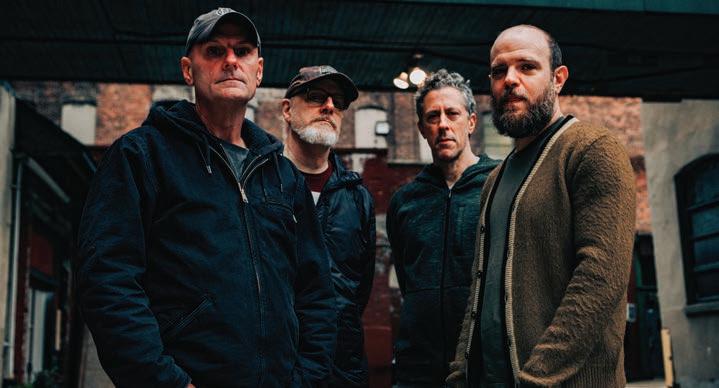 —JAMIE LUDWIG
—JAMIE LUDWIG
Igorrr, Spirituality and Distortion Metal Blade
igorrr.bandcamp.com/album/spirituality-anddistortion
In the tradition of heavy-music genre splicers such as Mr. Bungle, Secret Chiefs 3, and Estradasphere, French act Igorrr hybridizes industrial death metal, breakcore, chiptune, and other genres using a dizzying array of seemingly unrelated styles and instruments. Songwriter, DJ, and guitarist Gautier Serre weaves Baroque music, Balkan folk, Eastern motifs, operatic vocals, and death growls into a fabric made from sludgy midtempo riffs, breakneck drum fills, and all manner of digital manipulation. Originally a solo digital project, Igorrr expanded to include guest musicians in the early 2010s, and the 2017 album Savage Sinusoid expanded the lineup to a full band with a bevy of guests, including vocalist Travis Ryan (Cattle Decapitation), accordionist Adam Stacey (Secret Chiefs 3), and nearly a dozen classically trained instrumentalists. Following a tour around Europe and the States (on which Serre was joined by a live drummer and two vocalists), Igorrr is back with Spirituality and Distortion (Metal Blade), the group’s fourth full-length and its second consecutive album devoid of samples. The most notable addition to the already jam-packed combo of genres is Middle Eastern folk, which widens the music’s timbral palette and increases the occurrence of meditative moments and dancing opportunities. “Downgrade Desert” and “Camel Dancefloor” are the most obvious examples, thanks to the extended oud intro and distinctive melodic scale in the former and the infectious groove in the latter. “Nervous Waltz” borrows more from Western classical; it begins with a beautiful triple-feel string quartet with IDM rhythms and harmonized operatic singing before blastbeats and a quick-twitch piano melody segue into a chuggy breakdown. On “Parpaing,” Cannibal Corpse front man George “Corpsegrinder” Fisher lends his guttural vocals to a digital deathfest interrupted by aggro bitcore. A Frenchy accordion lead pairs with grind and black metal on “Musette Maximum,” and the übercatchy “Polyphonic Rust” uses interludes by what
32 CHICAGO READER - APRIL 9, 2020 ll
sounds Human Impact JAMMI YORK continued from 31 MUSIC Find more music listings at chicagoreader.com/soundboardStay Home. Stay Positive. Stay Connected. oldtownschool.org We can’t wait to get back to making music and dancing together at the Old Town School! In the meantime, many of our classes are currently running online, and we are actively working on more ways to keep you making music and learning new things with us, from home, in the near future. We are so thankful to be part of the wonderful and supportive arts community in Chicago and are especially thankful for all our dedicated students and teaching artists persevering with us during this time. For updates, rescheduled concert info, ways to help support our staff & more please visit oldtownschool.org/alert Stay safe, sane, and keep on playing from all of us at Old Town School of Folk Music!
vaguely like an Eastern European women’s choir to color some of the best head-banging material on the entire album. Spirituality and Distortion can change styles or moods on a dime, and it matches its technical and melodic excellence with its boundary-defying imagination.
—SCOTT MORROW
RXM Reality, Blood Blood Blood Blood
Hausu Mountain hausumountain.bandcamp.com/album/bloodblood-blood-blood
Enforced mass social isolation can really make you crave constant stimuli. As each day feels longer than the one before, the slow crawl of hours makes the frenetic dance music on Blood Blood Blood Blood—the latest howler from Chicago-based producer RXM Reality, aka Mike Meegan—sound like a salve. It’s Meegan’s sixth album under that name and his most tightly crafted yet, brimming with ideas. “Exhale” evolves from glossy synth arpeggios to cryptic, fumbling beats, then employs an angelic vocal sample. On “Deaths, Resurrections, and Ascensions” Meegan plays a similar trick: a er creating an airy, dizzying vortex of electronics, he injects it with glistening blips and an almost wistful atmosphere. The tracks mutate freely, shaped with the type of confidence that makes for a gripping listen; the constant chaos rarely gives you a moment to catch your breath. Despite their superficial fragmentation, though, Meegan’s jittery productions feel fully formed—like mini worlds unto themselves. This is the key to the success of Blood : no single moment feels more important than any other. Every second contains another explosion of fractured sonics, and they all jell together due to the album’s inspired restlessness.
—JOSHUA MINSOO KIM

Various Artists, Machine Machine Wash Music
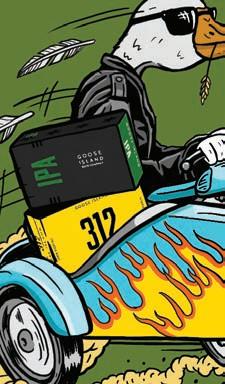

machinewashmusic.bandcamp.com/album/ machine
Chicago has many independent hip-hop labels, but few maintain rosters as multigenerational as that of Machine Wash Music. Rapper Daryl “Decay” Stew-


MUSIC
art cofounded Machine Wash a er he had an unsatisfying experience putting out his 2008 album, The Unlikely Hero, through Molemen Records—he wanted a more mutual artist-label relationship. “The process wasn’t the same and I didn’t enjoy making that record as much,” Stewart told Voyage Chicago in 2018. “I went back to my friends and felt we needed to help artist [ sic ] realize their dream without taking their control.” Machine Wash doesn’t even have a dozen releases yet, but on the new compilation Machine, the label rolls deep, documenting the many current dimensions of underground Chicago hip-hop. Machine features savvy youngsters (Defcee, Green Sllime), long-grinding veterans (Encyclopedia Brown, Stewart’s alter ego Decay, the Llama), producers from the arty beat scene (Lanzo, Uncle El), and an MC who helped build the foundation for the local scene (Ang13). The comp reframes hip-hop with a peculiar new slant, even when the big-footed beats and rubbery wordplay carry a whiff of tradition—and even the cuts that defy convention sometimes feel like long-lost classics. On “Rats,” rapperproducer Green Sllime attacks a bleary instrumental with glorious non sequiturs like he’s slicing through underbrush with a machete. Few artists sound like Sllime, and I wish more would take notes.
—LEOR GALIL


Various Artists, Whispers: Lounge Originals












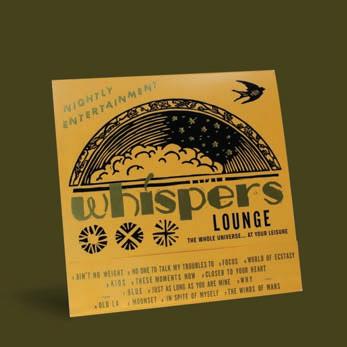
Numero Group










numerogroup.com/products/whispers-loungeoriginals



A couple years ago, Chicago archival label Numero Group launched Cabinet of Curiosities, a compilation series focused on fringe private-press releases of yore. A lot of the strange music they’ve reissued under this banner intensely evokes the eras in which its creators lived, and Cabinet of Curiosities comps are unified less by genre than by spirit. The 1980s electronic sounds on 2018’s Escape From Synth City , for example, include glacial new age (“Konya” by Al Gromer Khan), chintzy boogie (“Intellectual Thinking” by New World Music), and progressive house (“Whirr” by Reader contributor Frank Youngwerth); the LP sleeve looks like a classic NES cartridge, a theme that Numero took further by creating an Escape From Synth City side-scrolling video game. The songs on the new Whispers: Lounge Originals ooze the laidback essence of 1960s hotel bars, martini glasses, and Pat Boone, but the artists push the concept of lounge music to its outer edges. “Kids,” a lo-fi, bittersweet shot of blue-eyed soul from Minnesota singer-songwriter Chuck Senrick, rubs shoulders with “These Moments Now,” a bizarre intergalactic psych-rock romp by North Dakota act Justen O’Brien & Jake. Lounge music generally doesn’t try to draw much attention to itself, but the odd, twisted, and boldly beautiful songs on Whispers definitely deserve it. And this time the LP sleeve looks like a matchbook, naturally. —LEOR GALIL v

We’re all in this together!
APRIL 9, 2020 - CHICAGO READER 33
The cover of the compilation Whispers: Lounge
Originals COURTESY NUMERO GROUP pleaserecycle thispaper
BIT.LY/GOOSEDELIVERS
The untold story of Joe Mantegna’s teenage garage band
Maybe you know that the Apocryphals existed, but we’re willing to bet you haven’t heard all this.

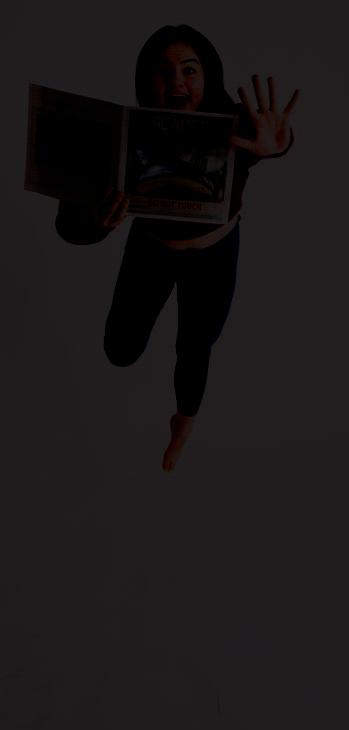 By STEVE KRAKOW
By STEVE KRAKOW
If you didn’t know that actor Joe Mantegna played in a garage band called the Apocryphals in high school and college, you’re not alone. I had the privilege of getting the story from the man himself, and as far as I’m aware, what you’re about to read is the most detailed account of the group’s history published anywhere.
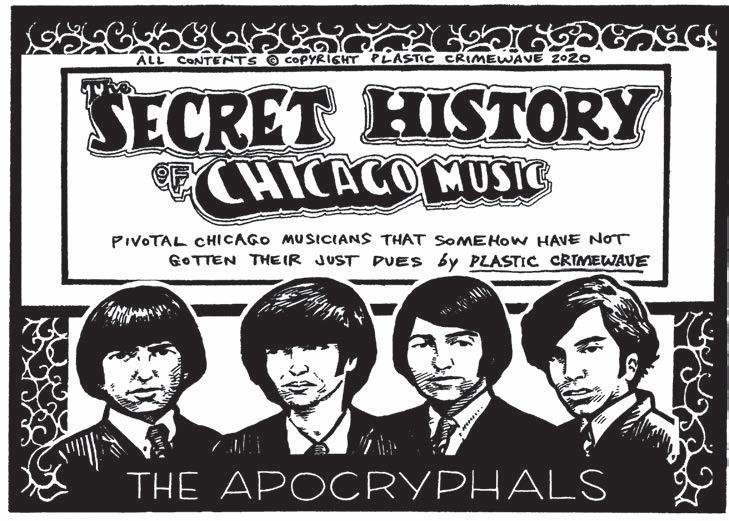
Mantegna was born in Chicago to Italian immigrants on November 13, 1947, and as a kid he regularly attended his older brother’s accordion recitals. He didn’t initially have much interest in making music himself—he got an earlier start as an actor, playing a dog and a pixie in hospital shows while being treated for rheumatic fever at age eight. Mantegna does remember entertaining his family by doing an impression of popular singer Johnnie Ray, though, specifically his 1951 tune “The Little White Cloud That Cried.”
During Mantegna’s junior year at Morton East High School in Cicero, his English class was assigned a project on British culture. His classmates Art Stout, Ricky Johnson, and
Neal Sordelli decided it’d be hilarious to make their project a Beatles tribute band (it was 1963, after all), so they christened themselves the Weasels and donned Beatles wigs. They couldn’t be the Fab Four with only three kids, though, and they needed somebody to play bass and sing. Mantegna could carry a tune but couldn’t play an instrument, so they got him a regular guitar that he learned his way around well enough to get by, sticking to the lowest four strings as though it were a bass. The Weasels were an instant hit, and suddenly started getting invites to play local sock hops and teen dances—which convinced the band there was actually money to be made. They got encouragement from Mantegna’s mentor and drama teacher at Morton East, Jack Leckel, who also ran the theater departments at Morton West in Berwyn and a nearby junior college. Leckel came up with the name “the Apocryphals” (the band didn’t even know what it meant at first) and helped them buy their first sound equipment. He also suggested they wear frills, pearls, and one glove, but he
was a little too far ahead of his time for Chicago. “We just thought of ourselves as a rock ’n’ roll band, not a glam band,” Mantegna says. “We’re thinking, ‘What, this is nuts!’ But then bands like the Beau Brummels came along and did stu like that.”

Mantegna got a real bass at a pawn shop, and when Stout and Johnson left the Apocryphals, the band brought aboard drummer Tom Massari and guitarist Chris Montagna. Leckel asked the group to write a song for a school play, so Mantegna and Sordelli came up with “Bernardine”—which in 1965 became the A side of the Apocryphals’ first small-press 45 (Leckel chose the B side, “Gloomy Sunday,” aka “the Hungarian Suicide Song,” made famous in the States by a Billie Holiday cover in ’41).
The band did mostly R&B covers, gigging at north-side clubs such as the Cheetah, the Holiday Ballroom, and My Sister’s Place. They ended up playing with several notable locals, including the Missing Links (three members of which would help form the Chicago Transit Authority in 1968) and a very green Ides of March (whose front man, future superstar Jim “Eye of the Tiger” Peterik, got his first studio experience playing tambourine with the Apocryphals). They eventually secured management with Joe Sugarman, who in the 90s would strike it rich as the creator of BluBlocker sunglasses. In the late 60s he brought the Apocryphals to the Mad label, founded by bar-walking sax honker Tommy Jones, and it released three of the band’s five singles. Sugarman also helped the Apocryphals land opening slots for bigger national acts, among them Paul Revere & the Raiders and Sam the Sham & the Pharaohs. In April 1968, they warmed up for Neil Diamond the night after Dr. Martin Luther King Jr. was assassinated.
Mantegna began studies at the Goodman School of Drama at DePaul in 1967, and until ’69 he was able to keep playing in the band. But as soon as he made his professional acting debut—a role in a 1969 production of Hair that required him to do eight shows per week, spread over six days—the writing was on the wall. The rest of the band had been wanting to move in a heavier direction (you can hear hints of it on the psychedelic Sordelli original “Images”), so the Apocryphals called it a day. The other three members added some players and carried on as the horn band Rajah, with Mantegna occasionally filling in on vocals until he got another role in Godspell. Massari, Sordelli, and Mantegna remain friends to this day—and Mantegna is also close with the founders of Chicago he met through the Missing Links. v
34 CHICAGO READER - APRIL 9, 2020 ll MUSIC
See you on the other side, Chicago. chicagodancesupply.com Rattleback RECORDS ANDERSONVILLE'S FULL SERVICE RECORD STORE WE WANT TO WISH YOU ALL HEALTH & PEACE DURING THESE CHALLENGING TIMES WHILE OUR SHOP IS TEMPORARILY CLOSED WE’RE HAPPY TO SHIP YOU ANY MUSIC YOU’RE LOOKING FOR! www.rattlebackrecords.com
EARLY WARNINGS
Year of the Knife, Never Ending Game, Choice to Make, Answer 5/9, 8 PM, Cobra Lounge, 17+
UPDATED
WOLF
DURING HER rousing afternoon set at last summer’s Pitchfork Music Festival, Chicago soul and gospel legend Mavis Staples claimed she was thinking of running for president to help get rid of “the orange face up in the office.” Let’s be frank—she wouldn’t even have to ask for Gossip Wolf’s vote! On Friday, Staples dropped “All in It Together,” a slippery, Stones-y new single she wrote with longtime collaborator Jeff Tweedy that benefits the Senior Viral Response program of Chicago nonprofit My Block My Hood My City, which aims to get hand sanitizer, groceries, and other necessities to isolated members of the city’s aging population during the COVID-19 pandemic. It’s worth buying just for the cause, but you also get to hear an amazing ensemble that includes Tweedy’s Wilco bandmate Glenn Kotche, singer Akenya Seymour, and the terrifi c honky-tonk piano of Scott Ligon The song is selling via Bandcamp for $1 or more, so use that “more” option if you can!
For three weeks now, experimental musician Mukqs , aka Hausu Mountain cofounder Maxwell Allison, has released a new weekly EP, recorded live with no overdubs, straight to Bandcamp. He began March 20 with the glitchy, glassy Anaglyph , made by running old recordings through a sampler and loop pedals. He followed it up March 27 with the whimsical Specular, and on April 2 he dropped the anxious, warped Choronzon . He intends to keep going for the foreseeable future—thanks to Mukqs for something to look forward to while we’re stuck at home!
Gossip Wolf caught wind of rising local soul man Nate Barksdale after he dropped the sophisticated EP Neon Soul in September, and he’s since self-released three more. On the latest EP, last month’s Spiritual , Barksdale colors his luxurious melodies with touches of funk and hiphop that bring out the earthiness in his sensual voice. He’s still on the Tonic Room schedule for May 14, but we’ll see how that goes! —J.R. NELSON AND LEOR GALIL
Got a tip? Tweet @Gossip_Wolf or e-mail gossipwolf@chicagoreader.com.

NEW
Algiers, Ganser, Pirate Twin DJs 12/4, 10 PM, Empty Bottle Gary Allan 6/4, 7:30 PM, Genesee Theatre, Waukegan, on sale Fri 4/10, 10 AM b Shamarr Allen & the Underdawgs 10/7, 8 PM, SPACE, Evanston b Apocalyptica, Lacuna Coil 2/17/21, 8 PM, House of Blues, 17+
Asking Alexandria, Falling in Reverse, Wage War, Hyro the Hero 5/29-5/30, 6:30 PM, House of Blues b Bad Bad Hats 5/3, 7:30 PM, Schubas, 18+
Birthday Bands BBQ featuring Star Vehicle, Man’s Body, Kim, John Greenfield’s Rock Band 6/7, 2 PM, Hideout Bloodbath, Necrot, Cardiac Arrest, Tragedy of Mine 5/28, 8 PM, House of Blues, 17+ Blunts & Blondes, Subdocta, Bawldy, Smokahauntas 7/17, 8 PM, Concord Music Hall, 18+ Michael Bolton 8/26, 7:30 PM, Arcada Theatre, Saint Charles b
Brent Cobb, Maddie Medley 6/16, 8 PM, SPACE, Evanston b Joan Collaso 5/27, 7:30 PM, the Promontory b Crossroads Quintet, Dustin Laurenzi (solo) 5/11, 9 PM, Elastic b Dakhabrakha 9/25, 8 PM, Patio Theater b Danileigh 6/1, 6:30 PM, House of Blues b
Elder, Bask, Flesh of the Stars 11/28, 7 PM, Reggies’ Rock Club, 17+
Elephant Stone, Al Lover, Tinkerbelles 5/9, 9:30 PM, Sleeping Village Eradicator 10/10, 7 PM, Reggies’ Music Joint
Damien Escobar 11/7, 6 and 9 PM, City Winery b Flesh Panthers, Bobby Lees, Furr 5/22, 10 PM, Schubas, 18+ Foghat, Hi Infidelity 9/26, 8 PM, Arcada Theatre, Saint Charles b
Foreign Air, J Ember 6/9, 8 PM, Schubas, 18+ Furious Bongos 11/4, 7:30 PM, Reggies’ Rock Club, 17+ Paul Giallorenzo Trio 5/2, 8:30 PM, Constellation, 18+ Harold Green & Flowers for the Living 5/8, 7:15 PM, the Promontory b Noah Gundersen 10/9-10/10, 9:30 PM, Hideout Steve Hauschildt 5/29, 10 PM, Sleeping Village Martin Hayes Quartet, Martin Hayes & Dennis Cahill duo 11/13, 8 PM, Maurer Hall, Old Town School of Folk Music b Illegal Crowns 6/19, 8:30 PM, Constellation, 18+ Jazz Hoofing Quartet featuring Jumaane Taylor 5/22, 8 PM, the Promontory b Melvin Knight, Nate Barksdale, Stnfxce 5/14, 9 PM, Tonic Room
Legions of Metal Fest featuring Stygian Crown, Rods, Exciter, Midas, Beretta, Slough Feg, Vain, Ritualizer, War Cloud, Antichrist, Cerebus, By Fire & Sword, Greyhawk, Silver Talon, Intruder, Voltage, Prelude to Ruin, Sanhedrin, Reflexicon, and more 9/4, 5 PM; 9/5, 3 PM, Reggies’ Rock Club Lúnasa 9/19, 5 and 8 PM, Maurer Hall, Old Town School of Folk Music b Midwest Live & Loud day one featuring Forced Reality, Vis Vires, Take, Fear City, Besmerchers, Ultra Sect 9/4, 2 PM, Cobra Lounge, 17+ Midwest Live & Loud day two
featuring Haymaker, Doug & the Slugz, Reapers, Divided, King Cans, Suede Razors 9/5, 5 PM, Cobra Lounge, 17+ Midwest Live & Loud day three featuring Mephiskapheles, Hub City Stompers, Crombies, Boomtown United 9/6, 4 PM, Cobra Lounge, 17+ Andy Milne & Unison 5/14, 8:30 PM, Constellation, 18+ Buffalo Nichols 5/22, 7 PM, Hideout Johnny Rivers 8/23, 7 PM, Arcada Theatre, Saint Charles b Eric Roberson 7/1-7/2, 8 PM, City Winery b Phoebe Ryan, Ezi 6/10, 8:30 PM, Sleeping Village Shabaka & the Ancestors 6/13, 8:30 and 10:30 PM, Constellation, 18+ Adam Shead’s Finding Home, Jake Wark & Angelo Hart 5/4, 9 PM, Elastic b Damon Short Quintet, Paul Hartsaw Trio 6/22, 9 PM, Elastic b
Ricky Skaggs 11/1, 5 PM, Arcada Theatre, Saint Charles b Southern Culture on the Skids 10/14, 8 PM, FitzGerald’s, Berwyn Steeldrivers 10/4, 8 PM, City Winery b
Mo Troper, Magic Ian, Jackson Davis, Rusty Gorts 9/21, 7 PM, Reggies’ Music Joint Warning, Junkbunny 10/23, 7 PM, Subterranean b David Wilcox 10/24, 8 PM, Szold Hall, Old Town School of Folk Music b Jess Williamson 6/11, 9 PM, Sleeping Village WNUR’s Power Pop Shoppe presents Lovepunch, Annie & the Orphans, Dry Look 5/15, 9 PM, Hungry Brain Derek Worthington’s Lossy Codecs 5/7, 9 PM, Elastic b
NOTE: This is a selection of the many concerts have been canceled or postponed in light of ongoing concerns about COVID-19. We suggest that you contact the point of purchase if you need information about refunds, ticket exchanges, or postponed concert dates
Acid Mothers Temple & the Melting Paraiso U.F.O. 2/26/21, 8 PM, Subterranean, rescheduled; tickets purchased for original date will be honored
Alkaline Trio, Bad Religion 4/18, 8 PM, Radius Chicago, postponed until a date to be determined, 17+ Antibalas 9/17, 9 PM, Sleeping Village, rescheduled; tickets purchased for original date will be honored
Blackwater Holylight, Lume 7/8, 9 PM, Sleeping Village, rescheduled Bowling for Soup, Guardrail, Run Around 8/27, 8 PM, Bottom Lounge, rescheduled, 17+ Anna Burch, Long Beard 8/30, 9 PM, Sleeping Village, rescheduled Brandy Clark, Kelsey Waldon 8/22, 8 PM, SPACE, Evanston, rescheduled b Clem Snide 7/17, 8:30 PM, FitzGerald’s, Berwyn, rescheduled Elrow 5/2, 8 PM, Radius Chicago, postponed until a date to be determined, 18+ Flor de Toloache 11/12, 9 PM, Sleeping Village, rescheduled Sue Foley 8/9, 7:30 PM, SPACE, Evanston, rescheduled b Fu Manchu 3/24/21, 9 PM, Bottom Lounge, rescheduled, 17+ GBH, M.D.C. 5/9, 7 PM, Reggies’ Rock Club, canceled, 17+ A Giant Dog 5/14, 9:15 PM, Empty Bottle, canceled Justin Hayward, Mike Dawes 11/1-11/2, 8 PM, City Winery, rescheduled b Heartsfield 7/25, 8:30 PM, FitzGerald’s, Berwyn, rescheduled
Illegal Smile, Ryan Schultz Trio 4/22, 9 PM, Hungry Brain, canceled Gregory Alan Isakov, Leif Vollebekk 6/10-6/11, 8 PM, Fourth Presbyterian Church of Chicago, canceled b Kevin Krauter, Sports Boyfriend, Deals 7/28, 8 PM, Schubas, rescheduled; tickets purchased for the original date will be honored, 18+ Liturgy, Leya, Anatomy of Habit 8/21, 10 PM, Empty
Bottle, rescheduled; tickets purchased for original date will be honored
Loote 7/15, 8 PM, Schubas, rescheduled b Ludo 7/25, 6:30 PM, House of Blues, rescheduled; tickets purchased for original date will be honored b
Taj Mahal Quartet 9/28, 6 and 9 PM, City Winery, rescheduled b
Stephen Marley 7/19, 8 PM, SPACE, Evanston, rescheduled; tickets purchased for original date will be honored b
John McCutcheon 10/16, 5 PM, Szold Hall, Old Town School of Folk Music, rescheduled b The Necks 8/4-8/5, 8:30 PM, Constellation, rescheduled, 18+
Gilbert O’Sullivan 4/16/21, 8 PM, City Winery, rescheduled b
Ruby the Hatchet 5/27, 9:30 PM, Empty Bottle, canceled
Sheila E. & the E-Train 9/13, 5 and 8 PM, City Winery, rescheduled b Squarepusher, Hieroglyphic Being 12/3, 9 PM, Metro, rescheduled; tickets purchased for original date will be honored, 18+
Steepwater Band, Angela Perley 8/29, 8:30 PM, FitzGerald’s, Berwyn, rescheduled Stereolab, Deradoorian 5/10, 7:30 PM, the Vic, postponed until a date to be determined, 18+
Al Stewart, Empty Pockets 5/7, 8 PM, SPACE, Evanston, rescheduled b TC Superstar, Uma Bloo, Nordista Freeze, Nick DeLaurentis 4/23, 9 PM, Sleeping Village, postponed until a date to be determined
Tennyson 4/25, 9 PM, Sleeping Village, postponed until a date to be determined
Tokimonsta 2/13/21, 7 PM, Metro, rescheduled; tickets purchased for original date will be honored, 18+
Happy Traum 9/20, 2 PM, Szold Hall, Old Town School of Folk Music, rescheduled b Vagabon, Angelica Garcia 11/12, 8 PM, Maurer Hall, Old Town School of Folk Music, rescheduled b
Kurt Vile, Cate Le Bon 9/8-9/9, 8:30 PM, Thalia Hall, rescheduled and show added, 9/8 sold out, 17+ v
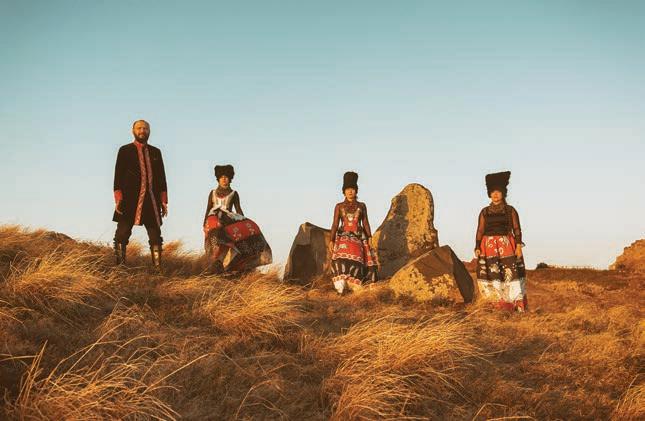
APRIL 9, 2020 - CHICAGO READER 35
Never miss a show again. Sign up for the newsletter at chicagoreader. com/early
CHICAGO SHOWS YOU SHOULD KNOW ABOUT IN THE WEEKS TO COME b ALL AGES F A
furry ear to the ground of the local music scene
GOSSIP
WOLF
BY KEITH HERZIK
Dakhabrakha ANDRIY PETRYNA
By DAN SAVAGE




Q: My boyfriend and I live in San Francisco where we’ve been sheltering in place. We are unfortunately unable to shelter together, which means that we cannot have physical contact, especially since he lives with a parent who’s at heightened risk. (It’s not an option for him to stay with me for the duration.) We’re as frustrated about having to abruptly end the physical aspect of our relationship as you might expect. We go for (distanced) walks during the week, we talk everyday, and we jerk off in front of webcams together but that only goes so far. I was thinking about giving him some of my worn panties for him to do whatever he wants with. My question is this: If I were to wash my hands and be cautious while putting together a pervy care package, is there much of a
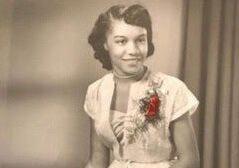







risk of spreading the virus around by doing this? I’m currently in good health but I know that people can be infected but asymptomatic and we’re being really careful to keep both of our households as safe as possible. Can the virus be spread via pussy juice?
—VERY AROMATIC GIFT





A: COVID-19 hasn’t been detected in vaginal fluids, VAG, so your pussy juice by itself doesn’t constitute a threat. But the virus, which is usually transmitted through the air (by people with the virus coughing, sneezing, or even exhaling), can survive for hours or days on different kinds of surfaces, including clothes. The virus can live for up to 24 hours on cardboard, VAG, which means it’s the package, not the panties, that are potentially a danger here. If the last person


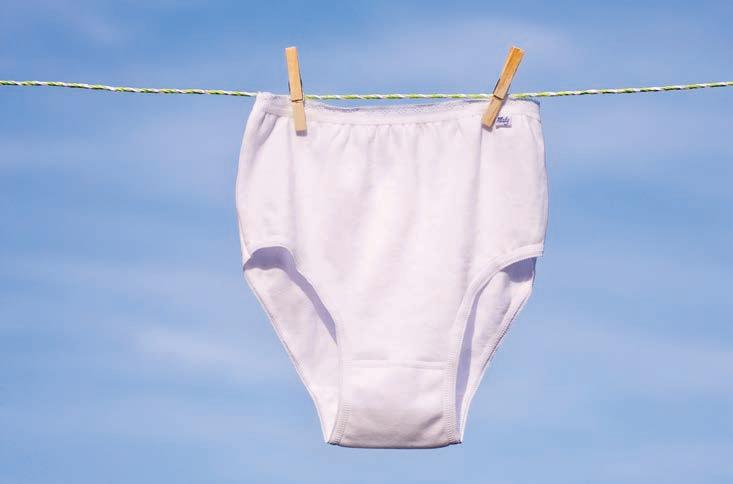
who handled your care package—think the UPS guy who dropped it on his porch—had COVID-19, your boyfriend could wind up exposing himself by touching the box and then his face before washing his hands. But I think you should send him that package—but wear gloves while you pack it, don’t send it overnight (your scent will keep for a couple of days), and make sure your boyfriend immediately washes his hands a er opening and discarding the package.
Q: I have a kink/fetish that’s been giving me a lot of anxiety over the last few years. I inadvertently discovered that I’m turned on by big bellies, weight gain, and stuffing. It’s actually been there since I was a little kid, though I didn’t understand it until


36 CHICAGO READER - APRIL 9, 2020 ll
SAVAGE LOVE The package, not the panties, is what’s dangerous When webcam sex just isn’t enough.
OPINIONthe cannabis platform a Reader resource for the canna curious ILLINOIS CANNABIS CONVENTION NEW DATES: October 9-10, Chicago Hilton necann.com nuMed.com | 1308 W. North Ave Chicago’s friendliest cannabis shop Thursdays on Cannabis Conversations chicagoreader.com/joravsky www.rosecenterforintegrativehealth.com KetamineSessions MedicalCannabis 180N.MichiganAve. Chicago,Ill60601 833-226-6362 C M Y CM MY CY CMY K Cannabis Conversations chicagoreader.com/ joravsky To advertise, call 312-392-2934 or email ads@chicagoreader.com www.neuromedici.com 312-772-2313 Findouttoday ifmedical cannabisorinfusiontherapyis rightforyou.Telemedavailable! Yourpartnersinhealthandwellness. Serving medical cannabis patients since 2015. An Essential Calm. Day or Night. Whole-plant hemp formulations for peace of mind and body. mineralhealth.co
OPINION
now. If it’s relevant, I’m a female in my mid-20s, in a heterosexual monogamous relationship. My problem is that I have a lot of trouble getting off without looking at pictures or at least thinking about my kink. I believe the common guidance is, “If it’s not hurting anyone, it’s fine.” But I feel super gross and ashamed. Neither my partner nor myself is large and we both value our health and fitness. I have absolutely no desire to participate in this activity with a real person. Every time I finish masturbating, I feel embarrassed and disgusted with myself. Some part of my brain obviously craves the kink, but the rest of my brain HATES it. I keep telling myself I will stop, but I have such a hard time getting off with other porn (or without porn) that I always return to it. I genuinely enjoy having vanilla sex with my partner.
everyone’s kinks—are hardwired. “Nobody knows why some people are more prone to developing unusual patterns of attraction than others,” Bering said. “But whether it’s a penchant for Pokémon, feet, underwear, or spiders, the best available evidence suggests that some people—mostly males—have a genetic predisposition for being ‘sexually imprinted’ during development.”
And once our erotic imaginations have seized on something, once we’ve imprinted on Pokémon characters or big bellies or wrestling singlets, there’s not much we can do about it. Before we’re adults—before we hit puberty—our kinks, as Bering put it, are “pretty much fixed, like it or not.”

realistic option.


That said, some doctors have prescribed selective serotonin reuptake inhibitors (SSRIs), aka antidepressants, to people who were uncomfortable with their kinks. Those drugs don’t selectively eradicate kinks, BBW, they crater a person’s libido. Taking SSRIs would mean sacrificing the vanilla sex you enjoy with your partner on the same altar with the kink that stresses you out. I can’t imagine you want to go down either of these routes, BBW, which brings us back to embracing your kink and coming clean with your partner.
I feel turned on and I have fun. But I’m o en not able to come. It sometimes makes him think he isn’t doing a good job, when in reality he’s doing great and I’m just frustrated with my body. So I guess I’m wondering: Does continuing to watch belly porn reinforce the kink in my brain? Should I stop watching it and force myself to find other ways to come? Should I somehow find a way to embrace the kink instead?
—BIG BELLY WOES
A: Six years ago I roped Dr. Jesse Bering, author of Perv: The Sexual Deviant in All of Us, into answering a question from a dad who was worried about his teenage son’s sexual interest in Pokémon. (Yes, Pokémon.) Dad wanted to know if there was anything that could be done about his son’s “pathetic” sexual obsession. Bering explained that his kid’s kinks—that
For all we know, the teenage boy with the Pokémon fetish was completely comfortable with his own niche sexual interests. The dad wrote in, after all, not the kid. (But if you’re a 23-yearold Pokémon fetishist and your dad routinely invaded your privacy when you were a teenager and heaped shame on you about your kinks, please write in with an update!) But I have heard from people who, like you, weren’t comfortable with their own kinks, BBW, and desperately wanted to know what could be done. Most sex scientists and researchers agree with Bering: there’s really nothing you can do and masturbating to the porn that turns you on doesn’t “reinforce” your kinks. You can’t starve out your kinks by refusing to think (or wank) about them, BBW, and you can’t pray your kinks away anymore than I could pray my gay away.

Embracing your kinks and exploring them with other consenting adults—or if your kinks can’t be realized for ethical reasons, enjoy them through solo or partnered fantasy play only—is the only
The risk you run telling a partner about your kink is no doubt the forefront of your mind, BBW, because the consequences could be immediate, i.e. he might dump you. But not telling your partner about your kink—and leaving him to wonder why you can’t get off with him but have no trouble getting off alone— isn’t risk free either. If he feels inadequate, if he feels like you’re hiding something from him, if he feels like he can’t satisfy you . . . he might dump you.
So share your kink with your boyfriend, BBW, and kinks should always be presented as crazy and endearing—and potentially really fun—quirks, not as tragedies.
You have a thing for big bellies, BBW, you don’t have leukemia. And you can explore your kinks without gaining weight or stuffing your partner until he does. A little big belly dirty talk could help you get off with your partner, BBW, and even the fittest person can push their tummy out and create the illusion of a rounded belly. Have fun! v

Send letters to mail@ savagelove.net. Download the Savage Lovecast at savagelovecast.com

@fakedansavage

APRIL 9, 2020 - CHICAGO READER 37
PATRICK KOOL / UNSPLASH GetYourSwag! www.chicagoreader.com/shop STAY HEALTHY. STAY SAFE. THE MAGIC WILL BE BACK. chicagomagiclounge.com
CLASSIFIEDS
JOBS
ADMINISTRATIVE SALES & MARKETING FOOD & DRINK SPAS & SALONS BIKE JOBS GENERAL REAL ESTATE RENTALS FOR SALE NON-RESIDENTIAL ROOMATES
MARKETPLACE
LEGAL NOTICES
This letter is to notify that on April 25, 2020 at 9:30 a.m. an auction will be held at 83rd & Halsted Self Storage, Inc., located at 8316 S. Birkhoff Ave, Chicago, IL 60620, to sell the following articles held within said storage units to enforce a lien existing under the laws of the state of Illinois.

1247 Lisa Moore
459 Michelle Camphor
This letter is to notify that on April 25, 2020 at 9:30 a.m. an auction will be held at Hyde Park Self Storage, Inc., located at 5155 S. Cottage Grove Ave, Chicago, IL 60615, to sell the following articles held within said storage units to enforce a lien existing under the laws of the state of Illinois.

205 Kathy Webb
10152 Nicole Burgest
This letter is to notify that on April 25, 2020 at 9:30 a.m. an auction will be held at Aaron Bros. SelfStorage, Inc., located at 4034 S. Michigan Ave, Chicago, IL 60653, to sell the following articles held within said storage units to enforce a lien existing under the laws of the state of Illinois.
Brian McCoy
Janice Wilson
Brian McCoy
Krika Douglass
Reggie Adkins
Diannah Minefee
Dianna Murray
Brian Frazier
Elliott Krick
PLACE ADULT SERVICES
Danielle’s Lip Service, Erotic Phone Chat. 24/7. Must be 21+. Credit/ Debit Cards Accepted.
Fetishes and Fantasies Are Welcomed. Personal, Private and Discrete. 773-935-4995
HEALTH & WELLNESS INSTRUCTION MUSIC & ARTS NOTICES MESSAGES


NOTICES
SERVICES
This letter is to notify that on April 25, 2020 at 9:30 a.m. an auction will be held at South Shore Self Storage, Inc., located at 7843 S. Exchange Ave, Chicago, IL 60649, to sell the following articles held within said storage units to enforce a lien existing under the laws of the state of Illinois.
314 Donald Haughton S025 Adrina Hull 106 Cortez Glen N008 Nicole Watson 111 Whitney Thompson 550 Randy Anderson 526 Phillips Smart 461 Larissa Johnson 263 Orita S.D.P.C.
sexy senior searcher Although there’s some snow on the roof, this active 60+ still has a fire down below...seeking a lady who enjoys life. Attitude important... appearance not. windy_city_lover@yahoo.com
Matches ads are not guaranteed and will run in print and online on a space-available basis. Go to chicagoreader. com/matches to submit yours today.

38 CHICAGO READER - APRIL 9, 2020 ll
GOODS SERVICES
LEGAL
ADULT
544
318
117
415
617
335
304
584
312
MARKET
All
Free
WANT TO ADD A LISTING TO OUR CLASSIFIEDS? E-mail classified-ads@chicagoreader. com with details or call (312) 392-2970 Ragnar Benson Construction Company, an Equal Opportunity Employer, Chicago, IL 60606 is seeking certified DBE for subcontracting and vendor opportunities for the CTA Project MC-024 Dan Ryan Line - Inverters and Batteries Project located in Chicago, IL to work on the following areas: Demolition, Structural & Misc. Steel, Carpentry, Painting and Electrical. Subcontracts will be awarded based on price and ability to perform work. The utmost consideration will be given to dividing total re quirements into smaller activities or quantities, which will permit maximum participation where feasible. Please contact RAGNAR BENSON attention Kasia Popa at - estimating@rbic. com or at 312-764-6600 to discuss subcon tracting opportunities and to obtain plans, spec ifications, Q&A Clarifications. Please submit all bids no later than April 29th, 2020 at 12PM. The bid will be publicly opened by CTA on May 1st, 2020 at 3:00PM. Chicago's Free Weekly Since 1971 We Couldn't Be Free Without You— Support Community Journalism







































APRIL 9, 2020 - CHICAGO READER 39 FINANCING AVAILABLE Licensed, Bonded & Insured—IL Roofing Lic. #104.013526 For 40 years, 30,000+ satisfied customers have trusted Second City. • ROOFING • BRICKWORK • GARAGES SHINGLE ROOFS NEW GARAGESFLAT ROOFS ROOFING, GUTTERS & MORE the platform The Chicago Reader Guide to Business and Professional Services www.herreralandscapeschicago.comDISCOVER YOUR BLISS www.intimate-bliss.com *WARNING: Must be 18 years or older to visit website and/or place order. To advertise, call 312-392-2934 or email ads@chicagoreader.com SAVE BIG ON A NEW HVAC SYSTEM FINANCING AVAILABLE CREDIT CARS ACCEPTED Up to $2,500 savings for a limited time! Call today for a free estimate! 773-895-2797 | www.MironHVAC.com -Energy Efficient -Innovative comfort features -Great maintenance contracts -24-Hr Emergency Service Psychic ReadingsPalm and Tarot If you are worried, troubled, sick or unhappy through love, business, marriage, luck or whatever your problem may be, I have reunited the separated, healed the sick and help many people with money problems. Whereothershavefailed.Ihave succeeded. I will not ask what you came in for. I will tell you. (773)-540-5037 1222 E 47th St She guarantees to help you. No problem is too big for her COLLABO TIVE PREMARITAL FAMILY DIVORCE MEDIATION Brigi e Schmidt Bell, P.C. Lawyers@bsbpc.com 312-360-1124 BrigitteBell.com Convenient Chicago & Evanston O ces travel home improvement psychic real estate advertising books romance legalfuneral services entertainment sales@desktoppers.com Alpina Manufacturing, Chicago, IL 1-800-915-2828 773-202-8887 Visit our website or call us for info: desktoppers.com American Owned American Made Custom cut Acrylic desk or table tops Instead of glass, we can Laser cut beautifully protective Acrylic tops We Offer Quality Affordable • At Need Funeral Services • Pre-Planned Funeral Services • Traditional Funeral/Cremation Services • Direct Cremation/Direct Burial • Memorial Services • Specializing in Veterans Services 773-956-4000 5112 S. Western Ave | Chicago, IL 60609 “Let all that you do be done in love” - 1 Cor 16:14 www.GraceAndMercyFS.biz Serving Chicagoland and NW Indiana YOUR AD HERE


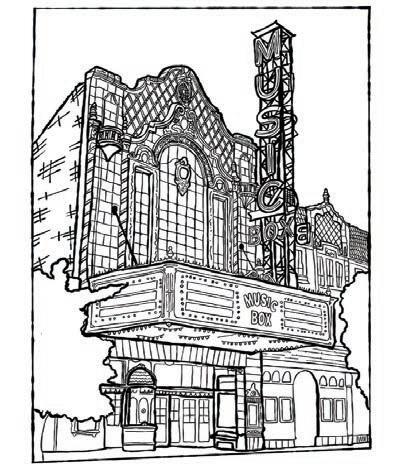
Proceeds will be split between the Reader and the more than 50 artists who contributed illustrations. $30 for PDF download $45 for limited edition printed book and PDF download Provide your name and mailing address and say this is for a coloring book on the memo line. Rachal Duggan Instagram:@RADillustrates • Website: rachalduggan.com 48 WhitneyWassonInstagram:@soberrabbit • Twitter:@boozetornado • Website:thewhitneywasson.com 22 ChicagoReaderColoringBook Or send checks to: Chicago Reader Suite 102 2930 S. Michigan Avenue Chicago, Illinois 60616 For copies of this book, either in PDF form or as a printed book, see: chicagoreader.com/coloringbook






















 By JEFF NICHOLS
By JEFF NICHOLS










































































 By MIKE SULA
By MIKE SULA

























 By KERRY REID
By KERRY REID





































































































































































































 —JAMIE LUDWIG
—JAMIE LUDWIG




 —JAMIE LUDWIG
—JAMIE LUDWIG



 By STEVE KRAKOW
By STEVE KRAKOW


























































